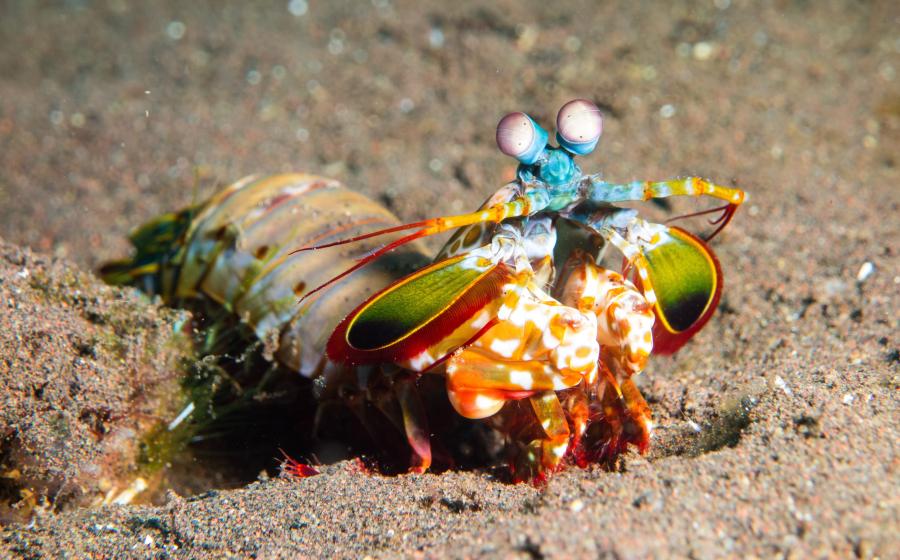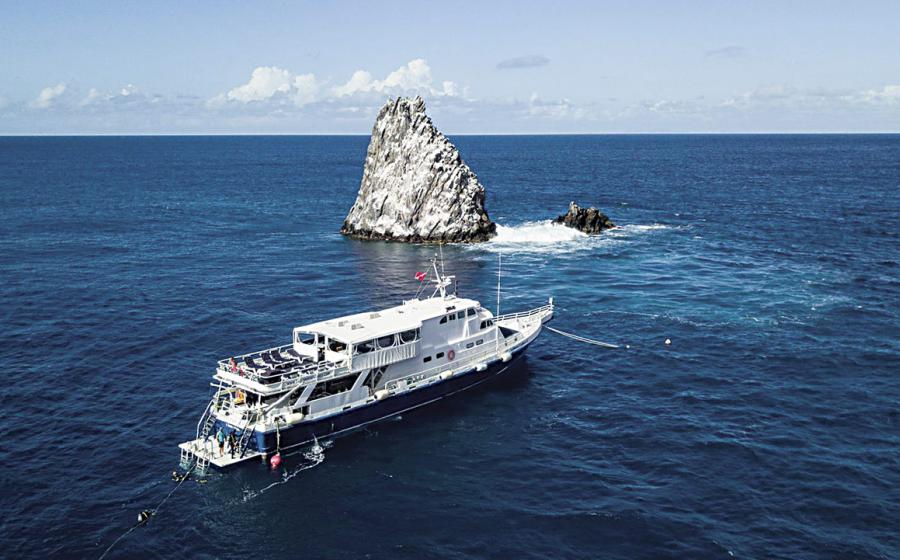Indonesia aboard North Sulawesi Aggressor and at Kungkungan Bay Resort
| Click here to see Stephen Frink's Indonesia Gallery Click here to see the Group Indonesia Gallery |
WaterHouse Tours, www.waterhousetours.com
Tour Leader, Stephen Frink, www.stephenfrink.com
Dates: September 27 - October 7, 2006

Indonesia is widely regarding as among the world's richest environments for marine biodiversity. Certainly, my past trips to Indonesia have been extraordinarily productive (see http://www.stephenfrink.com/sf-reports/200504wakatobi/ and http://www.stephenfrink.com/sf-reports/indonesia2002/ as two examples). Yet, there is one region of Indonesia that critter enthusiasts have long considered marquee value -- the Lembeh Straits.
Why Lembeh, when the reality is that at first glance it is a vast expanse of dark volcanic sand, dotted with detritus and trash and washed by water of marginal clarity? Oddly, enough, it is also home to wild variety of bizarre and colorful muck inhabitants that are simply not found elsewhere.
As cool as these kinds of creatures might be, I've always felt that a week of this kind of diving might be a bit much, for my wide-angle imperative anyway. So, when the Aggressor Fleet began operating a new live-aboard in the region in October 2005 combining the muck diving from Lembeh with the wider underwater vistas presented by cruising the islands off the north end of Sulawesi, I knew it was my kind of place.
Kungkungan Bay Resort

The North Sulawesi Aggressor operates an itinerary between Manado and Kungkungan Bay Resort (KBR), steaming either clockwise or anti-clockwise on alternate weeks around the north tip of the island. This makes an add-on at the resort very easy to accomplish, especially since the drive between the airport in Manado and KBR is only about 1 1/2 hours. Knowing how fatiguing long international travel can be, we opted to arrive 3 days before our Aggressor departure and book into KBR to get rid of a little jet-lag and to sample the best of Lembeh muck diving with the resort that put it on the map.
KBR operates kind of like a 17-room live-aboard with an emphasis entirely on diving the Lembeh Strait, the fairly narrow body of water separating the west coast of North Sulawesi and Lembeh Island. To that end, they have a wonderfully spacious camera room located near the dock, and here UW photographers can spread out for housing maintenance in a well ventilated and perhaps more importantly, well lighted workspace. They have either 110 or 220-volt charging stations, and a concrete floor with drains inviting access to equipment even when slightly wet.

The "mother-ship" consists of various tasteful accommodations made from local hardwoods, including beachfront bungalows and suites. There is a main house with restaurant and bar, as well as reference library and computer station. The beach is black-sand, the property beautifully landscaped with tropical foliage, and there is a fresh-water swimming pool. Massages ($12) are a big hit, and for those wishing to stay in touch, the resort is more-or-less wifi enabled. However the Manado-based server was down much of the time we were there, and when it did work it was rather slow. But given the remote location, to have Internet access at all is extraordinary. Plus, if it was too easy to do e-mail and stay in touch with work; it would have interfered with a very busy (and far more pleasurable) schedule of diving, downloading, and processing images. Which, after all, is why we were there.
The heart of the operation is the diving infrastructure; the Nitrox compressor, the twin-outboard dive skiffs, and most significantly, the dive guides. Never having dived this kind of terrain before, I assumed local knowledge was a good thing, but until I experienced the KBR style of muck diving, I did not really appreciate how absolutely beneficial these guides can be in terms of delivering the shot. Not only do they know the environment intimately, diving it every day like they do, and not only do they have apparently superhuman visual acuity to see the small things they are able to point out; but they have acquired practical knowledge about how and where these creatures live. This allows them to take their little metal rods and probe around in the sand until a wonderpuss octopus begins roaming before our macro ports, or to prolong an encounter with a mantis shrimp before it darts back into its hole. The resort assigns one guide to no more than four divers, and it is with a sense of pride that they deliver one after another rare and wonderful creature.
About the diving

Steve Coverdale, who with wife Miranda manages the resort, recommended we put our wide-angle lenses away while in residence; and with 20 to 40-foot visibility the norm I had to agree. Actually, some of the dive sites do have nice coral gardens, and if I were going to be at KBR for a week I'd make a point to cover them with a wide lens, but with the Aggressor trip coming up in 3 days, I figured I should concentrate on the small stuff that Lembeh is famous for. In fact, most of what I shot was with the 100-mm macro on my full-frame Canon EOS1DSMKII, but many of our other guests were shooting cameras like Nikon D2X and D200 with a 1.5 correction factor from their digital sensor, and they found their 60mm Micro-Nikkor (effectively a 90mm macro lens) was their go-to optic. The addition of an external diopter (I used a Seacam Wet Two) was a nice option when a very small creature like a pygmy seahorse was revealed.
A note on muck diving - www.aggressor.com has a nicely informative narrative on the art and science of muck diving, copied below:
The somewhat ambiguous & misleading term "muck diving" was coined in the North Sulawesi area of Indonesia. In all actuality "muck diving" is predominantly done on crushed coral & volcanic slopes in the 20-80 foot depth range.
The word "muck" conjures up, to uneducated divers, silt out conditions & a muddy substrate. This is typically not the case in North Sulawesi. The average visibility in the Lembeh Strait is 30' - 60' on good days & 20' - 40' on bad days. The poor visibility is due to the very thing that makes the strait the diving wonder that it is...tidal exchange and incoming & outgoing currents.
This extremely rich "nutritional environment" is precisely why the area supports such a diverse endemic species such as the hairy frog fish, juvenile dwarf pigmy sea horses, star gazers, cockatoo flounder, ghost pipefish, mimic octopus, blue ring octopus & flamboyant cuttlefish.
As noted above, the currents & tides are very active in the Lembeh Strait & tend to "funnel" in and out of the straits. This tidal action does not create any type of drift diving situation, but does deposit some litter & debris in the strait. To the ecologically minded diver, this debris (i.e., cans, buckets, bottles) can initially be somewhat disconcerting, however; there is a very positive side to this & one that actually works in symbiosis with the u/w environment.
The previously mentioned bottom terrain of slopes and crushed coral is totally absent of safe habitat for the animals simply due to the movement of the water in the strait. Consequently, the incoming debris creates underwater homes for the resident dwellers in the Lembeh Strait. The local dive guides will be able to educate & inform divers further on this.
Divers not familiar with "muck diving" conditions do need to observe & be aware of the following:
Only gloves with the fingertips removed are allowed on dives.
Be constantly aware of touching or sitting on the reef or "muck" as there are highly camouflaged animals everywhere. You will learn to see these animals as you spend more time in the area.
Do your part as a conscientious diver on the "muck" dives to help maintain the limited visibility.
- Don't move or disturb items on the bottom.
- Be very aware of over finning (use slow steady & short fin movements to prevent stirring up the sandy bottom).
- Always remain 2-3 feet above the "muck" & have total control of gauges & cameras that can stir up the bottom & disturb these delicate animals.
As animal are discovered, be courteous to all divers in the group. These animals are easy to photograph, as a rule, & will remain in the open as long as necessary.
A note on the local dive guides --- The local dive guides are highly trained to spot animals in the "muck" that would absolutely go unnoticed by the untrained eye. The guides use, at times, a probe to move items on the bottom and gently prod animals to move so they can be seen. This is something we ask that you do not do, and that you leave it to the local guides.
Water Temperature
When we visited there was a significant difference in the water temperature between the Lembeh side of the island, where the water was 78 degrees, and the Manado side where we had 84-degree water. I assume this temperature discrepancy is not necessarily as extreme year-round, but clearly different currents affect either side of the island, no doubt also explaining the vast differences in the underwater environments. I found that layering wetsuits, a 3mm Henderson Instadry wetsuit coupled with a 3/5 hooded vest worked really well for me under these conditions.
The House Reef

I was too jet-lagged and exhausted to make the first morning's boat dive. So, with a dive buddy and a guide (they don't let anyone dive without a buddy under any circumstance) I did the simple shore entry by the dock and dived a part of the house reef, this time exiting stage right. Immediately at the end of the pier was a cluster of banggai cardinalfish, (Pterapogon kaudemi) floating just above an anemone inhabited by orange clownfish. To see anything other than an anemonefish so near the tentacles of the anemone was surprising, but I found this to be common for this species in Lembeh. They also are found floating above plate corals that are visually very similar to anemones (I lost a bet on a bottle of wine to one of my friends when I claimed the environment in the photo was anemone and he correctly opined it was plate coral). Later in the week I saw them among the spines of a sea urchin, so I guess hanging out in sharp and toxic environments suits their lifestyle.
This was a productive dive for various species of pufferfish and pipefish. The backgrounds were more coral structure than I would find at some of the other predominantly black sand locales later in the week, so this was a great way to start the KBR adventure. Depth range was 10 to 40 feet for the areas I found most interesting. Later in the week I dived the house reef, stage left, and found quite a difference in terrain and critter. Staff told me that the House Reef is actually rarely dived by KBR guests, as they tend to board the dive boats for the 3 to 15-minute ride to the other presumably more exotic nearby sites. But the whole of that bay is a protected marine environment, and is accessible only to KBR guests. I found it both convenient and productive.
The map of the dive sites posted by the dock identifies 30 different sites. Truthfully, I was too debilitated by jet-lag those first few days to pay much attention to the name of the sites we dived, trusting that the dive staff knew far more about what was good and where than I did. Instead, I paid attention to the briefing so I could decide what critters to target. In terms of lenses, I found I could essentially choose between my 50mm macro or my 100mm macro, for almost all the critters described were small. No surprise really, for each night a flotilla of several hundred fishing boats work the waters of the strait, assuring anything larger than the mesh of a gill net is unlikely to survive outside the protected zone at KBR's personal bay. Lembeh is about the small stuff, undeniably.
I was only at KBR three days, and will be the first to admit I normally tend not to obsess over macro subjects. In fact, I can go six months without slipping my 100mm macro lens on my underwater camera, yet this trip it was almost constantly affixed. On the other hand Ned and Anna Deloach, of the "Reef Fish" ID books fame, will spend 2 months in Lembeh this year because they find such a wealth of unusual and rarely documented marine life. For the dedicated macro shooters of the world, this is a Mecca of obligatory pilgrimage.
Taken in this context, consider my vision of these waters the "Cliff's Notes" version, concentrating on the iconic and obvious rather than rare and sublime. Which is not to say I didn't shoot some pretty rare stuff, but I attribute that more to the talent of the dive guide, the wealth of the environment, and a little bit of luck. Among the creatures significant to me in the short time I was there:

Pinnate spadefish - Amazing for bizarre and beautiful shape, accented by orange trim along the black body
Anemonefish - The species I found most predominant were orange, skunk, pink, orange-finned, Clark's, spinecheek, false clown, and tomato anemonefish
Anthias - Many species, although not in Fiji or Maldives profusion
Barramundi - The juvenile of this species is particularly interesting
Hawkfish - Many species including the photogenic longnose, dwarf, and freckled
Sweetlips - Fairly common, but skittish. I figure any fish that fits easily into a frying pan should be cautious here.
Wrasse - Too many species to mention
Cardinalfish - I found the banggai to be the most interesting, but there must have been more than a dozen species of cardinalfish
Mandarinfish - There is a pretty nice mandarinfish dive scheduled daily for 5:00 PM. Not a large substrate actually, and a little deeper than some at about 50 feet. Our group had been on mandarinfish dives elsewhere in the world and was not overly impressed with this one, but if you're there and you need a mandarinfish opportunity, this can deliver.
Lizardfish - Every dive
Shrimpgoby - Exceedingly common, but nonetheless photographically challenging
Dragonet - Many species
Gobies and Blennies - Diverse and abundant

Frogfish and Scorpionfish - Take the whole "Odd-shaped bottom dwellers" chapter out of the Reef Fish ID book for the tropical Pacific and you've described the population of the sand slopes off Lembeh. I found that out pretty painfully while shooting a flamboyant cuttlefish on my first day. Concentrating on vertical compositions my left elbow was bouncing along the sand as a kind of monopod when I felt a sharp sting through my wetsuit. Looking down I saw a rather indignant devil scorpionfish roused from his ambush buried in the sand and having stung me in response. I put my elbow in hot water to break down the venom as soon as we got back to the dock, so the effects were rather minimal. But it does point out just how many small and camouflaged critters occupy what is at first glance a submarine desert. Of the numerous species of frogfish, the hairy variation seemed to cause the most excitement among the other divers; and while there were many species of scorpionfish, the weedy (Rhinopias frondosa) justified dedicated dives in pursuit.
Stargazer - Fairly common on many of the night dives to the sandy slope
Cowfish and puffer - Common
Lionfish - Common (but often on very nice backgrounds)
Pipefish and seahorse - The pygmy seahorses are guaranteed at several sites, and pipefish such as the ornate ghost are favorites of the dive guides
Eels - The ribbon eel is found frequently, male/female/juvenile
Shark - Not too likely, although some hammerheads are occasionally seen at a distance. I saw one reef shark the whole week, and he was way too far away for a photo.
Rays - Mostly blue-spotted stingray
Squid, cuttlefish, and octopus - Lembeh is very good for cephalopod sighting. The mimic octopus and wonderpuss are very special encounters, and highly prized photo opportunities. Cuttlefish are pretty common, but the smaller flamboyant cuttlefish has been kind of rare lately and when I came home with a nice series the dive guide seemed to be very proud to have delivered. I'd never shot either the flamboyant or the wonderpuss before, so these were prized additions to my critter portfolio.
A final note on KBR
I was really very impressed with the entire operation. They were very safety conscious, and kept the resort immaculately maintained. Some small issues were beyond their control, like the Internet server going down in Manado, but that which they could affect seemed to operate flawlessly. Or, at least if there were flaws, they kept them hidden from us. This is a very remote locale after all, but despite the considerable challenges they must face it is a terrific diver's resort. The Coverdales get a tip of the hat from our group for hospitality and professionalism, and the dive staff was truly amazing in terms of delivering the cryptic creatures of Lembeh. I almost didn't take the few extra days at KBR, figuring I would get enough to the macro stuff on the Aggressor, but now having done it I can't imagine any serious dive photographer would travel this far and not invest some time in a land based resort in Lembeh. The guides do these sites every day of their lives, and the benchmark of their performance (and level of gratuity) is the virtual invisibility of the creatures they are able to point out to their guests.
North Sulawesi Aggressor

We did the morning dives at KBR and then left for the several hour drive to Manado and the North Sulawesi Aggressor in the late afternoon. We hit rush hour in Manado, so the trip took longer than it would have had to, but KBR and the Aggressor work very closely together to make sure all guests' needs are met and comfort assured. That meant all our bags were safely transported, and they even provided bins for our already-assembled cameras so we did not have to break down our housings and repack. Even though they are totally separate businesses, the Aggressor Fleet and KBR are clearly symbiotic. I don't know which is the host anemone and which is the clownfish, but they each benefit from their close collaboration.
The vessel is a 110-foot dive yacht, most recently incarnated as the Truk Aggressor, and only operating as the North Sulawesi Aggressor since October 2005. With 7 double staterooms and a quad cabin, the maximum accommodation is 18 guests.
As we pulled into Manado I couldn't help be recall the last time I visited. It was September of 2001 and I had been invited to be a photo pro with the very first Digital Shootout by friends Dan Baldocci of Light and Motion and Berkley White of Backscatter. Of course, back then I really knew nothing about digital photography and the only thing I knew how to do on a computer was word processing. But, along with about 30 others I was there to learn something about this new thing called "digital photography". After all, maybe there was something to it, and if so I should possibly pay attention. I figured, what the heck, it might come in handy somewhere down the road.
Anyway, we got as far as Singapore and when we deplaned for the Manado connection there was a camera crew from the local news affiliate waiting to greet us. Bleary-eyed and disheveled from 16 hours in the air I had little patience for what I assumed to be their "Candid Camera" clone when they asked me what I, as an American, thought about the terrorists who flew jet airplanes into the World Trade Towers in New York.

We spent the week after 9/11 in Manado at a land-based dive resort learning about how to process and store digital images from Berkley, Dan, and James Watt. At night we'd watch the news back home, and by day we'd dive the Bunaken Marine Park. (Click here for a review of that week.) Dan gave me an Olympus 3040 in a Tetra housing to try, and while my serious images were shot that week with my trusty Nikonos RS, the immediacy of review on the digital camera was pretty impressive. In fact, I bought a Nikon D1X and Seacam housing right after I got home, and we all know how digital imaging has swept all forms of photography in those few short years. As for being in an essentially Muslim country like Indonesia as we were first beginning to learn that there were Islamic terrorists out to get Americans, we took comfort in knowing North Sulawesi is predominantly Christian, and quite peaceful. Gratefully, that's still the case and never did we have a moment's concern about geopolitical issues while here.
Now, five years later, we were back to Manado to dive, far more digitally enabled than that first trip. There were even two of our guests along this time whom I'd first met during that traumatic time together over 9/11, Dana Weber and Ann Bennett. They too were now shooting top-of-the-line digital systems ... Canon EOS1DSMKII and Nikon D2X in Seacam housings. All three of us had significantly evolved from our first digital experience with the Light and Motion Tetra housing for an Olympus 3040.
As would be expected of an Aggressor boat anywhere in the world, the North Sulawesi Aggressor is a lovely dive yacht crewed by experienced dive professionals. Captain Niall gave us a mercifully short briefing on the night of arrival, for while many of us had been on location long enough to acclimate, two of your guests had arrived just that afternoon and been transferred directly from Manado airport. Cabins were assigned, food served, and we retired semi-comatose to our cozy bunks.
Day One aboard Aggressor - Fukui, Mount Satu, Lekuau 2

The dive briefing and other important need-to-know information was disseminated that first morning, all cameras assembled, and soon we were ready for our first dive in the Bunaken Marine Park. Actually, I remembered Fukui from diving it in 2001, but visibility was much better according to my recollection.. Water clarity is variable anywhere, anytime; but being so close to Manado (it was a city of a million people back in 2001, and I figure the city must have grown significantly since then) the nutrients and debris of civilization had to affect the water. The coral was still in great shape, but visibility only 45 - 50 feet. That first dive was kind of disappointing, except for 5 in-a-row giant tridacna clams, pristine staghorn corals in the shallows, and a few nice clownfish set-ups. But, the checkout dive on most live-aboards is often marginal so I remained hopeful.
Unfortunately, the other two dives along Bunaken Marine Park that day, Mount Satu and Lekuau 2, reinforced my perception of water clarity issues. Also, there were bottles and plastic bags floating along the surface (and occasionally underwater) that were constant reminders of our proximity to a very large city. The biggest issue was that the marine life was pretty skittish here, probably owing to considerable fishing pressure. We did manage a very nice over/under series with a local outrigger boat that came to sell trinkets to the Aggressor guests, and I got lucky with a few pretty cooperative fish. Actually, Lekuau 2 was pretty nice, as a vertical wall nicely decorated with encrusting sponge, black coral, and large tube sponge along the precipice. With decent visibility, this could have been a very nice wide-angle opportunity, especially with the nice anthias concentrations along the shallows.
I fear divers the first day out of Manado will be a little concerned that the diving would not justify a trip this far. Trust me, or rather trust Aggressor Fleet, the diving gets much better after that first day as the itinerary progresses away from the metropolitan area. Water clarity improves along the north end of the island (although we never had really stellar visibility in the 80 to 100 foot range, 30 to 50 being more the norm) and the reefs and reef dwellers become far more fascinating and accessible.
Day 2 - Goldfish Bowl, Batu Mandi

The Aggressor formula is four dives during the day, and as the anchorage permits, the option of a night dive. For the 7:30 dive (cold breakfast of fruits and cereals before the first dive, hot breakfast after) we arrived at a site they call Goldfish Bowl, although I never quite figured out how it got the name. I figured there'd be large clouds of anthias, but instead the highlight of this site is acres of perfectly intact staghorn coral with myriad clownfish and anemone clusters tucked within. Once beyond the staghorn zone there were lots of other fascinating subjects ... cuttlefish, blue ribbon eels, more clownfish and anemone clusters (often with the mantle rolled up making for a more interesting composition). There was one especially cooperative lionfish here that allowed me to play with various shutter speeds on an upward angle as he sat along the side of a sponge. I figured these shots would make a good teaching tool later in terms of how foreground is determined by strobe power and strobe to subject distance, while background more depends on shutter speed to control ambient light.
The afternoon dives at Batu Mandi are very significant critter dives. Here is where they often (maybe 50% of the time) see blue-ring octopus, but I guess next week's guests will have a slam-dunk blue-ring experience on their four dives, because on our four dives we got blue-ring skunked.
The typical dive profile is to enter the water to the left of a large rock structure that just barely sticks out of the water. The rock itself is totally barren above the water line, but below it is a veritable oasis of crinoids, sponge, gorgonia fans, tunicates, and large seafans all punctuating a substrate cloaked in vibrant encrusting sponge. To hit this in 100-foot vis would be a wide-angle delight, but since that's not likely to happen; to hit this at any time, day or night, is a fish and macro shooter's wonderland.

Working along the slope of the large rock we came across several seafans that typically host pygmy seahorses. They either weren't in residence this day, or they escaped our normally eagle-eyed guides. However, I did manage a killer shot of a long-nosed hawkfish while the pygmy quest was delegated to the dive guide. Actually, they did find a species of pygmy a little farther along the reef, but as it was kind of brownish-bland in color and against an uninteresting background I was reluctant to invest the kind of bottom time serious pygmy shooting requires.
Other usual suspects for this dive include a diverse selection of nudibranch, frogfish, and numerous species of scorpionfish. In one frame I actually got three different devil scorpionfish, one buried down in the sand and two more sitting out in the open. Here I also got a nice series with a clown trigger, normally one of the more reclusive reef dwellers, but for a short time at dusk his hunting imperative seemed to overtake his innate caution and I was rewarded with a dozen or so shots as a result.
As good as the day dives were here, the night dive was positively inspiring. I can't say I got so many memorable shots actually, mostly of butterflyfish that I could not get close to during the day, but were far more accessible at night. But, the color of the encrusting sponge and soft corals along the rock face was astonishing. I recognized it as pretty interesting during the day, but to have the detail revealed to the concentrated beam of the dive light was very special indeed. After the dive, inflated BC positioning me on the slick calm surface of an 82-degree sea under a clear and starry night ... that was one of those memories that remind me why I dive.
Day 3 - Sahoang Satu, Batu Mandi

By now we are all the way to the north end of the island, and our first dive it to an offshore rock known as Sahoang Satu. I remembered this dive from my trip here in 2001, but for us based near Manado it was an all day affair to get in two dives. Here it was a simple matter to step off the mother ship onto the dive dinghies (all the diving we did off the Aggressor was off a pair of v-hull dive boats with twin outboards and tank racks) and drive 3 minutes to the site. The highlight of this dive can be wide-angle, with the rock faces cloaked with yellow soft corals, but we hit the site at slack tide (normally a good thing) but the soft corals had erectile dysfunction as a result. Still, the resident school of blue-lined snapper was interesting, as were the opal sweepers inhabiting the rock crevices. This is a dive that had great potential, and I was eager to revisit, but the winds kicked up and it was getting kind of sloppy for food service aboard the boat and getting back into the dive skiffs.
Kind of out of options for that region and that wind condition, we headed back to the protected bay at Batu Mandi. While the terrain was familiar from the day before, the critters were different ... a pair of leafish together on the staghorn, anthias close-ups, a squat lobster on a whip coral ... any dive here will provide fascinating options for a photo enthusiast equipped with a fish or macro lens.

Day 4 - Lembeh (TK2, Hairball, Jahir)
We rounded the north end of the island last night and entered the Lembeh Strait. The wind is still pretty significant, but it does not affect us at anchor. It does however affect which sites we can dive and the coast of Lembeh Island is more exposed, rougher for the dive skiffs and probably too bumpy for the big boat to comfortably sit. As a result we are limited to sites along North Sulawesi, waiting for the time they say happens in October when "the switch turns off" and the winds die. It was slick calm on the Manado side of the island, and really pretty nice when we were at KBR, but these past couple of days have been breezy. In all, we had only one day of overcast, and when you are shooting subjects 3 inches long that hardly matters. I doubt anyone is complaining about the weather, but still, the boat ride back to the mother ship would be more comfortable (and dry) if the stinkin' wind would drop off.
In Lembeh the Aggressor dive protocol is to choose two sites for the morning and two for the afternoon and rotate the dive skiffs between them. This minimizes the size of the group on each site, and assures that if a significant photo opportunity appears, there is not a frenzy of frustrated photographers waiting their turn.
A note on Lembeh photo etiquette

When we run our photo tours we usually operate under the premise that a shooter finds a subject, and it is theirs until they voluntarily relinquish it to another shooter. This has worked well, and our groups have been wonderfully cooperative, even to the point of swimming after another guest, showing them a particularly unusual critter on their digital camera screen, and swimming them back to the site. But here the critters are more isolated and guide-dependant. The proper procedure is to shoot as necessary, but more sparingly. This is no doubt better for the creature, and more considerate for those who may photograph it later. Following the shot, use buoyancy control to gently lift off the sand, thereby leaving the subject intact for the next shooter. (Any shooter who is overweighted, clumsy, and inconsiderate enough to leave a cloud of sand in their wake will not be popular on these kinds of imaging opportunities.) If it is a particularly sensitive subject like a pygmy seahorse, even greater restraint must be exercised.
At TK2 we found a pair of ghost pipefish almost immediately after dropping into the water. The one next to the crinoid was well camouflaged, but another larger version was out in the open. Verticals, horizontals, Wet Two diopter shots of the eyeball and we were off to the next photo-op. More hairy frogfish, this time two in one frame, with another juvenile just 5 feet away. In the shallows I found a school of catfish, much larger fish than I had seen previously, and they offered a pretty significant composition. Other interesting set-ups were banggai cardinalfish, this time tucked into the spines of an anemone and a school of jacks raping the sand substrate for small crustaceans and fish. Hairball was more hairy scorpionfish and other assorted macro critters, but not the rhinopias that is normally in residence. So far that one has eluded me this trip. And finally at JAHIR (named for the first initial of the 5 dive guides who discovered the site) the visibility turned absolutely dreadful, yet the dive still rendered nice encounters with a baby painted frogfish, juvenile sweetlips, various dragonets, and several varieties of pufferfish. {mospagebreak}
| Click here to see Stephen Frink's Indonesia Gallery Click here to see the Group Indonesia Gallery |
A note on the North Sulawesi Aggressor

It came as no surprise that this vessel operated at a very high level of professionalism. It is what I've come to expect from Aggressor Fleet, but their dedication to guest services was very much appreciated by our group. Ours is a rather intense group of underwater photographers, but I presume most who venture this far share a similar imperative. The boat is nicely set-up with charging stations and comfortable lounge areas in the main salon ideally suited to editing from our laptops. The membrane system delivered consistent 32% Nitrox, and the twin-outboard skiffs were actually more convenient than diving from the mother ship might have been in these waters. Plus, by having two skiffs available, we had the option of all diving one site, or splitting the group. Since most of the critter dives are better with smaller groups, we tended to send each boat off to a different location, although each were generally less than a 5 minute run from the Aggressor. The cabins were spacious and well appointed, and the food prepared by Chef/Photo Pro Alan was stellar indeed. Of all the positives aboard, a tip of the hat has to go to the dive guides for their diligence and damn good eyes.
Day 5 - Nudi Retreat
Captain Niall was beginning to take pity on those of us suffering wide-angle withdrawal and suggested a special site on the Lembeh side of the strait, Angel's Window. But the winds continued to conspire against us by keeping the water churned up, so even if the soft corals and swim-through were generally inspiring, not this day. Which turned out to be just as well, because we had a terrific dive at Nudi Retreat.

Here we tied up to the rock face of the island and dropped into a sloping sand reef rimmed by coral and sponge encrusted rock buttresses. We were briefed to expect to see the Pegasus sea moth, and sure enough that was the very first thing we saw just under the boat in 18 feet of water. Likewise true to the briefing, there were pygmy seahorses on a sea fan at 60 feet. This was really quite a special site, for it combined the black sand environment with a lush coral wall. A casual walk-about of the main salon after two dives at Nudi Retreat revealed laptops rich with octopi, filefish, clownfish, sea moths, pygmies, catfish, and a brilliant crimson clam with a mantle that curiously pulsated a band of white light.
Actually, everyone was pretty well blown away by this dive. Between the pygmies at 60 feet, the clown frogfish at 30 feet, and all the other unusual critters in between I dived this site 3 times this day. The second two dives started out with a pygmy photo-op on the 60-foot sea fan.

I knew exactly where the fan was from watching the line of shooters from above on the first dive, so I hurried to the fan on the second dive and essentially wasted 7 minutes of bottom time searching for the pygmy. I wear reading glasses, but can see things in the distance just fine, which allows me to pick out most subjects from far away. And, then when I put my Seacam S180 viewfinder to my eye, I have the internal diopter corrected for my vision so all is brilliantly sharp. But, with these pygmies are so very tiny, and so well camouflaged it takes pretty good eyes to pick them out from among the knobby polyps that they so nearly resemble. Fortunately, by the third dive I had a system worked out with my dive guide. He would use the small tip of a dental tool to give me a focus reference nearby the seahorse, never touching or harassing the seahorse in any way, but giving me something other than a field of red texture to focus on. Once I was locked in he would move away and I would watch the scene until the seahorse would randomly move back facing me. As the bottom-time clock ticked away I didn't dare glance at my dive computer or my camera's histogram for fear of losing sight of my subject. But, after a dozen or so shots (Canon EOS1DsMKII, full frame digital, at 1:1 with Seacam Wet Two external diopter bringing the magnification to nearly twice lifesize) I was pretty sure I'd nailed at least one and was able to move up the wall the shallower depths and move on to more leisurely photographic pursuits.
A note on pygmy seahorse photography
These are one of the iconic subjects in this region, and the guides at both KBR and aboard Aggressor are very skilled in finding and pointing out. However, as with all marine creatures, some are larger than others, and when working at the extreme edge of the magnification possible by a specific macro rig, every little bit helps. A slightly larger specimen, like we found the next day at Nudi Falls is a bit easier, and of course if you're really lucky, finding multiple seahorses to occupy the same frame is better still. Even then, a little judicious cropping may help to fill the frame. With these guys, 1:1 magnification just may not be enough, and some form of diopter of teleconverter may be advisable.
Day 6 - Nudi Falls and Critter Hunt

This is our last day of charter aboard the Aggressor, and we are anchored just offshore of KBR. With our flight in the early afternoon tomorrow we are limited to just two dives this morning. The first is to Nudi Falls, like most about a 3-minute boat ride from the mother ship. We are briefed to expect to find a sea fan with Hippocampus at 54-feet, and sure enough, there it was. Because it was so close to a sand and rubble bottom, this was an easier place to lay on the bottom without impacting any coral and brace an elbow to get steady for the macro shots. However, this dive was about far more than just the seahorse, and the mini-wall is incredibly rich with medium and small size critters. Among my more productive subjects were cleaner shrimp on a clownfish and anemone habitat and various lionfish and pufferfish. But, there was so much to shoot this dive I found myself rounding out the portfolio of images from the week. I'm sure the subjects I concentrated on this last day would be different than those I might have shot earlier in the week, but Nudi Falls offered excellent variety and a nice change from the black sand backgrounds.
Critter Hunt was much the same for me in terms of wrapping a few subjects that had eluded me earlier. While some of the guests dropped to the 60-foot range with the guides to look for Rhinopias, I found a cooperative juvenile sweetlips in only 20-feet of water. Their swimming pattern is so very erratic it takes a lot of shots to get them sharp and properly composed, and I'd had difficulty earlier trying to photograph different juvies. This one I nailed. As the clock ticked down to 60 minutes on my last dive of the trip I found a large cluster of long-spined sea urchins, and hiding in their midst was a school of banngai cardinalfish. I found it ironic that the first shutter click at KBR was this fish, and now 10 days later I've finished my underwater shoot with a final shutter click on the same species of fish.
The last afternoon

Very near the boat's anchorage there is a local gentleman who has developed an interest is collecting indigenous animals from North Sulawesi, It is not a zoo, as he is clear to point out, but his personal collection of creatures caged at his home. However, Aggressor guests are welcome there, and several of us did the tour. He had sea eagles and bats in his aviary, as well as cobras, a massive python, various monkeys, crocodiles, and a very strange wart hog kind of creature found in the island's wilderness. The highlight, photographically, was the close encounters with the taursius monkey, which they claim to be the world's smallest primate. At about the size of a softball, it was tiny and very cute indeed, but I'll leave it to some zoologist more knowledgeable than me to say whether this is without doubt the world's smallest.
On the way, LAX to Manado, we ran into photographer Marty Snyderman and on the way home via Singapore chatted with pro cinematographer Chuck Nicklin. I heard Tony Wu from Fins Magazine was there at the same time too. I think this probably isn't so unusual ... that most serious shooters find their way to North Sulawesi sooner or later. But, on the other hand I know a nonphotographer who dived the area with his photo-intense wife and found black sand muck diving most boring dive holiday he'd ever taken. Clearly, the attractions are not for everyone, but for those who appreciate the unique environment and its special denizens, this is an absolutely world-class destination.
Travel Miscellany
For those wishing complete Indonesia health advisory, please see:
http://www.cdc.gov/travel/seasia.htm
The State Department's travel advisory to Indonesia is at:
http://travel.state.gov/travel/cis_pa_tw/tw/tw_918.html
To research travel and dive specifics at KBR, visit:
http://www.divekbr.com/faqtext.html
Water Temperature - Among other info posted there is water temperature at 76-82 degrees. For me that means a 3mm suit and hooded vest. Others may prefer a 3/5/3 suit for multiple dives per day.
Health Care Imperatives
from www.aggressor.com

We have a first aid kit on board, including oxygen and a defibrillator. You may want to bring motion sickness medicine if you feel you'll need it. However, because of the size, comfort & stability of the North Sulawesi Aggressor, we have never had a serious problem. We also recommend an antibiotic, antihistamine, eardrops, & topical ointment.
North Sulawesi is not known to have any high incidence of malaria. However, check with your local travel med clinic just to be on the safe side.
If you are subject to reactions from stings of any kind, we recommend that you bring any medications that you may need. Please inform the captain and crew about your condition so proper steps may be taken in the case of an allergic reaction or stings. Please inform your dive guide(s) if you are taking any medication or suffer from allergies. A complete physical is recommended before your trip. There is no smoking allowed inside the vessel or the dive deck. Smoking is only permitted on the sun deck. The nearest recompression chamber is in Manado. This facility has a fully operational recompression Chamber; a blessing for Indonesia live-aboards.
Be sure your tetanus & Hepatitis A immunizations are up to snuff. Check with your local MD.
International health certificates for smallpox and cholera is not required, except from travelers arriving from infected areas.
Malaria? - Based on this information, I did not take malaria medication for this trip. However, you will make your own informed decisions in this regard, preferably after speaking with your physician. For me, when in malaria-prone regions, malarone (www.malarone.com) is my preferred medicine as it has no side effects that mimic or mask decompression symptoms.
Upon arrival in Indonesia you will obtain "visa on arrival" processed at gate of entry. YOU MUST HAVE A PASSPORT WITH AT LEAST 6 MONTHS REMAINING VALIDITY. GO LOOK AT YOUR PASSPORT NOW! I say this because I, and others who travel with us, have been bitten in butt by having less than 6 months on passport. It can be very expensive to correct, and with a live-aboard, you could miss the trip entirely. The visa will cost $25.
North Sulaweisi Aggressor

While the North Sulaweisi Aggressor is configured to accept 18 guests, this requires the use of one cabin as a quad. Recognizing that our guests prefer double occupancy cabins, and also because many of the cryptic creatures we'll be stalking are more accessible to smaller groups of UW photo enthusiasts, ours was a Limited Participation Tour for just 16 guests.
The information below is available at www.aggressor.com:
North Sulawesi Aggressor - Know Before You Go
**Contact Information
Office Hours:**
Mon-Wed, Fri: 8-7 CST
Thurs: 9-7
Sat: 9-1
Sun: closed
Office (USA):
+1-985-385-2628
[email protected]
www.aggressor.com
Cell Phone:
After Hours +1-985-714-1300
(emergency or delay in travel only)
North Sulawesi Aggressor Office (Hawaii)
Phone: 1-800-344-5662 or 1-808-329-8182
E-mail: [email protected]
Fax: 1-808-329-2628
M/V North Sulawesi Aggressor:
Boat E-mail: [email protected] or [email protected]
Boat Cell: 011-628-135-6022362 or 011-680-488-1755/2009
Sat Phone: 011-881-621-443-437
Fax: 011-680-488-5245
KBR Resort: 011- 62-431-823-444
Communications In North Sulawesi
The Aggressor Fleet Limited office and the North Sulawesi Aggressor is in constant communication. In the event of an emergency, family and friends may contact you at the above numbers. If you need to reach the vessel, please call or e-mail the boat. There is an onboard satellite phone for incoming and outgoing satellite phone calls and e-mail. There is a charge for this service. Prepaid e-mail cards are available for purchase onboard.
To ensure the timely arrival of your luggage into North Sulawesi, we recommend re-checking it at the ticket counter before your international departure to North Sulawesi. Don't forget to use your Aggressor luggage tags. They will help the crew identify your luggage.
Passports & Documentation
Visitors must have a current passport valid for at least six months prior to departure date, adequate funds to support themselves and a return airline ticket. Visitors must also have a blank page for the Indonesian visa to be stamped upon arrival. It is the travelers' responsibility to ensure that you have the proper documentation to travel to the destination and return to their country. Please check with the appropriate consulate to ensure you have the proper documentation. Always check your passport and visa requirements. Please note: Any stay longer than 30 days; regardless of country of origin must apply for a permit from their local Indonesian consulate. Aggressor Fleet Ltd. cannot assume responsibility for passengers not having correct documentation.

Taxes And Fees
U.S. Citizens are required to obtain an entry Visa upon arrival at a cost of $25.00 USD and $10.00 USD upon departure. A $100.00 per person fuel surcharge will be collected on board at the end of the charter. This fee may be charged to your credit card. The airport departure tax is $20 upon departure.
C-Cards & Dive The World Club
Please bring your c-card or proof of certification. The divemaster requires proof of certification before the first dive.
If you are a member of Aggressor Fleet's Dive the World Club, you will receive on board discounts. Your membership is indicated on the Captain's rooming list.
Waiver & Application
Aggressor Fleet, Ltd. and the North Sulawesi Aggressor require each guest to complete and sign an application and waiver form prior to departure and diving. The completed and signed Application/Liability Waiver must be received by the Aggressor Fleet, Limited at least 60 days prior to departure. Passengers who fail to fax or mail it will be denied boarding Due to Indonesian law, the North Sulawesi Aggressor has to obtain a clearance to cruise Indonesian waters prior to your arrival. If they don't receive your passport information on the Aggressor Application/Liability Waiver 30 days prior to the departure date, you could be denied boarding upon arrival to the boat. If you did not receive a waiver from your agent, please download one from www.aggressor.com, and fax it to 985-384- 0817.
Insurance
Every effort is made to ensure you have a safe trip However, unforeseen circumstances can and do happen. We strongly recommend the purchase of trip cancellation insurance as well as accidental, medical, and baggage insurance. We recommend Divers Alert Network (DAN) Insurance or an equivalent insurance.
Health
We have a complete first aid kit on board, including oxygen. You may want to bring motion sickness medicine, if you feel you'll need it. Please inform the dive guide(s) if you are taking any medication or suffer from allergies. We recommend a complete physical before your trip.
There is no smoking allowed inside the vessel or on the dive deck. Smoking is only permitted on the sun deck. The nearest recompression chamber is in Manado. This facility is fully operational.
Packing
When packing, please limit the weight and size of your bags. For international travel, you are usually allowed 2 bags. Please check with your domestic and international carrier for baggage allowance.
If possible, we recommend you pack a regulator, mask, fins, swimsuit, change of clothes, medication and toiletries in your carry-on bag. Having these few items with you can make an unexpected luggage delay more bearable. Also, if you are taking camera equipment, we suggest you hand carry it on to the plane.
Arrival

The North Sulawesi Aggressor offers charters departing from the Kungkungan Bay Resort in the city of Bitung, Indonesia. You are encouraged to arrive Saturday afternoon into Manado on Silk Air that arrives into Manado at approximately 12:55pm. Upon arrival, a staff member from the Kungkungan Bay Resort holding a sign with the Aggressor Fleet logo will greet you. You will be transferred to the KBR in an air- conditioned bus. The bus ride takes approximately 45- 60 minutes.
If you arrive earlier in the week and are staying at a hotel in Manado, you will need to make your way to the Manado Airport. Transfers from the Manado Airport will leave on Saturday at approximately 1:30 pm after the guests traveling on Silk Air arrive. We will need to know one week before your charter date if you will be meeting the group at the airport in Manado. This will be the only transfer provided for the upcoming charter week on the North Sulawesi Aggressor.
If you are staying in Bitung at the Kungkungan Bay Resort, you will require no transfer as the North Sulawesi Aggressor docks right off of KBR. Boarding time for everyone is 3:00 pm on Saturday.
The Vessel
The North Sulawesi Aggressor is a 110-foot yacht, built and powered for comfort, safety and stability and built to U.S. Coast Guard certification standards. She is diesel-powered, cruises at 10 knots and has 110-volt power on board. The North Sulawesi Aggressor has a beautiful spacious salon, 50 feet of sun deck with shading, chaise lounges, hot tub, deck chairs, bar, grill, and a complete digital photo/video center.
Accommodations include eight private, air-conditioned cabins. There are seven double cabins and one "quad" cabin for four guests. Each stateroom has extra storage and individual climate controls. The North Sulawesi Aggressor sleeps 18 guests and six crew, in privacy and comfort. Diving amenities include Nitrox and a large dive deck complete with individual dive lockers and freshwater showers.
Meals
The menu on board is varied and plentiful, with a variety of American feasts, barbecues and local cuisine. Wake up to fresh fruits, hot entrees, cereals and juices. Lunches are buffet-style, featuring hot soups, homemade breads, salads and sandwiches and/or entrees. Dinners are diverse, including seafood, beef or chicken. Each evening, enjoy fresh homemade desserts. Please notify our office of special dietary requests. Feel free to bring your favorite candy or snack.
FAQs:

1. Where is North Sulawesi? North Sulawesi is in the northern most part of central Indonesia. It is just south of the Philippines in the North Pacific Ocean.
2. What is included in the charter? Accommodations aboard the vessel, diving, compressed air tanks, weights and weight belts, airport transfers from the Manado Airport on day of arrival and departure, meals and snacks, soft beverages, local beer and wine are include in the charter rate.
3. How many days is the charter and how many dives can I make? The North Sulaweisi Aggressor charter is seven days, Saturday afternoon to Saturday morning with five and one-half days of diving. Most guests make up to 5 dives a day. Diving begins on Sunday morning and finishes midday on Friday when the Aggressor return to the dock.
4. When should I arrive in North Sulawesi? You should plan to arrive in Manado on the day of your charter, Saturday.
5. Do I need a passport? Guests are encouraged to arrive Saturday afternoon into Manado on the Silk Air flight that arrives into Manado at 12:55pm. Upon arrival, a staff member from the Kungkungan Bay Resort holding a sign with the Aggressor Fleet logo will greet you. You will be transferred to the KBR in an air-conditioned bus. The bus ride takes approximately 45-60 minutes.
6. How do I meet the North Sulawesi Aggressor on the day of departure? Guests are encouraged to arrive Saturday afternoon into Manado on the Silk Air flight that arrives into Manado at 12:55pm. Upon arrival, a staff member from the Kungkungan Bay Resort holding a sign with the Aggressor Fleet logo will greet you. You will be transferred to the KBR in an air-conditioned bus. The bus ride takes approximately 45-60 minutes.
7. Where does the North Sulawesi Aggressor dock? The North Sulawesi Aggressor offers charters departing from the Kungkungan Bay Resort in the city of Bitung, Indonesia.
8. What is special about the diving in the North Sulawesi? The Lembeh Strait and surrounding areas are believed to offer the world's most divers marine biodiversity. The outer reefs are adorned with colorful soft corals and anthias. North Sulawesi is world-famous for its "muck" dives, or critter dives, where small, colorful creatures dwell on sandy bottoms. Despite the term "muck diving," visibility is very good.
9. What is the water temperature? Will I need a wet suit? You'll be diving in warm water that averages 78 - 82F degrees. Most divers are comfortable in a 3mm suit.
10. What is the best time of year for diving? The diving is very good year round. Wet Season in Indonesia is from November through February however; it is less changeable in Lembeh Strait due to the mountainous terrain surrounding the area.
11. What type of topography can I expect to see in North Sulawesi? The topography ranges from volcanic mountains to coconut plantains to rice paddies. The islands also have numerous scenic waterfalls and lush rain forests.
12. Is there dinghy diving? Most of the dives are made from two large skiffs. Some diving is done from the back deck of the Aggressor.
13. Is there night diving? Yes. The night diving is terrific.

14. Are extended tours offered in Bitung? Special tours include a full day trip to Tangkoko Batuangus Nature Reserve and are home to the Taursius Monkey, the world's smallest primate, the black tailless monkies, Maleo birds, wild pigs, the Bear Cascus (Marsupial family), the Sulawesi Rousette and the Dog Faced bats and a multitude of parrots. These are trips into nature and the past not to be missed. There is also white water rafting trips for those with an adventurous soul that can't get enough of the water. Of course, there are numerous fantastic shore dives from the KBR right outside your bungalow. Also available is the tour of Bitung City and the open market. This trip will give you a real taste of Indonesian culture and close encounter with the friendly citizens. The open-air market presents a great chance for unique photo opportunities.
15. Clothing on board - Bathing suits & t-shirts are the order of the day. Dress is normally informal in Indonesia due to the warm, humid climate & clothing of light fabrics are recommended. Traveling in highland areas is noticably cooler so we recommend a lightweight jacket. Accepted attire for men is a shirt & long pants. For ladies, dresses, blouses, & long pants are appropriate. Shorts, halters or tank tops should only be worn on the beach. The temperature averages in the mid 80's during the day & mid 70's at night. For easy luggage storage you should pack in a soft duffel bag.
16. INDONESIA DIVING PROCEDURES (for KBR and North Sulawesi Aggressor) - The crew of the North Sulawesi Aggressor, with their unique combination of talents, offers the ultimate in service. While on board, you may pick a buddy of your choice or dive with one of our crewmembers. There is ample storage space for your diving equipment in your personal locker. The North Sulawesi Aggressor provides 80 or 63 cubic ft. tanks, weight belts & weights. The maximum recreational depth is 110 feet. Diving is done from two comfortable custom-made high-speed skiffs.
17. ELECTRICITY LIVEABOARD - Power supply is usually 220 volt/50 cycles in large cities, but 110 volts is still used in some areas including on board the North Sulawesi Aggressor. Normal outlets are plugs with two rounded pins. It is advisable to check electrical devices before using to ensure that they can accept the power supply prior to using to avoid damage to your equipment.
Photography
From time-to-time I will have written articles that are highly relevant to the destination we are going to be photographing. In this case, with the small creatures of North Sulawesi, you might find the following of interest:
Capturing the Cryptic
Revealing the Hidden Beauty of the Coral Reef
Text and Photography by Stephen Frink

Many of the residents of underwater world are highly camouflaged. Obviously, their ability to blend into their surroundings protects them from predators, and facilitates their own efficiency as ambush predators. Some of these creatures are very small, and therefore difficult to discern, but some are just darn good at mimicking their backgrounds. Here are some tips about finding these creatures, and effectively capturing them on media once revealed.
- Listen to the Dive Briefing - I don't mean listen to them about which way the current is running, or whether you should keep the wall on your right or left. Those are stellar concepts to heed should you want to get safely back to the boat. But in terms of a photographic quest, the dive briefing will also probably communicate what creatures are likely to be found where. The local dive staff is an incredible resource when deciding what to shoot, and therefore gearing up photographically for the dive, and actually finding the subject once underwater. They dive these reefs every day, and they have been reinforced in either an altruistic or financial way for pointing out the best photo-ops on the reef.
Pay attention to where they say things might be, or better yet, dive with them and let them show you. I'm not sure I'd have a frogfish photo yet, without some divemaster somewhere showing me where they live. Once they point them out, I always think "Duh ... I could have found that", although the reality is I would have probably swum right by chasing something bigger. Then there are the pygmy seahorses, that are so small that even when they are pointed out I have to squint and think to myself "How the heck did anyone ever find these things even exist to begin with!?" Amid the color and distraction of the tropical coral reef, the small and fascinating things are often overlooked, and we should be tremendously appreciative of those with local knowledge who are willing to share.
 |
- Understand the Habitat - More often you have to "saddle your own broncs", my Louis L'Amour colloquialism for taking responsibility and finding your own subjects to shoot. To do so requires some knowledge of marine life behavior and where things live. Photographers like Roger Steene and Paul Humann have encyclopedic knowledge the specific environments that might host specific critters. They will look in the sand for flame dartfish or shrimp/goby combos. They'll look in the anus of a sea cucumber for a particular fish that might live there. They'll know where the cleaning stations are and realize they can capture behaviors there that might be significant on film. They'll see a tiny tunnel in the sand bottom and realize if they wait long enough a yellowhead jawfish will likely emerge. Their education and long experience in marine life biology gives them a huge advantage in knowing where to locate things to photograph, and their photographic skill will bring these compositions to life. Their portfolios of the bizarre and unusual creatures of the coral reef are quite inspirational; particularly when you consider the massive time commitment, the sheer hours underwater that are necessary to accumulate such an archive.
The cryptic creatures require an even more intimate understanding of their habits and environment, because they are not obvious at a glance. A branch of soft coral may host a coral crab, but it so closely mimics the sclerites embedded in the tissue mass, until one actually moves they are virtually invisible. With understanding of the habitat and the creatures that live there comes the discipline to wait and watch, knowing something unusual may just be revealed. Or not.

* Enhance Your Vision - It probably goes without saying, but unless you can see well underwater, the small and visually confusing creatures of the reef will remain hidden. For young 20/20 eyes, maybe no enhancement is necessary, but for the rest of us a prescription facemask, or at least a set of adhesive close-up diopters in the corner of the mask will help. For me, I can see well in the distance, but wear reading glasses topside. That same optical correction, or greater, is useful when I am scouring that soft coral branch to find the camouflaged subjects. It is also very useful when reading the small type on the menu of my digital SLR! Note also that adding some light to the subject (either by means of a built-in model light like on the Ikelite DS125 strobe, or an external spotting light) can be an extremely useful visual aid.
- Choose the Right Optical Tool - The cryptic subject is often small, skittish, or both. To that end it helps to have a lens that will fill the frame with the subject from a distance, without intruding into the animal's "field of flight". In the old Nikonos days, not so long ago really, most of the cryptic macro subjects recorded were pretty inanimate. After all, it would take something devoid of mobility to allow it to be framed by the wands of a 1:1 extension tube. The 105mm Micro-Nikkor then emerged as the "go-to" lens for this task because it allowed full life-size (1:1) macro from 12.2 inches away. That meant you could get a tight headshot of a crocodilefish from 3 feet away, and then move in to a foot away and focus on just the eye. These continuously focusing macro telephotos are so very efficient that they are justification enough for using a housed single lens reflex camera, either film or digital, for underwater imaging.
To get even tighter requires the use of some supermacro tool like Seacam's new Wet Two external diopter, www.seacamusa.com, which has the advantage of being able to be added or removed from the port underwater. Alternatively, you could use a threaded diopter added directly to the lens inside the housing. Of course, with that solution you would be forced to shoot 1:1 or greater magnifications for the entire dive, but if the entire dive is going to be devoted to capturing an ultra-small critter like a pygmy seahorse, this is a fine solution.

* Use Negative Space to Enhance Composition - These cryptics are typically difficult to discern from their backgrounds, after all, that's what they do for a living. Arranging the composition so that the subject is in sharp focus and the background goes soft, or perhaps shooting at a hard upward angle to separate the subject from the background might be the viable solution to "show at a glance" the animal. Of course, maybe the point of the photo is to show the effective camouflage of the subject, in which case visual confusion works favorably. But, how many times can you really stop in the middle of a slide show and say "Here's a picture of a stonefish, you can't see it, but trust me that it's there and this is a really good picture of it!"
- Avoid the Photo Frenzy - While this may not directly related to "capturing the cryptic", it is inevitable that as you swim by a photographer photographing something indiscernible (but obviously interesting); there will be temptation to swim closer, look over their shoulder, belch a few bubbles, stir up a bit of sand, or worse yet, bump the photographer out of the way once you "discover" the fascinating little creature you just can't live without photographing. Don't. All of the above is very bad form, tacky and counterproductive.
The way I see it, the photographer owns the subject until willingly abdicated. Of course, the photographer should likewise have sensitivity about flashing the strobe too many times in a row if the creature seems sensitive to this intrusion. And the photographer should be aware of another shooter waiting patiently in the distance and may choose to invite that shooter to share the discovery. But, while the photographer is in the zone, concentrating on the composition or working the tiny depth of field that supermacro demands, any distraction is to be avoided. Unless there is a white shark ready to bite my butt, I don't want to have to take my eye from the viewfinder. Is that too much to ask?
|| |---|
| Click here to see Stephen Frink's Indonesia Gallery Click here to see the Group Indonesia Gallery |WaterHouse Tours, www.waterhousetours.com
Tour Leader, Stephen Frink, www.stephenfrink.com
Dates: September 27 - October 7, 2006
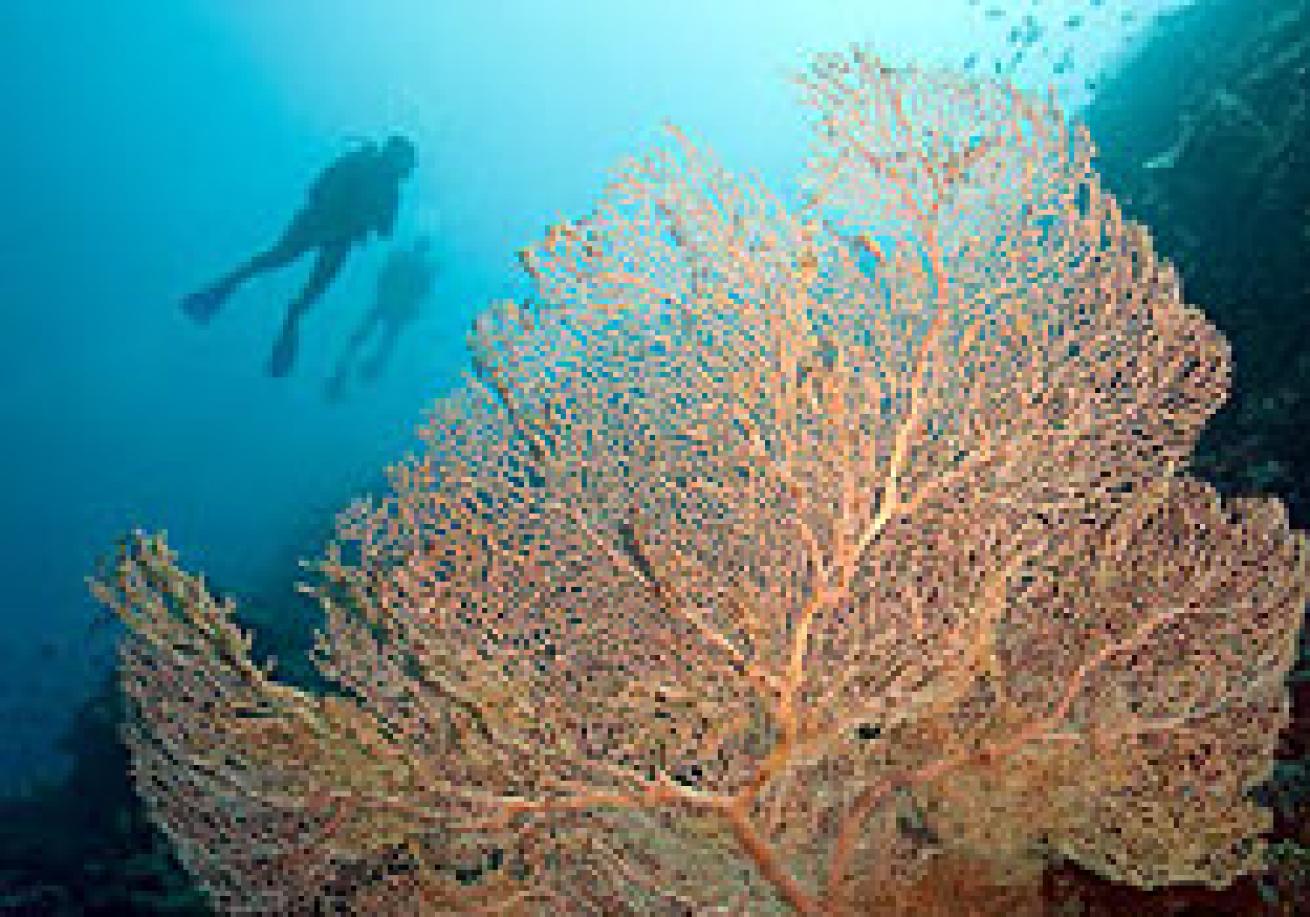
Indonesia is widely regarding as among the world's richest environments for marine biodiversity. Certainly, my past trips to Indonesia have been extraordinarily productive (see http://www.stephenfrink.com/sf-reports/200504wakatobi/ and http://www.stephenfrink.com/sf-reports/indonesia2002/ as two examples). Yet, there is one region of Indonesia that critter enthusiasts have long considered marquee value -- the Lembeh Straits.
Why Lembeh, when the reality is that at first glance it is a vast expanse of dark volcanic sand, dotted with detritus and trash and washed by water of marginal clarity? Oddly, enough, it is also home to wild variety of bizarre and colorful muck inhabitants that are simply not found elsewhere.
As cool as these kinds of creatures might be, I've always felt that a week of this kind of diving might be a bit much, for my wide-angle imperative anyway. So, when the Aggressor Fleet began operating a new live-aboard in the region in October 2005 combining the muck diving from Lembeh with the wider underwater vistas presented by cruising the islands off the north end of Sulawesi, I knew it was my kind of place.
Kungkungan Bay Resort
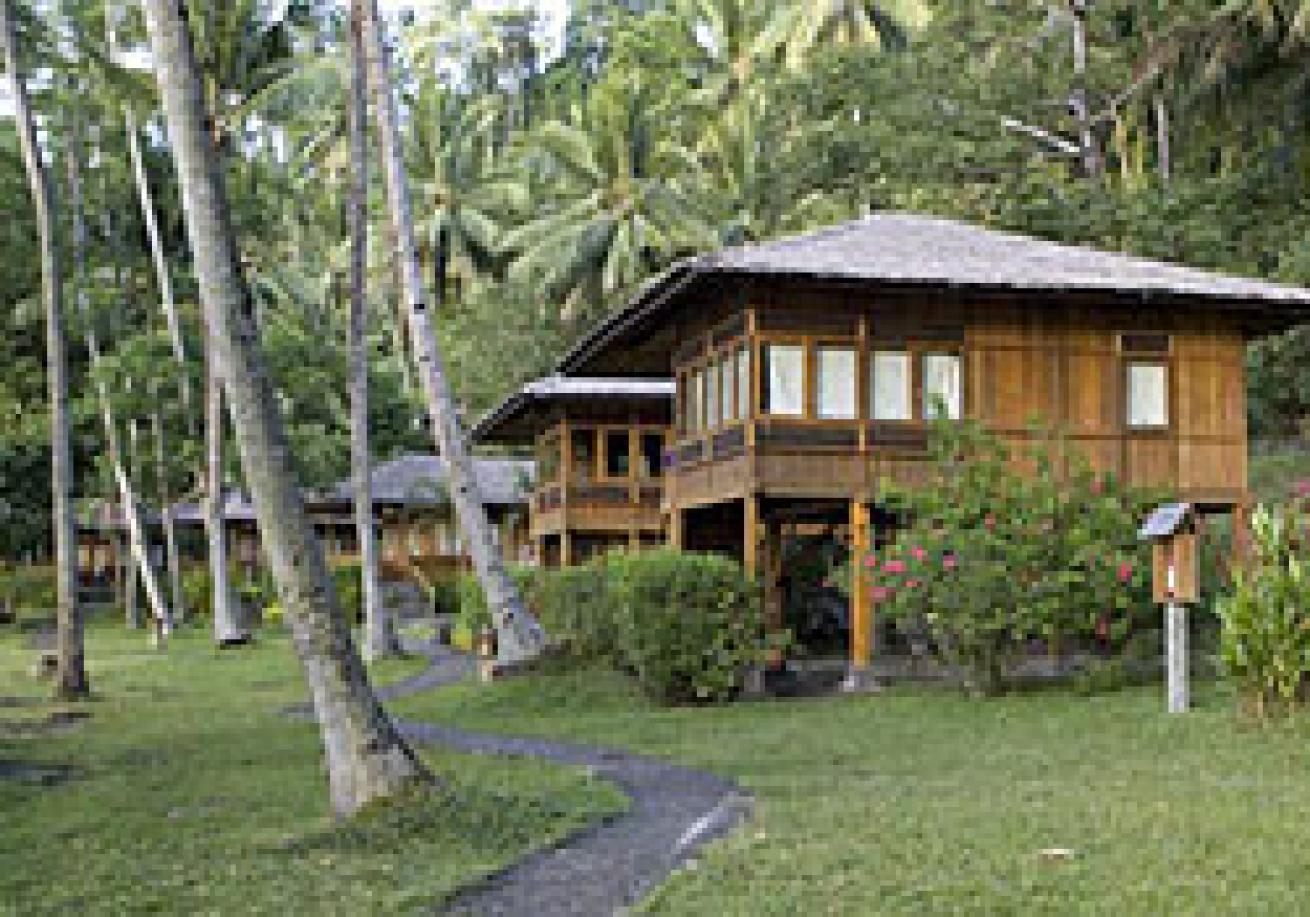
The North Sulawesi Aggressor operates an itinerary between Manado and Kungkungan Bay Resort (KBR), steaming either clockwise or anti-clockwise on alternate weeks around the north tip of the island. This makes an add-on at the resort very easy to accomplish, especially since the drive between the airport in Manado and KBR is only about 1 1/2 hours. Knowing how fatiguing long international travel can be, we opted to arrive 3 days before our Aggressor departure and book into KBR to get rid of a little jet-lag and to sample the best of Lembeh muck diving with the resort that put it on the map.
KBR operates kind of like a 17-room live-aboard with an emphasis entirely on diving the Lembeh Strait, the fairly narrow body of water separating the west coast of North Sulawesi and Lembeh Island. To that end, they have a wonderfully spacious camera room located near the dock, and here UW photographers can spread out for housing maintenance in a well ventilated and perhaps more importantly, well lighted workspace. They have either 110 or 220-volt charging stations, and a concrete floor with drains inviting access to equipment even when slightly wet.
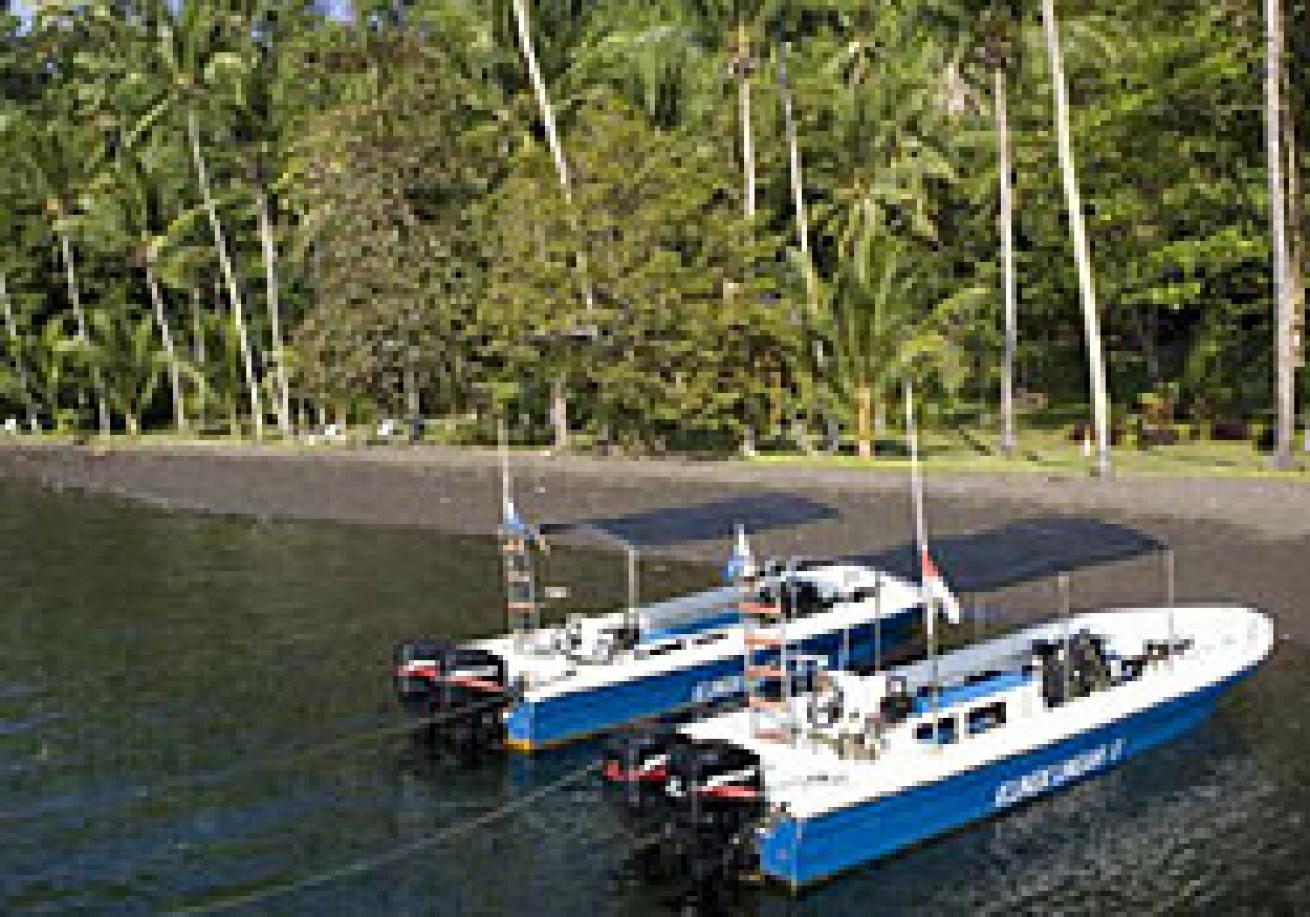
The "mother-ship" consists of various tasteful accommodations made from local hardwoods, including beachfront bungalows and suites. There is a main house with restaurant and bar, as well as reference library and computer station. The beach is black-sand, the property beautifully landscaped with tropical foliage, and there is a fresh-water swimming pool. Massages ($12) are a big hit, and for those wishing to stay in touch, the resort is more-or-less wifi enabled. However the Manado-based server was down much of the time we were there, and when it did work it was rather slow. But given the remote location, to have Internet access at all is extraordinary. Plus, if it was too easy to do e-mail and stay in touch with work; it would have interfered with a very busy (and far more pleasurable) schedule of diving, downloading, and processing images. Which, after all, is why we were there.
The heart of the operation is the diving infrastructure; the Nitrox compressor, the twin-outboard dive skiffs, and most significantly, the dive guides. Never having dived this kind of terrain before, I assumed local knowledge was a good thing, but until I experienced the KBR style of muck diving, I did not really appreciate how absolutely beneficial these guides can be in terms of delivering the shot. Not only do they know the environment intimately, diving it every day like they do, and not only do they have apparently superhuman visual acuity to see the small things they are able to point out; but they have acquired practical knowledge about how and where these creatures live. This allows them to take their little metal rods and probe around in the sand until a wonderpuss octopus begins roaming before our macro ports, or to prolong an encounter with a mantis shrimp before it darts back into its hole. The resort assigns one guide to no more than four divers, and it is with a sense of pride that they deliver one after another rare and wonderful creature.
About the diving
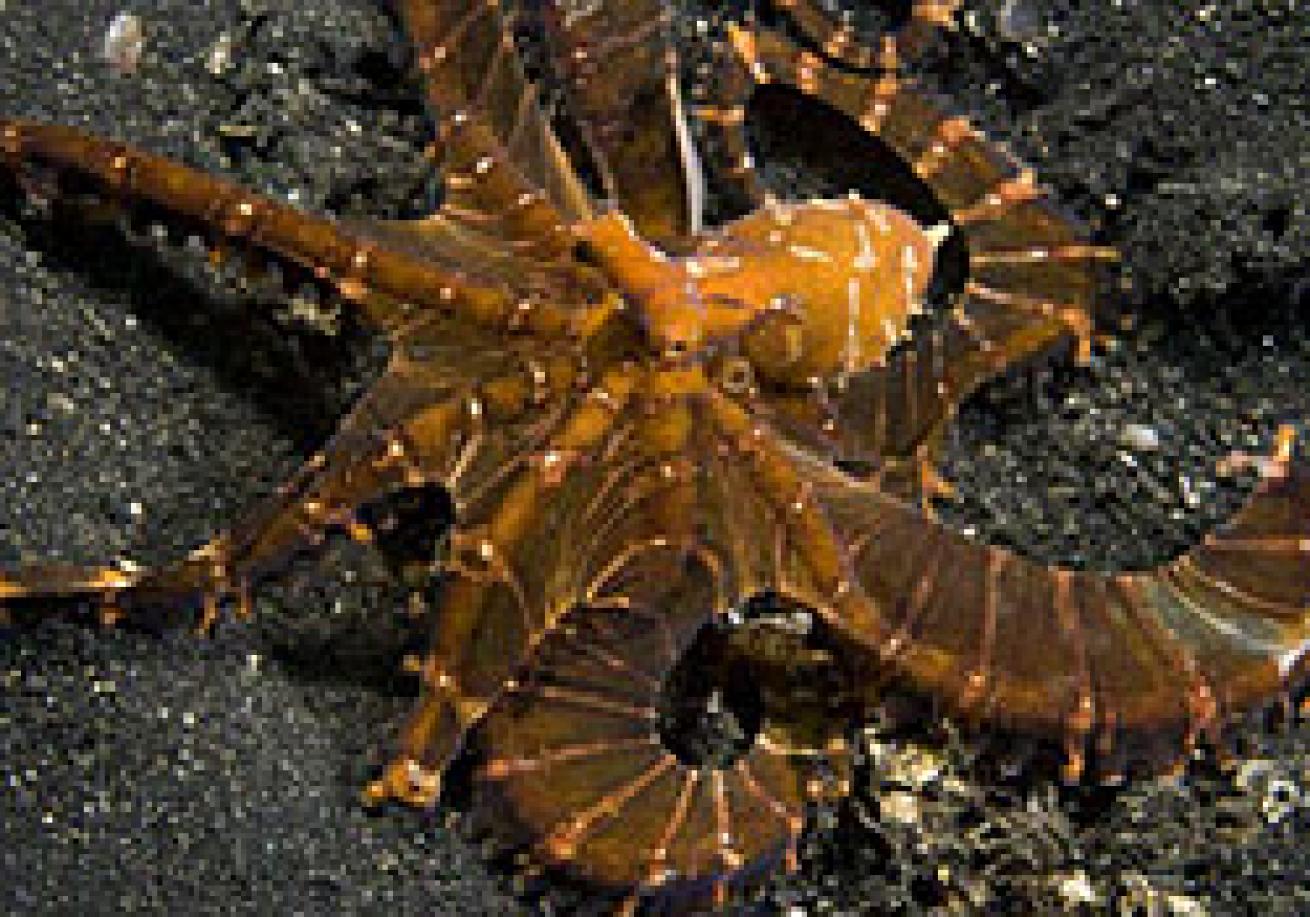
Steve Coverdale, who with wife Miranda manages the resort, recommended we put our wide-angle lenses away while in residence; and with 20 to 40-foot visibility the norm I had to agree. Actually, some of the dive sites do have nice coral gardens, and if I were going to be at KBR for a week I'd make a point to cover them with a wide lens, but with the Aggressor trip coming up in 3 days, I figured I should concentrate on the small stuff that Lembeh is famous for. In fact, most of what I shot was with the 100-mm macro on my full-frame Canon EOS1DSMKII, but many of our other guests were shooting cameras like Nikon D2X and D200 with a 1.5 correction factor from their digital sensor, and they found their 60mm Micro-Nikkor (effectively a 90mm macro lens) was their go-to optic. The addition of an external diopter (I used a Seacam Wet Two) was a nice option when a very small creature like a pygmy seahorse was revealed.
A note on muck diving - www.aggressor.com has a nicely informative narrative on the art and science of muck diving, copied below:
The somewhat ambiguous & misleading term "muck diving" was coined in the North Sulawesi area of Indonesia. In all actuality "muck diving" is predominantly done on crushed coral & volcanic slopes in the 20-80 foot depth range.
The word "muck" conjures up, to uneducated divers, silt out conditions & a muddy substrate. This is typically not the case in North Sulawesi. The average visibility in the Lembeh Strait is 30' - 60' on good days & 20' - 40' on bad days. The poor visibility is due to the very thing that makes the strait the diving wonder that it is...tidal exchange and incoming & outgoing currents.
This extremely rich "nutritional environment" is precisely why the area supports such a diverse endemic species such as the hairy frog fish, juvenile dwarf pigmy sea horses, star gazers, cockatoo flounder, ghost pipefish, mimic octopus, blue ring octopus & flamboyant cuttlefish.
As noted above, the currents & tides are very active in the Lembeh Strait & tend to "funnel" in and out of the straits. This tidal action does not create any type of drift diving situation, but does deposit some litter & debris in the strait. To the ecologically minded diver, this debris (i.e., cans, buckets, bottles) can initially be somewhat disconcerting, however; there is a very positive side to this & one that actually works in symbiosis with the u/w environment.
The previously mentioned bottom terrain of slopes and crushed coral is totally absent of safe habitat for the animals simply due to the movement of the water in the strait. Consequently, the incoming debris creates underwater homes for the resident dwellers in the Lembeh Strait. The local dive guides will be able to educate & inform divers further on this.
Divers not familiar with "muck diving" conditions do need to observe & be aware of the following:
- Only gloves with the fingertips removed are allowed on dives.
- Be constantly aware of touching or sitting on the reef or "muck" as there are highly camouflaged animals everywhere. You will learn to see these animals as you spend more time in the area.
- Do your part as a conscientious diver on the "muck" dives to help maintain the limited visibility.
- Don't move or disturb items on the bottom.
- Be very aware of over finning (use slow steady & short fin movements to prevent stirring up the sandy bottom).
- Always remain 2-3 feet above the "muck" & have total control of gauges & cameras that can stir up the bottom & disturb these delicate animals.
*
- As animal are discovered, be courteous to all divers in the group. These animals are easy to photograph, as a rule, & will remain in the open as long as necessary. A note on the local dive guides --- The local dive guides are highly trained to spot animals in the "muck" that would absolutely go unnoticed by the untrained eye. The guides use, at times, a probe to move items on the bottom and gently prod animals to move so they can be seen. This is something we ask that you do not do, and that you leave it to the local guides.
Water Temperature
When we visited there was a significant difference in the water temperature between the Lembeh side of the island, where the water was 78 degrees, and the Manado side where we had 84-degree water. I assume this temperature discrepancy is not necessarily as extreme year-round, but clearly different currents affect either side of the island, no doubt also explaining the vast differences in the underwater environments. I found that layering wetsuits, a 3mm Henderson Instadry wetsuit coupled with a 3/5 hooded vest worked really well for me under these conditions.
The House Reef
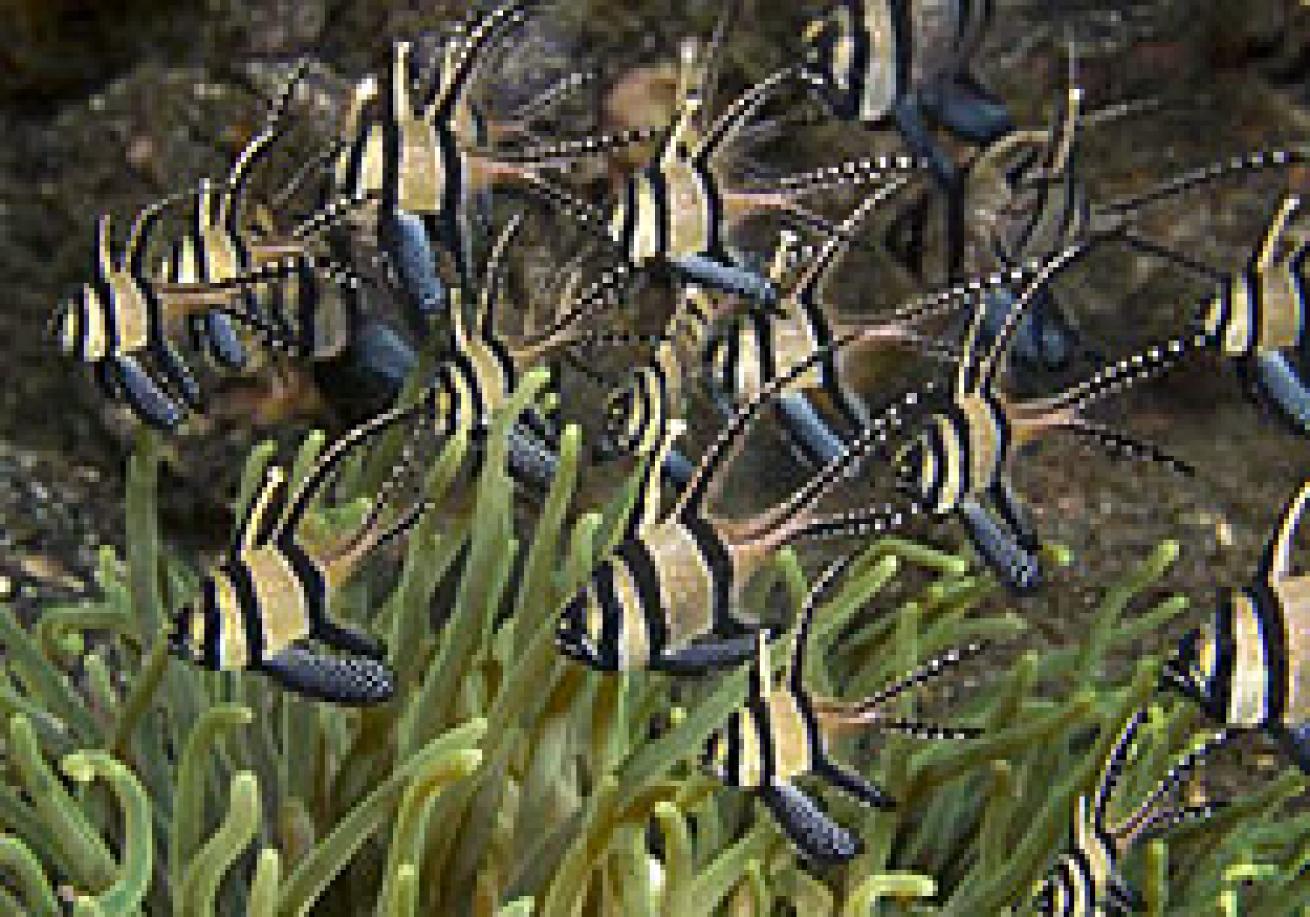
I was too jet-lagged and exhausted to make the first morning's boat dive. So, with a dive buddy and a guide (they don't let anyone dive without a buddy under any circumstance) I did the simple shore entry by the dock and dived a part of the house reef, this time exiting stage right. Immediately at the end of the pier was a cluster of banggai cardinalfish, (Pterapogon kaudemi) floating just above an anemone inhabited by orange clownfish. To see anything other than an anemonefish so near the tentacles of the anemone was surprising, but I found this to be common for this species in Lembeh. They also are found floating above plate corals that are visually very similar to anemones (I lost a bet on a bottle of wine to one of my friends when I claimed the environment in the photo was anemone and he correctly opined it was plate coral). Later in the week I saw them among the spines of a sea urchin, so I guess hanging out in sharp and toxic environments suits their lifestyle.
This was a productive dive for various species of pufferfish and pipefish. The backgrounds were more coral structure than I would find at some of the other predominantly black sand locales later in the week, so this was a great way to start the KBR adventure. Depth range was 10 to 40 feet for the areas I found most interesting. Later in the week I dived the house reef, stage left, and found quite a difference in terrain and critter. Staff told me that the House Reef is actually rarely dived by KBR guests, as they tend to board the dive boats for the 3 to 15-minute ride to the other presumably more exotic nearby sites. But the whole of that bay is a protected marine environment, and is accessible only to KBR guests. I found it both convenient and productive.
The map of the dive sites posted by the dock identifies 30 different sites. Truthfully, I was too debilitated by jet-lag those first few days to pay much attention to the name of the sites we dived, trusting that the dive staff knew far more about what was good and where than I did. Instead, I paid attention to the briefing so I could decide what critters to target. In terms of lenses, I found I could essentially choose between my 50mm macro or my 100mm macro, for almost all the critters described were small. No surprise really, for each night a flotilla of several hundred fishing boats work the waters of the strait, assuring anything larger than the mesh of a gill net is unlikely to survive outside the protected zone at KBR's personal bay. Lembeh is about the small stuff, undeniably.
I was only at KBR three days, and will be the first to admit I normally tend not to obsess over macro subjects. In fact, I can go six months without slipping my 100mm macro lens on my underwater camera, yet this trip it was almost constantly affixed. On the other hand Ned and Anna Deloach, of the "Reef Fish" ID books fame, will spend 2 months in Lembeh this year because they find such a wealth of unusual and rarely documented marine life. For the dedicated macro shooters of the world, this is a Mecca of obligatory pilgrimage.
Taken in this context, consider my vision of these waters the "Cliff's Notes" version, concentrating on the iconic and obvious rather than rare and sublime. Which is not to say I didn't shoot some pretty rare stuff, but I attribute that more to the talent of the dive guide, the wealth of the environment, and a little bit of luck. Among the creatures significant to me in the short time I was there:
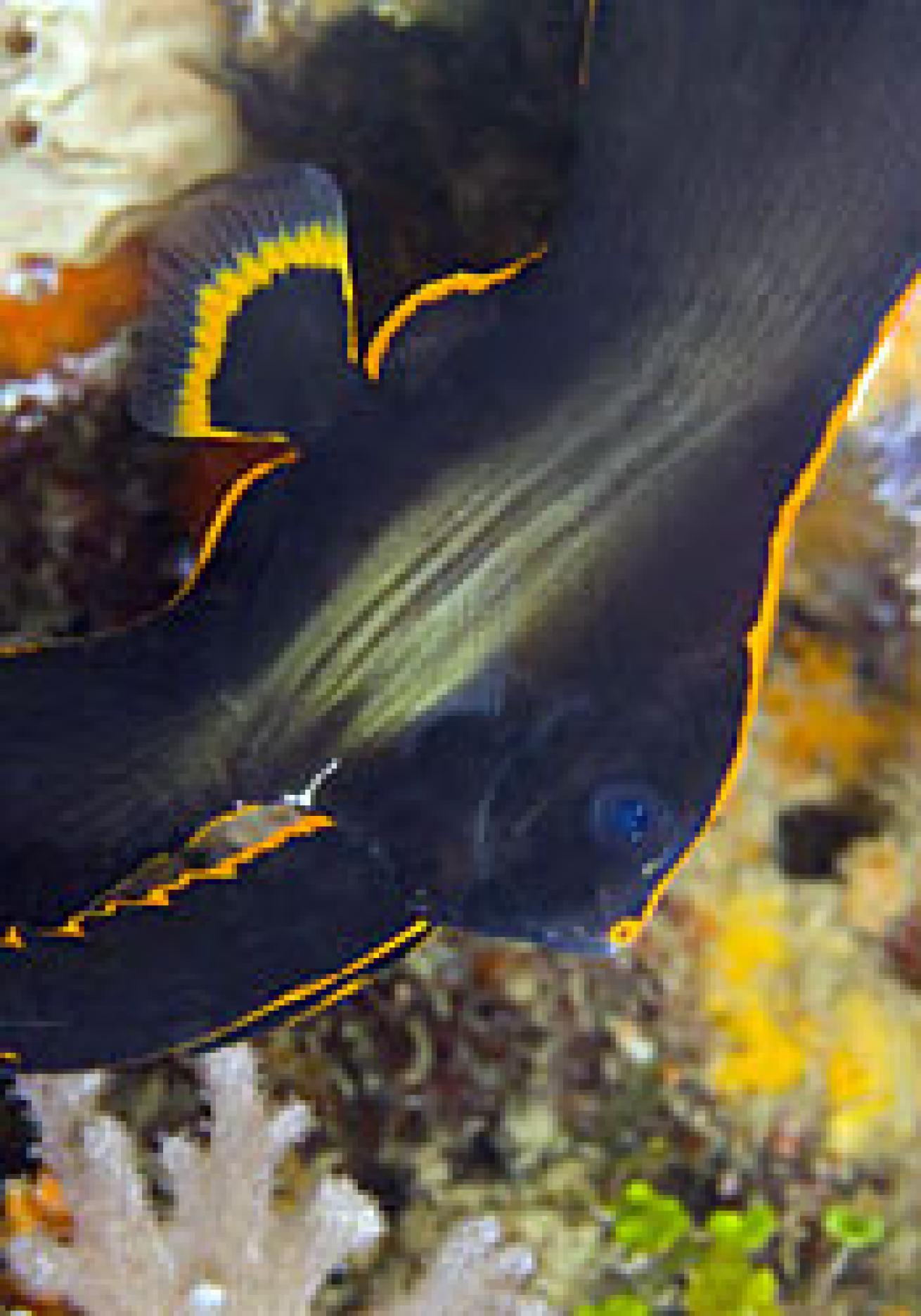
Pinnate spadefish - Amazing for bizarre and beautiful shape, accented by orange trim along the black body
Anemonefish - The species I found most predominant were orange, skunk, pink, orange-finned, Clark's, spinecheek, false clown, and tomato anemonefish
Anthias - Many species, although not in Fiji or Maldives profusion
Barramundi - The juvenile of this species is particularly interesting
Hawkfish - Many species including the photogenic longnose, dwarf, and freckled
Sweetlips - Fairly common, but skittish. I figure any fish that fits easily into a frying pan should be cautious here.
Wrasse - Too many species to mention
Cardinalfish - I found the banggai to be the most interesting, but there must have been more than a dozen species of cardinalfish
Mandarinfish - There is a pretty nice mandarinfish dive scheduled daily for 5:00 PM. Not a large substrate actually, and a little deeper than some at about 50 feet. Our group had been on mandarinfish dives elsewhere in the world and was not overly impressed with this one, but if you're there and you need a mandarinfish opportunity, this can deliver.
Lizardfish - Every dive
Shrimpgoby - Exceedingly common, but nonetheless photographically challenging
Dragonet - Many species
Gobies and Blennies - Diverse and abundant
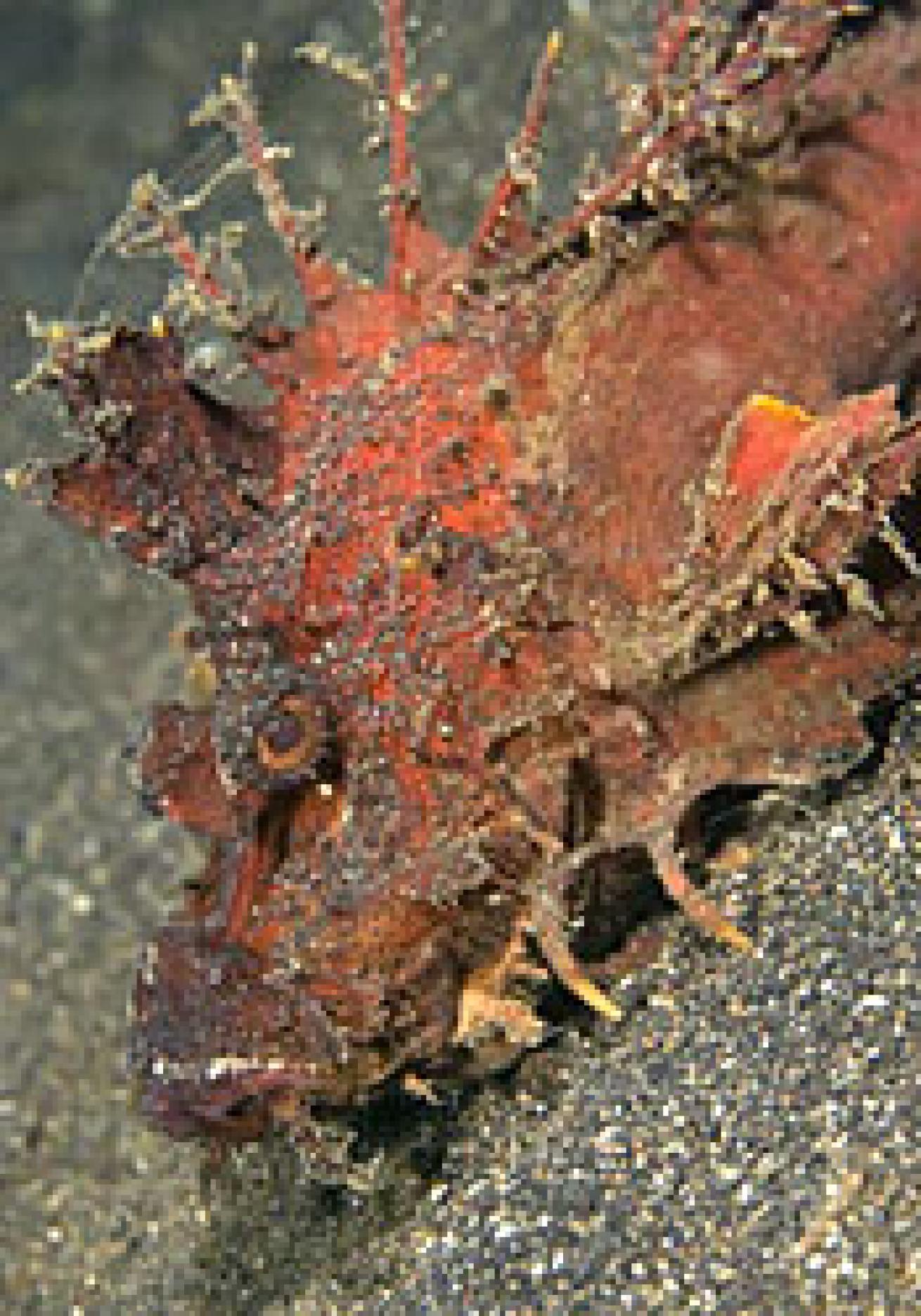
Frogfish and Scorpionfish - Take the whole "Odd-shaped bottom dwellers" chapter out of the Reef Fish ID book for the tropical Pacific and you've described the population of the sand slopes off Lembeh. I found that out pretty painfully while shooting a flamboyant cuttlefish on my first day. Concentrating on vertical compositions my left elbow was bouncing along the sand as a kind of monopod when I felt a sharp sting through my wetsuit. Looking down I saw a rather indignant devil scorpionfish roused from his ambush buried in the sand and having stung me in response. I put my elbow in hot water to break down the venom as soon as we got back to the dock, so the effects were rather minimal. But it does point out just how many small and camouflaged critters occupy what is at first glance a submarine desert. Of the numerous species of frogfish, the hairy variation seemed to cause the most excitement among the other divers; and while there were many species of scorpionfish, the weedy (Rhinopias frondosa) justified dedicated dives in pursuit.
Stargazer - Fairly common on many of the night dives to the sandy slope
Cowfish and puffer - Common
Lionfish - Common (but often on very nice backgrounds)
Pipefish and seahorse - The pygmy seahorses are guaranteed at several sites, and pipefish such as the ornate ghost are favorites of the dive guides
Eels - The ribbon eel is found frequently, male/female/juvenile
Shark - Not too likely, although some hammerheads are occasionally seen at a distance. I saw one reef shark the whole week, and he was way too far away for a photo.
Rays - Mostly blue-spotted stingray
Squid, cuttlefish, and octopus - Lembeh is very good for cephalopod sighting. The mimic octopus and wonderpuss are very special encounters, and highly prized photo opportunities. Cuttlefish are pretty common, but the smaller flamboyant cuttlefish has been kind of rare lately and when I came home with a nice series the dive guide seemed to be very proud to have delivered. I'd never shot either the flamboyant or the wonderpuss before, so these were prized additions to my critter portfolio.
A final note on KBR
I was really very impressed with the entire operation. They were very safety conscious, and kept the resort immaculately maintained. Some small issues were beyond their control, like the Internet server going down in Manado, but that which they could affect seemed to operate flawlessly. Or, at least if there were flaws, they kept them hidden from us. This is a very remote locale after all, but despite the considerable challenges they must face it is a terrific diver's resort. The Coverdales get a tip of the hat from our group for hospitality and professionalism, and the dive staff was truly amazing in terms of delivering the cryptic creatures of Lembeh. I almost didn't take the few extra days at KBR, figuring I would get enough to the macro stuff on the Aggressor, but now having done it I can't imagine any serious dive photographer would travel this far and not invest some time in a land based resort in Lembeh. The guides do these sites every day of their lives, and the benchmark of their performance (and level of gratuity) is the virtual invisibility of the creatures they are able to point out to their guests.
North Sulawesi Aggressor
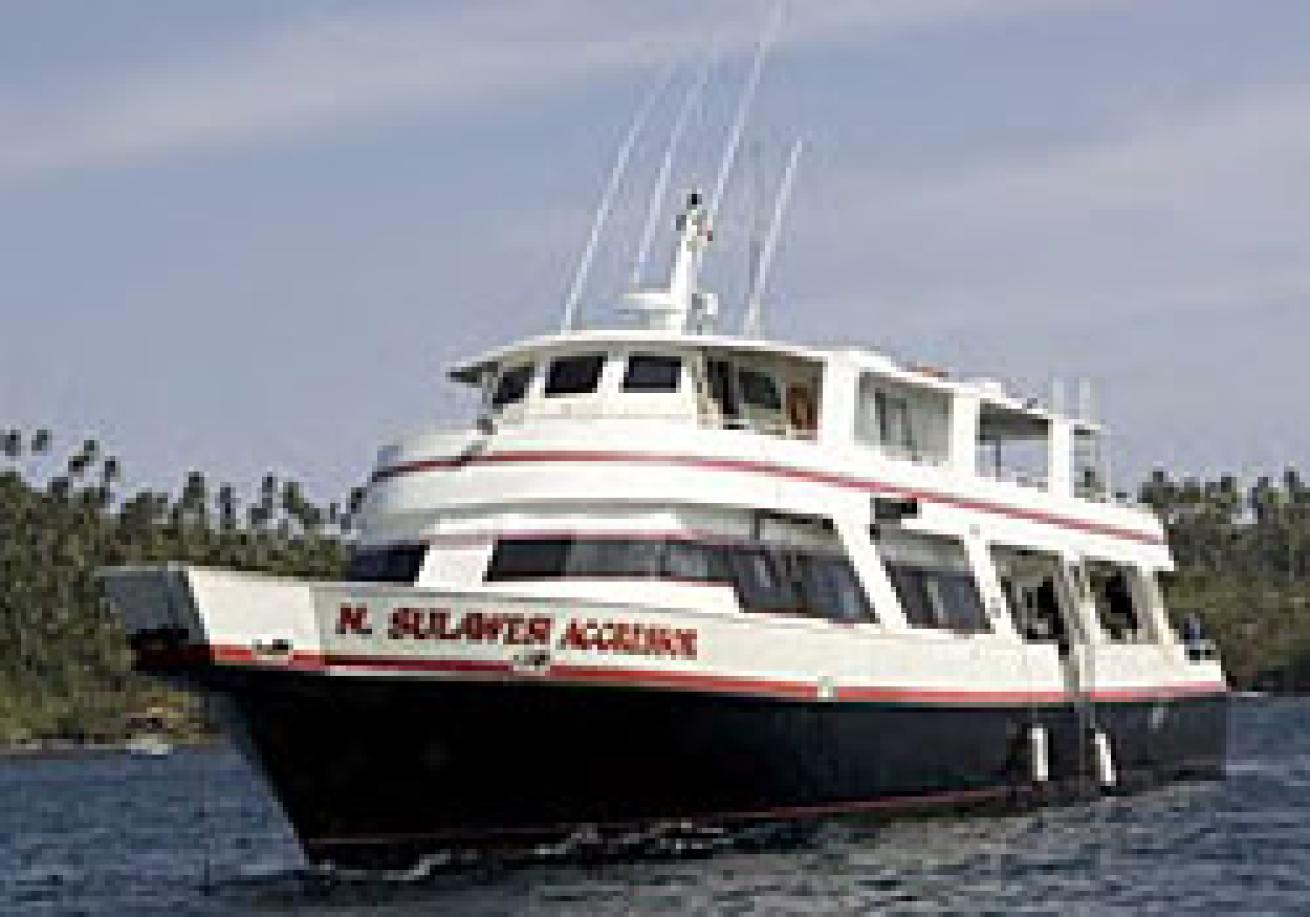
We did the morning dives at KBR and then left for the several hour drive to Manado and the North Sulawesi Aggressor in the late afternoon. We hit rush hour in Manado, so the trip took longer than it would have had to, but KBR and the Aggressor work very closely together to make sure all guests' needs are met and comfort assured. That meant all our bags were safely transported, and they even provided bins for our already-assembled cameras so we did not have to break down our housings and repack. Even though they are totally separate businesses, the Aggressor Fleet and KBR are clearly symbiotic. I don't know which is the host anemone and which is the clownfish, but they each benefit from their close collaboration.
The vessel is a 110-foot dive yacht, most recently incarnated as the Truk Aggressor, and only operating as the North Sulawesi Aggressor since October 2005. With 7 double staterooms and a quad cabin, the maximum accommodation is 18 guests.
As we pulled into Manado I couldn't help be recall the last time I visited. It was September of 2001 and I had been invited to be a photo pro with the very first Digital Shootout by friends Dan Baldocci of Light and Motion and Berkley White of Backscatter. Of course, back then I really knew nothing about digital photography and the only thing I knew how to do on a computer was word processing. But, along with about 30 others I was there to learn something about this new thing called "digital photography". After all, maybe there was something to it, and if so I should possibly pay attention. I figured, what the heck, it might come in handy somewhere down the road.
Anyway, we got as far as Singapore and when we deplaned for the Manado connection there was a camera crew from the local news affiliate waiting to greet us. Bleary-eyed and disheveled from 16 hours in the air I had little patience for what I assumed to be their "Candid Camera" clone when they asked me what I, as an American, thought about the terrorists who flew jet airplanes into the World Trade Towers in New York.

We spent the week after 9/11 in Manado at a land-based dive resort learning about how to process and store digital images from Berkley, Dan, and James Watt. At night we'd watch the news back home, and by day we'd dive the Bunaken Marine Park. (Click here for a review of that week.) Dan gave me an Olympus 3040 in a Tetra housing to try, and while my serious images were shot that week with my trusty Nikonos RS, the immediacy of review on the digital camera was pretty impressive. In fact, I bought a Nikon D1X and Seacam housing right after I got home, and we all know how digital imaging has swept all forms of photography in those few short years. As for being in an essentially Muslim country like Indonesia as we were first beginning to learn that there were Islamic terrorists out to get Americans, we took comfort in knowing North Sulawesi is predominantly Christian, and quite peaceful. Gratefully, that's still the case and never did we have a moment's concern about geopolitical issues while here.
Now, five years later, we were back to Manado to dive, far more digitally enabled than that first trip. There were even two of our guests along this time whom I'd first met during that traumatic time together over 9/11, Dana Weber and Ann Bennett. They too were now shooting top-of-the-line digital systems ... Canon EOS1DSMKII and Nikon D2X in Seacam housings. All three of us had significantly evolved from our first digital experience with the Light and Motion Tetra housing for an Olympus 3040.
As would be expected of an Aggressor boat anywhere in the world, the North Sulawesi Aggressor is a lovely dive yacht crewed by experienced dive professionals. Captain Niall gave us a mercifully short briefing on the night of arrival, for while many of us had been on location long enough to acclimate, two of your guests had arrived just that afternoon and been transferred directly from Manado airport. Cabins were assigned, food served, and we retired semi-comatose to our cozy bunks.
Day One aboard Aggressor - Fukui, Mount Satu, Lekuau 2
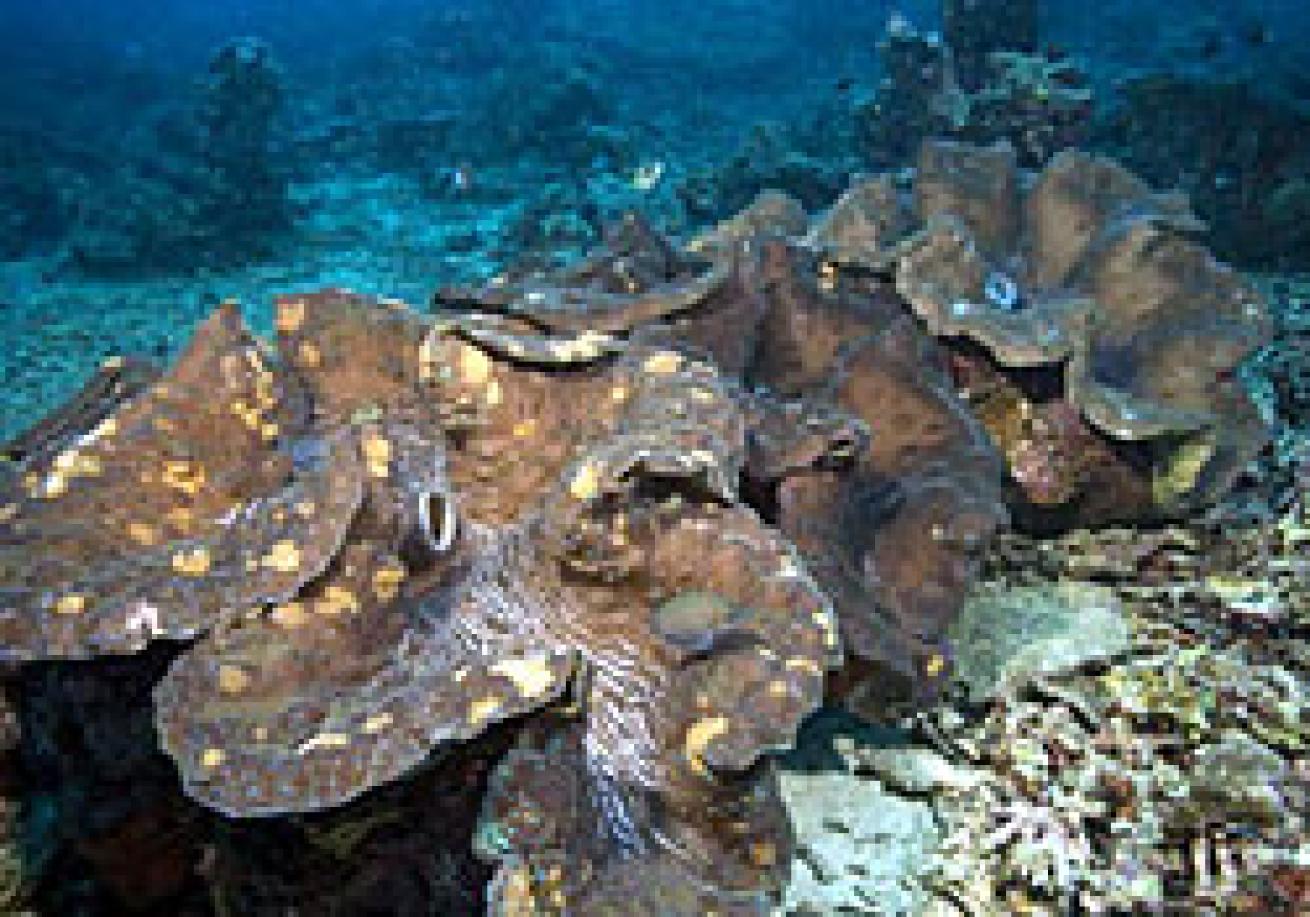
The dive briefing and other important need-to-know information was disseminated that first morning, all cameras assembled, and soon we were ready for our first dive in the Bunaken Marine Park. Actually, I remembered Fukui from diving it in 2001, but visibility was much better according to my recollection.. Water clarity is variable anywhere, anytime; but being so close to Manado (it was a city of a million people back in 2001, and I figure the city must have grown significantly since then) the nutrients and debris of civilization had to affect the water. The coral was still in great shape, but visibility only 45 - 50 feet. That first dive was kind of disappointing, except for 5 in-a-row giant tridacna clams, pristine staghorn corals in the shallows, and a few nice clownfish set-ups. But, the checkout dive on most live-aboards is often marginal so I remained hopeful.
Unfortunately, the other two dives along Bunaken Marine Park that day, Mount Satu and Lekuau 2, reinforced my perception of water clarity issues. Also, there were bottles and plastic bags floating along the surface (and occasionally underwater) that were constant reminders of our proximity to a very large city. The biggest issue was that the marine life was pretty skittish here, probably owing to considerable fishing pressure. We did manage a very nice over/under series with a local outrigger boat that came to sell trinkets to the Aggressor guests, and I got lucky with a few pretty cooperative fish. Actually, Lekuau 2 was pretty nice, as a vertical wall nicely decorated with encrusting sponge, black coral, and large tube sponge along the precipice. With decent visibility, this could have been a very nice wide-angle opportunity, especially with the nice anthias concentrations along the shallows.
I fear divers the first day out of Manado will be a little concerned that the diving would not justify a trip this far. Trust me, or rather trust Aggressor Fleet, the diving gets much better after that first day as the itinerary progresses away from the metropolitan area. Water clarity improves along the north end of the island (although we never had really stellar visibility in the 80 to 100 foot range, 30 to 50 being more the norm) and the reefs and reef dwellers become far more fascinating and accessible.
Day 2 - Goldfish Bowl, Batu Mandi
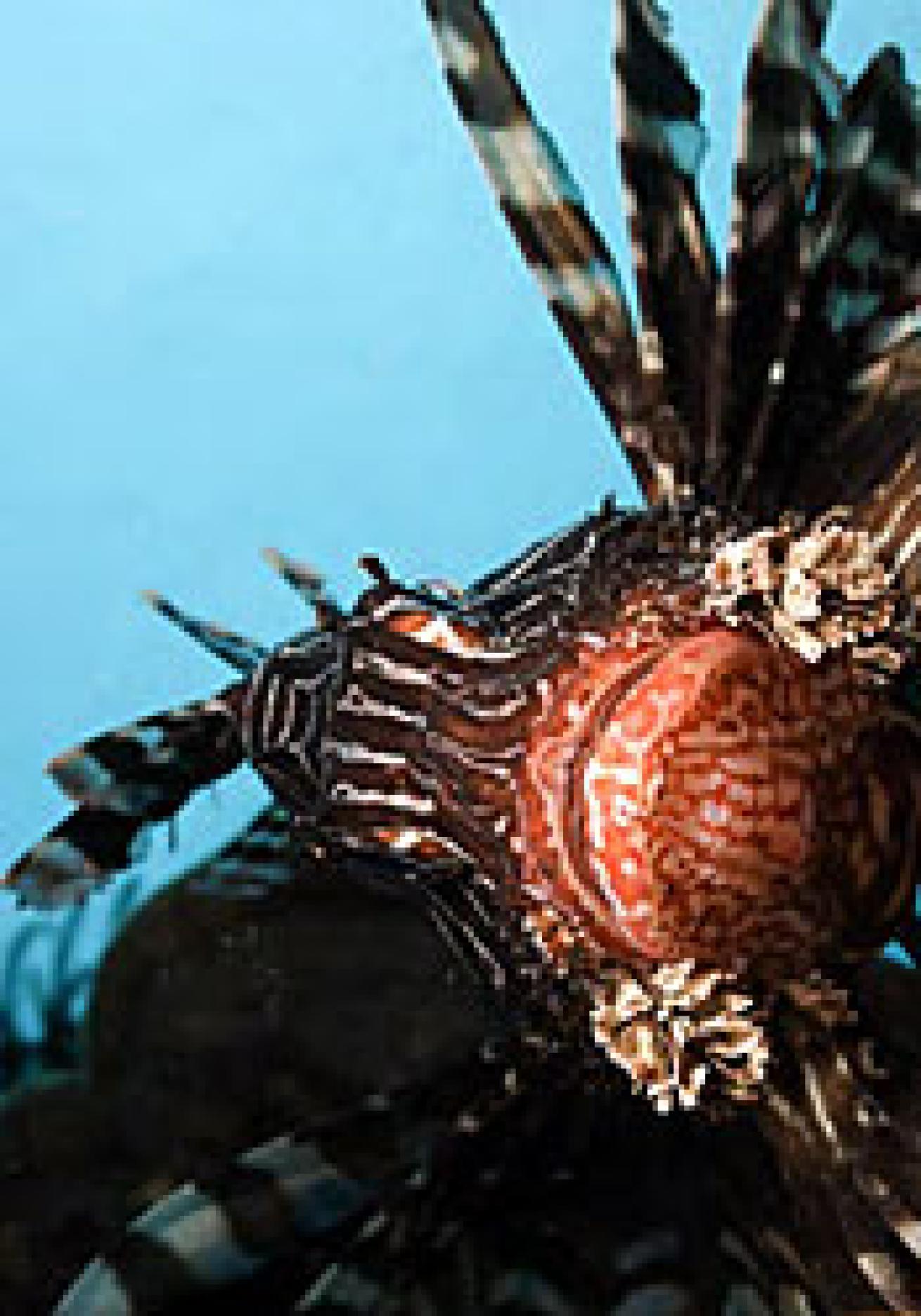
The Aggressor formula is four dives during the day, and as the anchorage permits, the option of a night dive. For the 7:30 dive (cold breakfast of fruits and cereals before the first dive, hot breakfast after) we arrived at a site they call Goldfish Bowl, although I never quite figured out how it got the name. I figured there'd be large clouds of anthias, but instead the highlight of this site is acres of perfectly intact staghorn coral with myriad clownfish and anemone clusters tucked within. Once beyond the staghorn zone there were lots of other fascinating subjects ... cuttlefish, blue ribbon eels, more clownfish and anemone clusters (often with the mantle rolled up making for a more interesting composition). There was one especially cooperative lionfish here that allowed me to play with various shutter speeds on an upward angle as he sat along the side of a sponge. I figured these shots would make a good teaching tool later in terms of how foreground is determined by strobe power and strobe to subject distance, while background more depends on shutter speed to control ambient light.
The afternoon dives at Batu Mandi are very significant critter dives. Here is where they often (maybe 50% of the time) see blue-ring octopus, but I guess next week's guests will have a slam-dunk blue-ring experience on their four dives, because on our four dives we got blue-ring skunked.
The typical dive profile is to enter the water to the left of a large rock structure that just barely sticks out of the water. The rock itself is totally barren above the water line, but below it is a veritable oasis of crinoids, sponge, gorgonia fans, tunicates, and large seafans all punctuating a substrate cloaked in vibrant encrusting sponge. To hit this in 100-foot vis would be a wide-angle delight, but since that's not likely to happen; to hit this at any time, day or night, is a fish and macro shooter's wonderland.
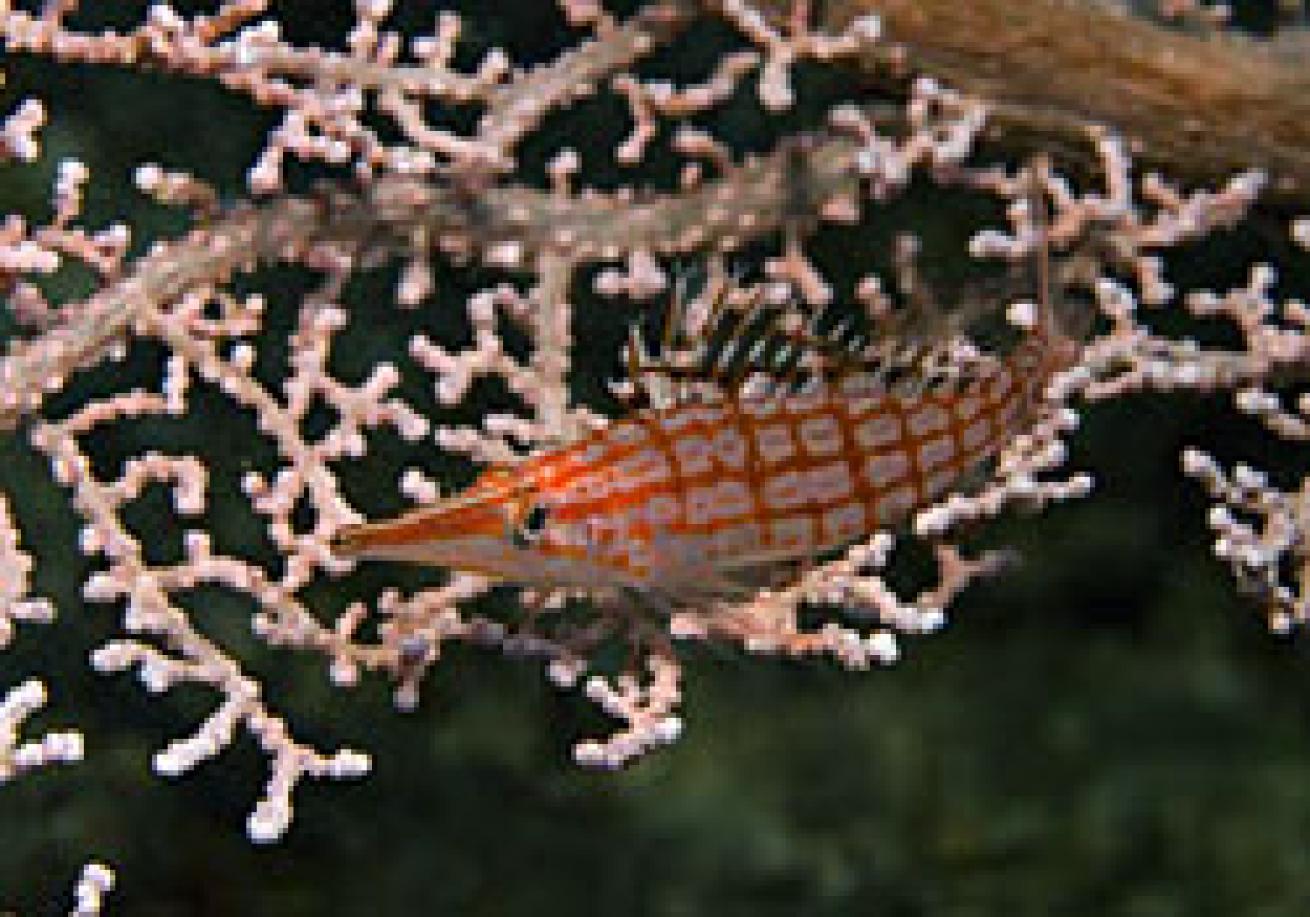
Working along the slope of the large rock we came across several seafans that typically host pygmy seahorses. They either weren't in residence this day, or they escaped our normally eagle-eyed guides. However, I did manage a killer shot of a long-nosed hawkfish while the pygmy quest was delegated to the dive guide. Actually, they did find a species of pygmy a little farther along the reef, but as it was kind of brownish-bland in color and against an uninteresting background I was reluctant to invest the kind of bottom time serious pygmy shooting requires.
Other usual suspects for this dive include a diverse selection of nudibranch, frogfish, and numerous species of scorpionfish. In one frame I actually got three different devil scorpionfish, one buried down in the sand and two more sitting out in the open. Here I also got a nice series with a clown trigger, normally one of the more reclusive reef dwellers, but for a short time at dusk his hunting imperative seemed to overtake his innate caution and I was rewarded with a dozen or so shots as a result.
As good as the day dives were here, the night dive was positively inspiring. I can't say I got so many memorable shots actually, mostly of butterflyfish that I could not get close to during the day, but were far more accessible at night. But, the color of the encrusting sponge and soft corals along the rock face was astonishing. I recognized it as pretty interesting during the day, but to have the detail revealed to the concentrated beam of the dive light was very special indeed. After the dive, inflated BC positioning me on the slick calm surface of an 82-degree sea under a clear and starry night ... that was one of those memories that remind me why I dive.
Day 3 - Sahoang Satu, Batu Mandi
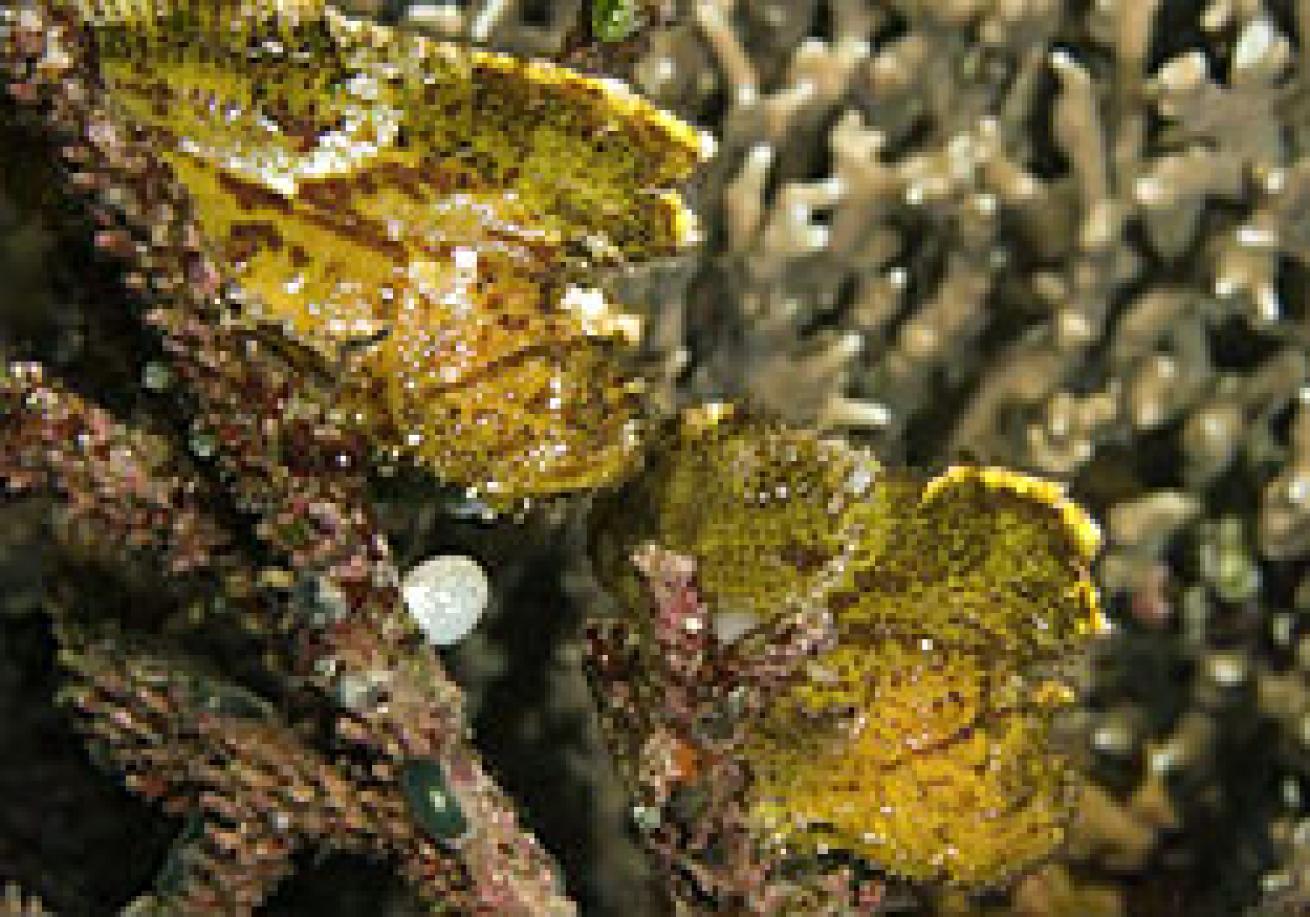
By now we are all the way to the north end of the island, and our first dive it to an offshore rock known as Sahoang Satu. I remembered this dive from my trip here in 2001, but for us based near Manado it was an all day affair to get in two dives. Here it was a simple matter to step off the mother ship onto the dive dinghies (all the diving we did off the Aggressor was off a pair of v-hull dive boats with twin outboards and tank racks) and drive 3 minutes to the site. The highlight of this dive can be wide-angle, with the rock faces cloaked with yellow soft corals, but we hit the site at slack tide (normally a good thing) but the soft corals had erectile dysfunction as a result. Still, the resident school of blue-lined snapper was interesting, as were the opal sweepers inhabiting the rock crevices. This is a dive that had great potential, and I was eager to revisit, but the winds kicked up and it was getting kind of sloppy for food service aboard the boat and getting back into the dive skiffs.
Kind of out of options for that region and that wind condition, we headed back to the protected bay at Batu Mandi. While the terrain was familiar from the day before, the critters were different ... a pair of leafish together on the staghorn, anthias close-ups, a squat lobster on a whip coral ... any dive here will provide fascinating options for a photo enthusiast equipped with a fish or macro lens.
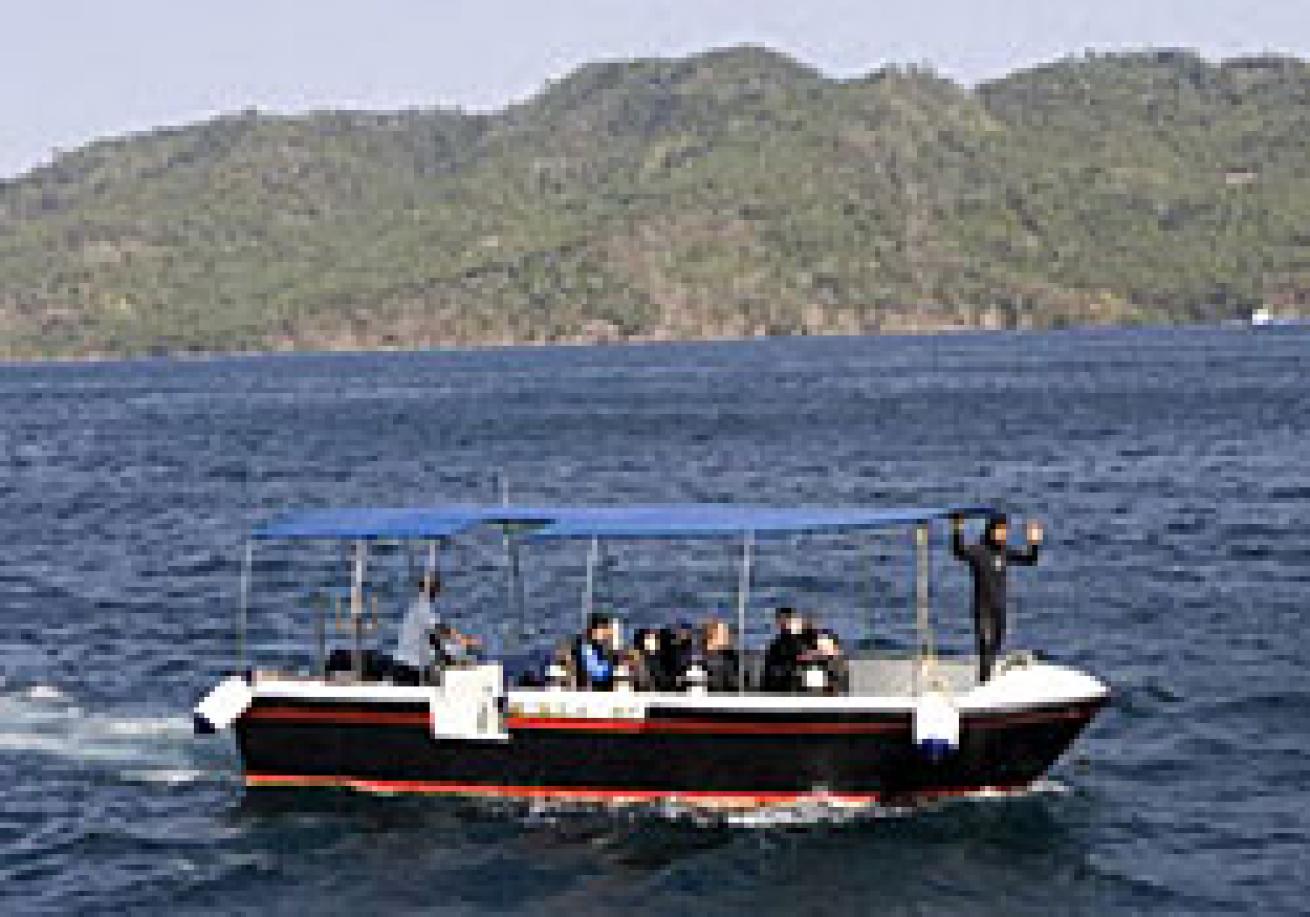
Day 4 - Lembeh (TK2, Hairball, Jahir)
We rounded the north end of the island last night and entered the Lembeh Strait. The wind is still pretty significant, but it does not affect us at anchor. It does however affect which sites we can dive and the coast of Lembeh Island is more exposed, rougher for the dive skiffs and probably too bumpy for the big boat to comfortably sit. As a result we are limited to sites along North Sulawesi, waiting for the time they say happens in October when "the switch turns off" and the winds die. It was slick calm on the Manado side of the island, and really pretty nice when we were at KBR, but these past couple of days have been breezy. In all, we had only one day of overcast, and when you are shooting subjects 3 inches long that hardly matters. I doubt anyone is complaining about the weather, but still, the boat ride back to the mother ship would be more comfortable (and dry) if the stinkin' wind would drop off.
In Lembeh the Aggressor dive protocol is to choose two sites for the morning and two for the afternoon and rotate the dive skiffs between them. This minimizes the size of the group on each site, and assures that if a significant photo opportunity appears, there is not a frenzy of frustrated photographers waiting their turn.
A note on Lembeh photo etiquette
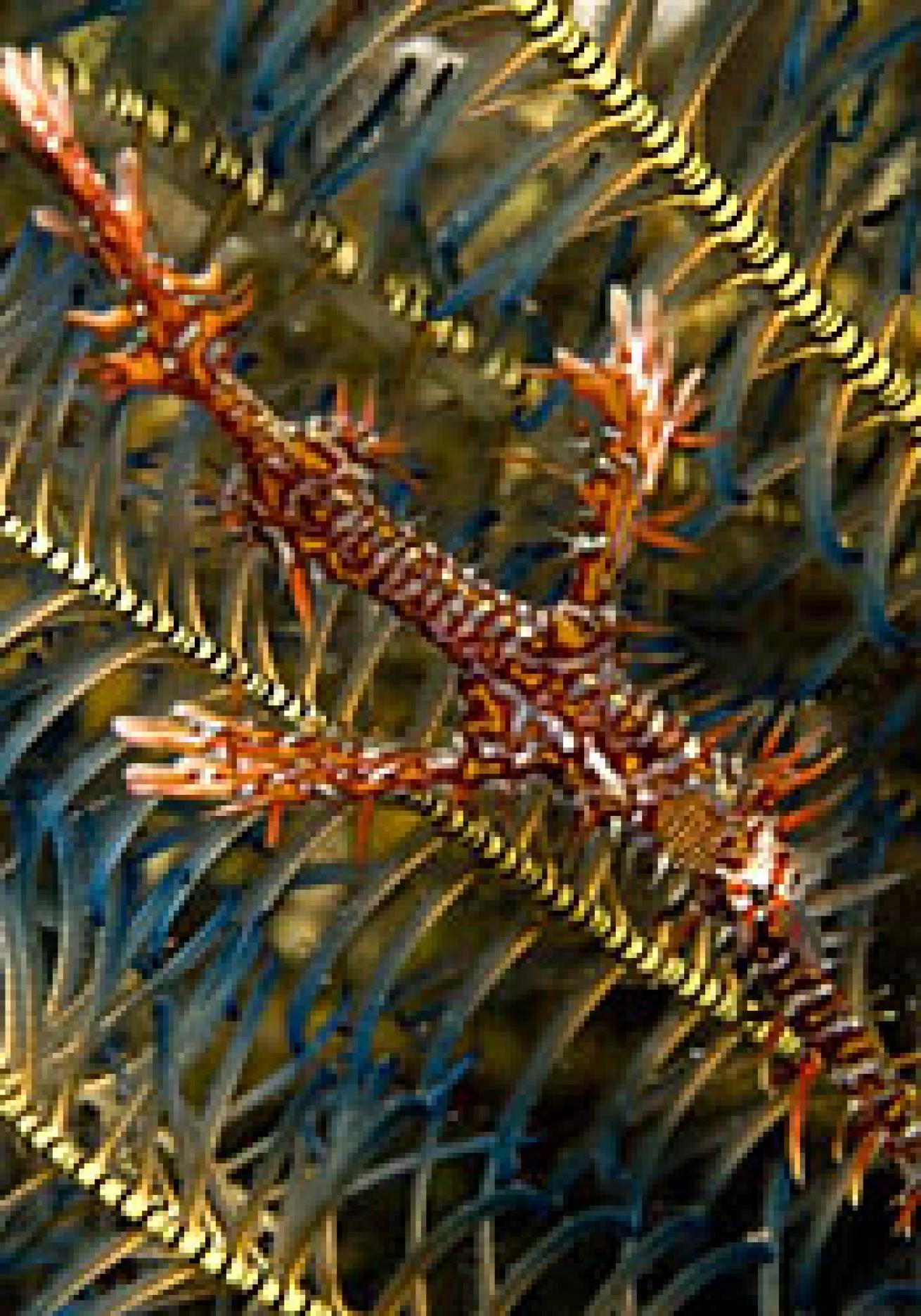
When we run our photo tours we usually operate under the premise that a shooter finds a subject, and it is theirs until they voluntarily relinquish it to another shooter. This has worked well, and our groups have been wonderfully cooperative, even to the point of swimming after another guest, showing them a particularly unusual critter on their digital camera screen, and swimming them back to the site. But here the critters are more isolated and guide-dependant. The proper procedure is to shoot as necessary, but more sparingly. This is no doubt better for the creature, and more considerate for those who may photograph it later. Following the shot, use buoyancy control to gently lift off the sand, thereby leaving the subject intact for the next shooter. (Any shooter who is overweighted, clumsy, and inconsiderate enough to leave a cloud of sand in their wake will not be popular on these kinds of imaging opportunities.) If it is a particularly sensitive subject like a pygmy seahorse, even greater restraint must be exercised.
At TK2 we found a pair of ghost pipefish almost immediately after dropping into the water. The one next to the crinoid was well camouflaged, but another larger version was out in the open. Verticals, horizontals, Wet Two diopter shots of the eyeball and we were off to the next photo-op. More hairy frogfish, this time two in one frame, with another juvenile just 5 feet away. In the shallows I found a school of catfish, much larger fish than I had seen previously, and they offered a pretty significant composition. Other interesting set-ups were banggai cardinalfish, this time tucked into the spines of an anemone and a school of jacks raping the sand substrate for small crustaceans and fish. Hairball was more hairy scorpionfish and other assorted macro critters, but not the rhinopias that is normally in residence. So far that one has eluded me this trip. And finally at JAHIR (named for the first initial of the 5 dive guides who discovered the site) the visibility turned absolutely dreadful, yet the dive still rendered nice encounters with a baby painted frogfish, juvenile sweetlips, various dragonets, and several varieties of pufferfish. {mospagebreak}
|| |---|
| Click here to see Stephen Frink's Indonesia Gallery Click here to see the Group Indonesia Gallery |A note on the North Sulawesi Aggressor
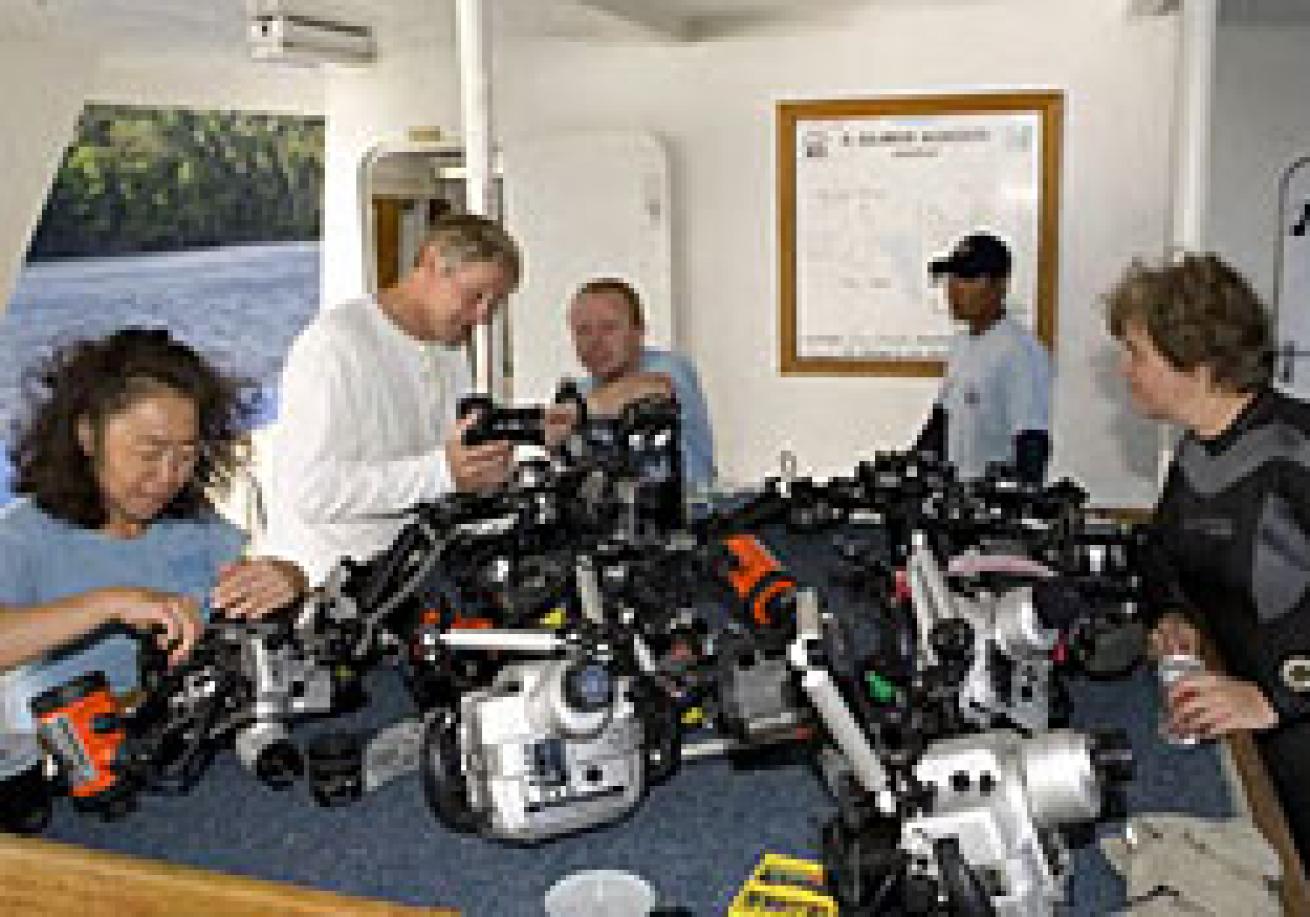
It came as no surprise that this vessel operated at a very high level of professionalism. It is what I've come to expect from Aggressor Fleet, but their dedication to guest services was very much appreciated by our group. Ours is a rather intense group of underwater photographers, but I presume most who venture this far share a similar imperative. The boat is nicely set-up with charging stations and comfortable lounge areas in the main salon ideally suited to editing from our laptops. The membrane system delivered consistent 32% Nitrox, and the twin-outboard skiffs were actually more convenient than diving from the mother ship might have been in these waters. Plus, by having two skiffs available, we had the option of all diving one site, or splitting the group. Since most of the critter dives are better with smaller groups, we tended to send each boat off to a different location, although each were generally less than a 5 minute run from the Aggressor. The cabins were spacious and well appointed, and the food prepared by Chef/Photo Pro Alan was stellar indeed. Of all the positives aboard, a tip of the hat has to go to the dive guides for their diligence and damn good eyes.
Day 5 - Nudi Retreat
Captain Niall was beginning to take pity on those of us suffering wide-angle withdrawal and suggested a special site on the Lembeh side of the strait, Angel's Window. But the winds continued to conspire against us by keeping the water churned up, so even if the soft corals and swim-through were generally inspiring, not this day. Which turned out to be just as well, because we had a terrific dive at Nudi Retreat.
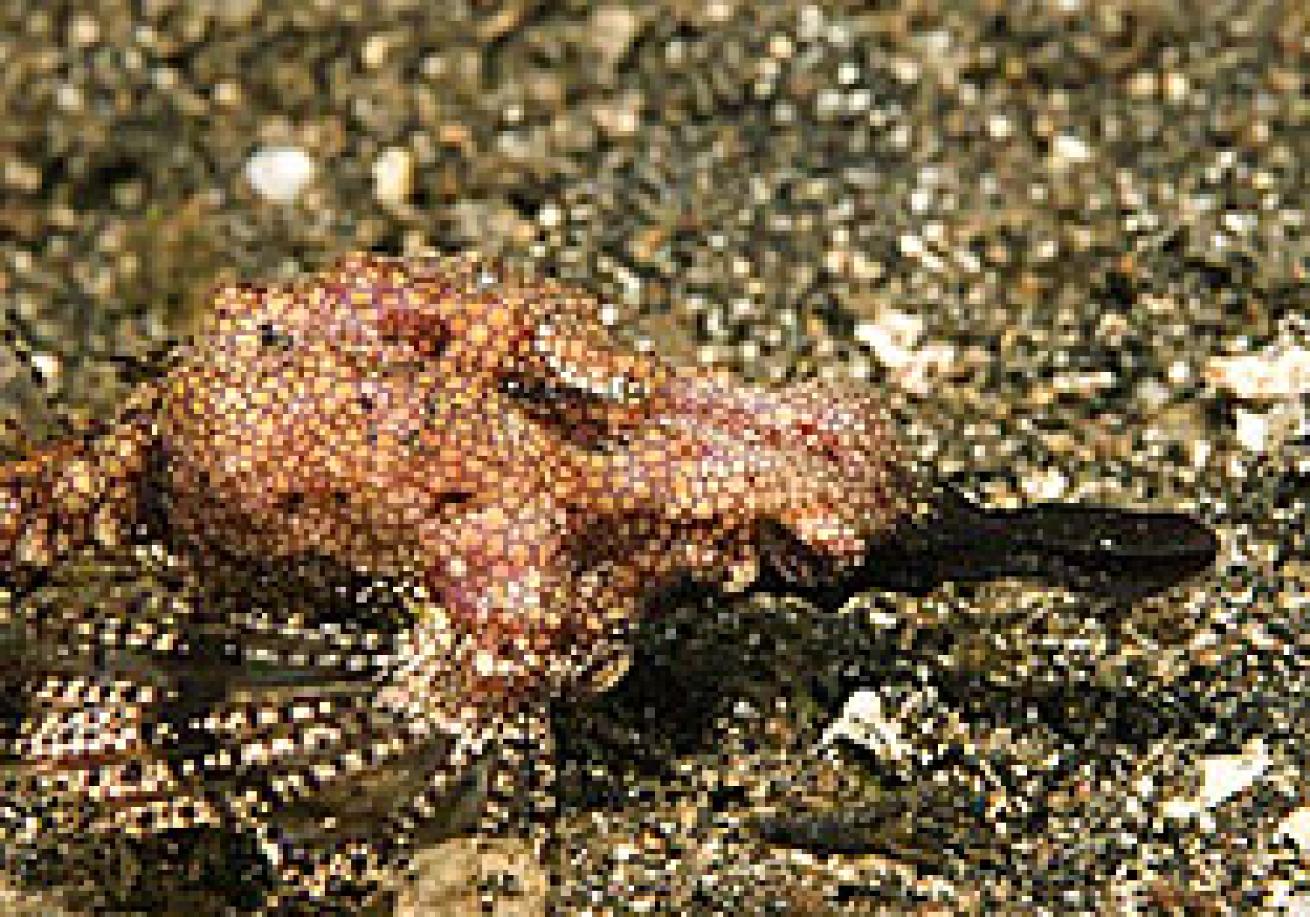
Here we tied up to the rock face of the island and dropped into a sloping sand reef rimmed by coral and sponge encrusted rock buttresses. We were briefed to expect to see the Pegasus sea moth, and sure enough that was the very first thing we saw just under the boat in 18 feet of water. Likewise true to the briefing, there were pygmy seahorses on a sea fan at 60 feet. This was really quite a special site, for it combined the black sand environment with a lush coral wall. A casual walk-about of the main salon after two dives at Nudi Retreat revealed laptops rich with octopi, filefish, clownfish, sea moths, pygmies, catfish, and a brilliant crimson clam with a mantle that curiously pulsated a band of white light.
Actually, everyone was pretty well blown away by this dive. Between the pygmies at 60 feet, the clown frogfish at 30 feet, and all the other unusual critters in between I dived this site 3 times this day. The second two dives started out with a pygmy photo-op on the 60-foot sea fan.
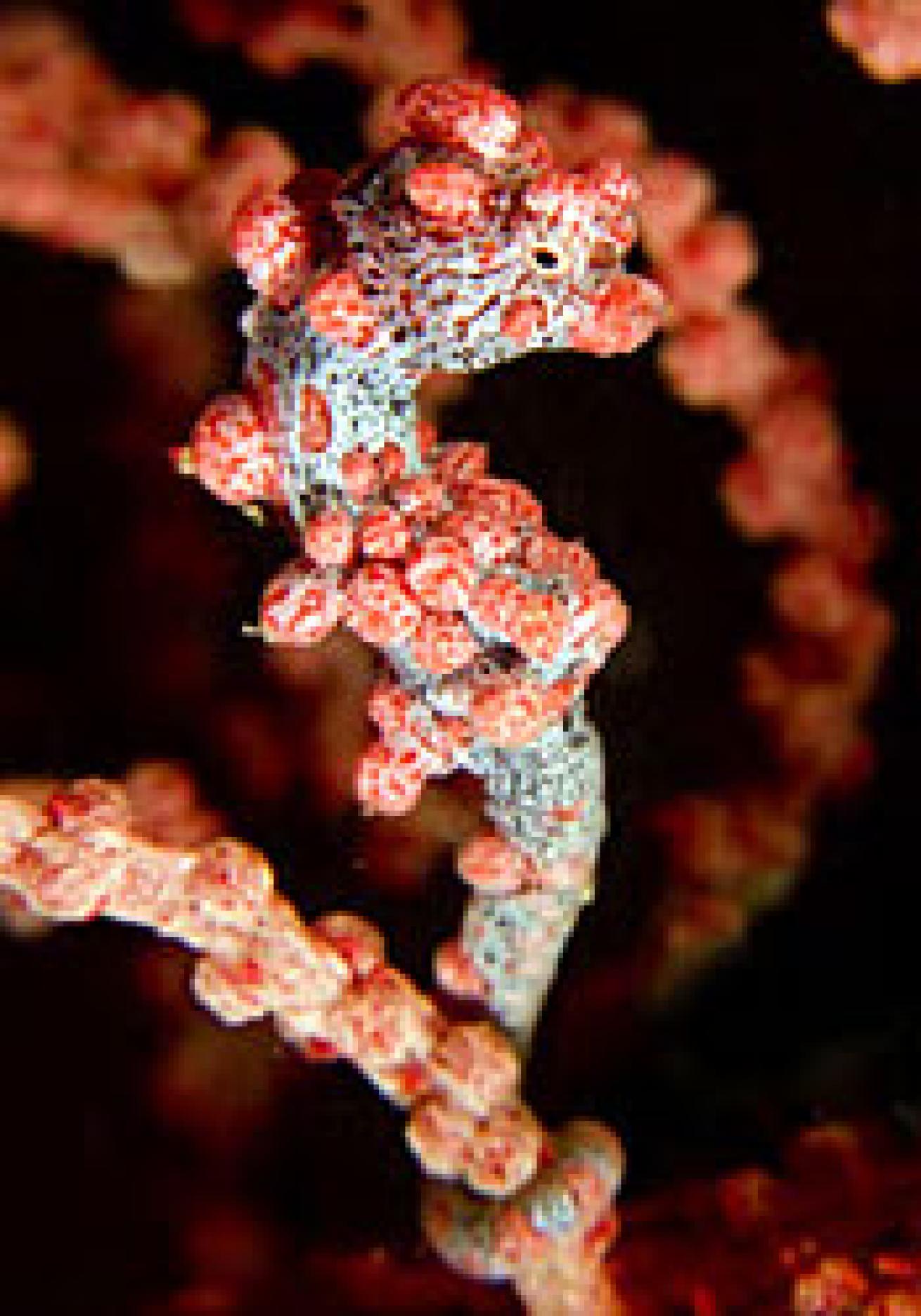
I knew exactly where the fan was from watching the line of shooters from above on the first dive, so I hurried to the fan on the second dive and essentially wasted 7 minutes of bottom time searching for the pygmy. I wear reading glasses, but can see things in the distance just fine, which allows me to pick out most subjects from far away. And, then when I put my Seacam S180 viewfinder to my eye, I have the internal diopter corrected for my vision so all is brilliantly sharp. But, with these pygmies are so very tiny, and so well camouflaged it takes pretty good eyes to pick them out from among the knobby polyps that they so nearly resemble. Fortunately, by the third dive I had a system worked out with my dive guide. He would use the small tip of a dental tool to give me a focus reference nearby the seahorse, never touching or harassing the seahorse in any way, but giving me something other than a field of red texture to focus on. Once I was locked in he would move away and I would watch the scene until the seahorse would randomly move back facing me. As the bottom-time clock ticked away I didn't dare glance at my dive computer or my camera's histogram for fear of losing sight of my subject. But, after a dozen or so shots (Canon EOS1DsMKII, full frame digital, at 1:1 with Seacam Wet Two external diopter bringing the magnification to nearly twice lifesize) I was pretty sure I'd nailed at least one and was able to move up the wall the shallower depths and move on to more leisurely photographic pursuits.
A note on pygmy seahorse photography
These are one of the iconic subjects in this region, and the guides at both KBR and aboard Aggressor are very skilled in finding and pointing out. However, as with all marine creatures, some are larger than others, and when working at the extreme edge of the magnification possible by a specific macro rig, every little bit helps. A slightly larger specimen, like we found the next day at Nudi Falls is a bit easier, and of course if you're really lucky, finding multiple seahorses to occupy the same frame is better still. Even then, a little judicious cropping may help to fill the frame. With these guys, 1:1 magnification just may not be enough, and some form of diopter of teleconverter may be advisable.
Day 6 - Nudi Falls and Critter Hunt
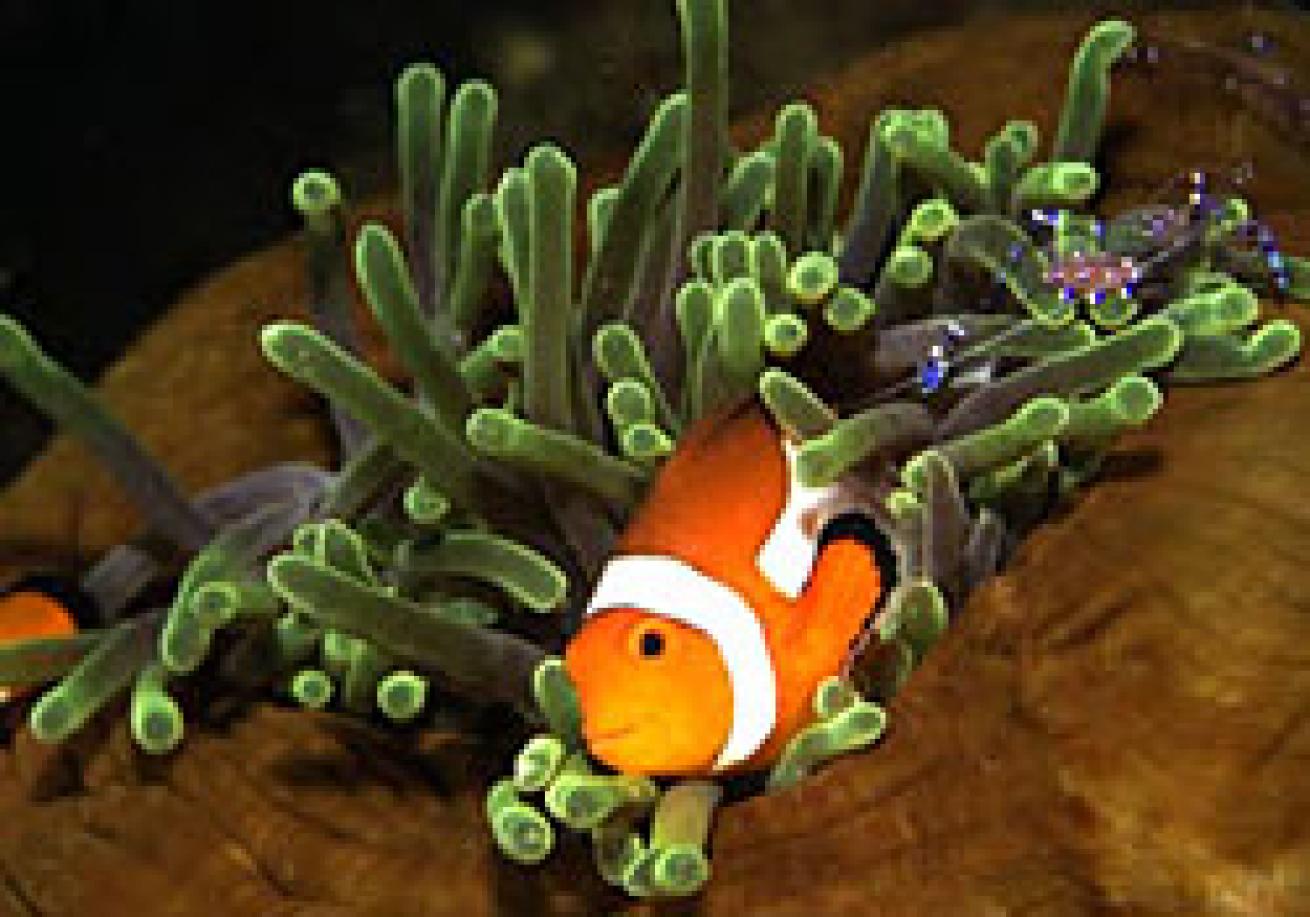
This is our last day of charter aboard the Aggressor, and we are anchored just offshore of KBR. With our flight in the early afternoon tomorrow we are limited to just two dives this morning. The first is to Nudi Falls, like most about a 3-minute boat ride from the mother ship. We are briefed to expect to find a sea fan with Hippocampus at 54-feet, and sure enough, there it was. Because it was so close to a sand and rubble bottom, this was an easier place to lay on the bottom without impacting any coral and brace an elbow to get steady for the macro shots. However, this dive was about far more than just the seahorse, and the mini-wall is incredibly rich with medium and small size critters. Among my more productive subjects were cleaner shrimp on a clownfish and anemone habitat and various lionfish and pufferfish. But, there was so much to shoot this dive I found myself rounding out the portfolio of images from the week. I'm sure the subjects I concentrated on this last day would be different than those I might have shot earlier in the week, but Nudi Falls offered excellent variety and a nice change from the black sand backgrounds.
Critter Hunt was much the same for me in terms of wrapping a few subjects that had eluded me earlier. While some of the guests dropped to the 60-foot range with the guides to look for Rhinopias, I found a cooperative juvenile sweetlips in only 20-feet of water. Their swimming pattern is so very erratic it takes a lot of shots to get them sharp and properly composed, and I'd had difficulty earlier trying to photograph different juvies. This one I nailed. As the clock ticked down to 60 minutes on my last dive of the trip I found a large cluster of long-spined sea urchins, and hiding in their midst was a school of banngai cardinalfish. I found it ironic that the first shutter click at KBR was this fish, and now 10 days later I've finished my underwater shoot with a final shutter click on the same species of fish.
The last afternoon
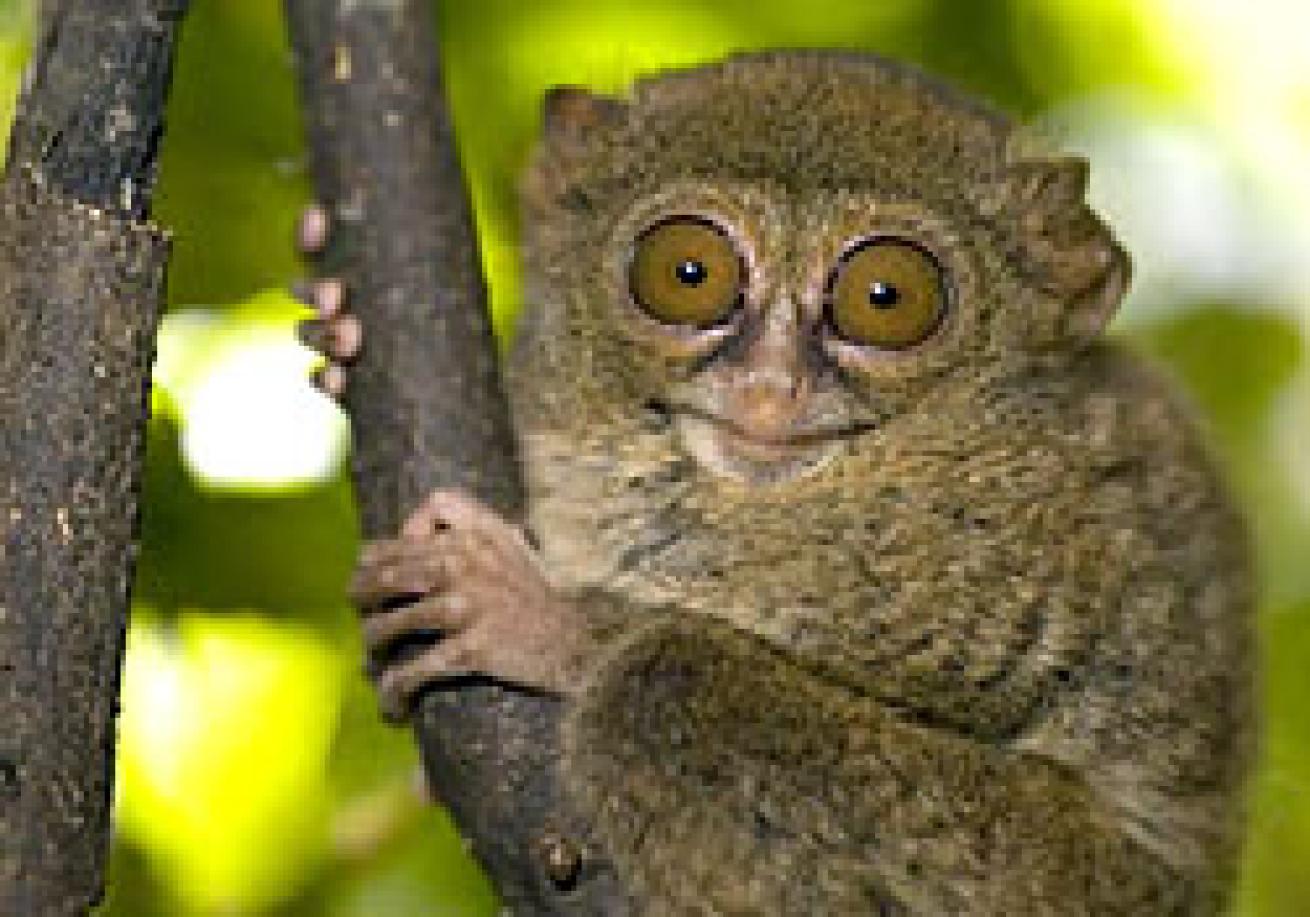
Very near the boat's anchorage there is a local gentleman who has developed an interest is collecting indigenous animals from North Sulawesi, It is not a zoo, as he is clear to point out, but his personal collection of creatures caged at his home. However, Aggressor guests are welcome there, and several of us did the tour. He had sea eagles and bats in his aviary, as well as cobras, a massive python, various monkeys, crocodiles, and a very strange wart hog kind of creature found in the island's wilderness. The highlight, photographically, was the close encounters with the taursius monkey, which they claim to be the world's smallest primate. At about the size of a softball, it was tiny and very cute indeed, but I'll leave it to some zoologist more knowledgeable than me to say whether this is without doubt the world's smallest.
On the way, LAX to Manado, we ran into photographer Marty Snyderman and on the way home via Singapore chatted with pro cinematographer Chuck Nicklin. I heard Tony Wu from Fins Magazine was there at the same time too. I think this probably isn't so unusual ... that most serious shooters find their way to North Sulawesi sooner or later. But, on the other hand I know a nonphotographer who dived the area with his photo-intense wife and found black sand muck diving most boring dive holiday he'd ever taken. Clearly, the attractions are not for everyone, but for those who appreciate the unique environment and its special denizens, this is an absolutely world-class destination.
Travel Miscellany
For those wishing complete Indonesia health advisory, please see:
http://www.cdc.gov/travel/seasia.htm
The State Department's travel advisory to Indonesia is at:
http://travel.state.gov/travel/cis_pa_tw/tw/tw_918.html
To research travel and dive specifics at KBR, visit:
http://www.divekbr.com/faqtext.html
Water Temperature - Among other info posted there is water temperature at 76-82 degrees. For me that means a 3mm suit and hooded vest. Others may prefer a 3/5/3 suit for multiple dives per day.
Health Care Imperatives
from www.aggressor.com
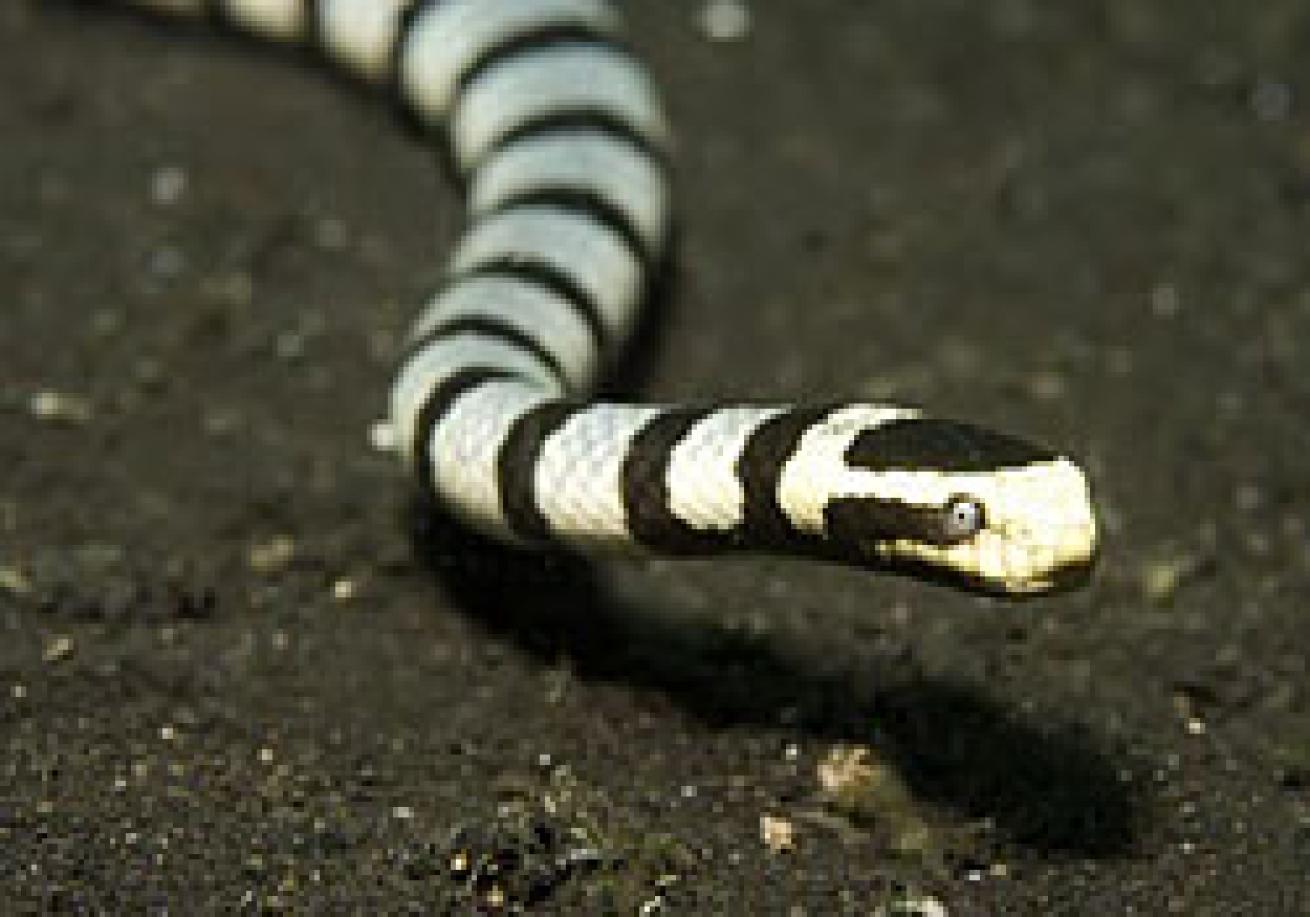
We have a first aid kit on board, including oxygen and a defibrillator. You may want to bring motion sickness medicine if you feel you'll need it. However, because of the size, comfort & stability of the North Sulawesi Aggressor, we have never had a serious problem. We also recommend an antibiotic, antihistamine, eardrops, & topical ointment.
North Sulawesi is not known to have any high incidence of malaria. However, check with your local travel med clinic just to be on the safe side.
If you are subject to reactions from stings of any kind, we recommend that you bring any medications that you may need. Please inform the captain and crew about your condition so proper steps may be taken in the case of an allergic reaction or stings. Please inform your dive guide(s) if you are taking any medication or suffer from allergies. A complete physical is recommended before your trip. There is no smoking allowed inside the vessel or the dive deck. Smoking is only permitted on the sun deck. The nearest recompression chamber is in Manado. This facility has a fully operational recompression Chamber; a blessing for Indonesia live-aboards.
Be sure your tetanus & Hepatitis A immunizations are up to snuff. Check with your local MD.
International health certificates for smallpox and cholera is not required, except from travelers arriving from infected areas.
Malaria? - Based on this information, I did not take malaria medication for this trip. However, you will make your own informed decisions in this regard, preferably after speaking with your physician. For me, when in malaria-prone regions, malarone (www.malarone.com) is my preferred medicine as it has no side effects that mimic or mask decompression symptoms.
Upon arrival in Indonesia you will obtain "visa on arrival" processed at gate of entry. YOU MUST HAVE A PASSPORT WITH AT LEAST 6 MONTHS REMAINING VALIDITY. GO LOOK AT YOUR PASSPORT NOW! I say this because I, and others who travel with us, have been bitten in butt by having less than 6 months on passport. It can be very expensive to correct, and with a live-aboard, you could miss the trip entirely. The visa will cost $25.
North Sulaweisi Aggressor
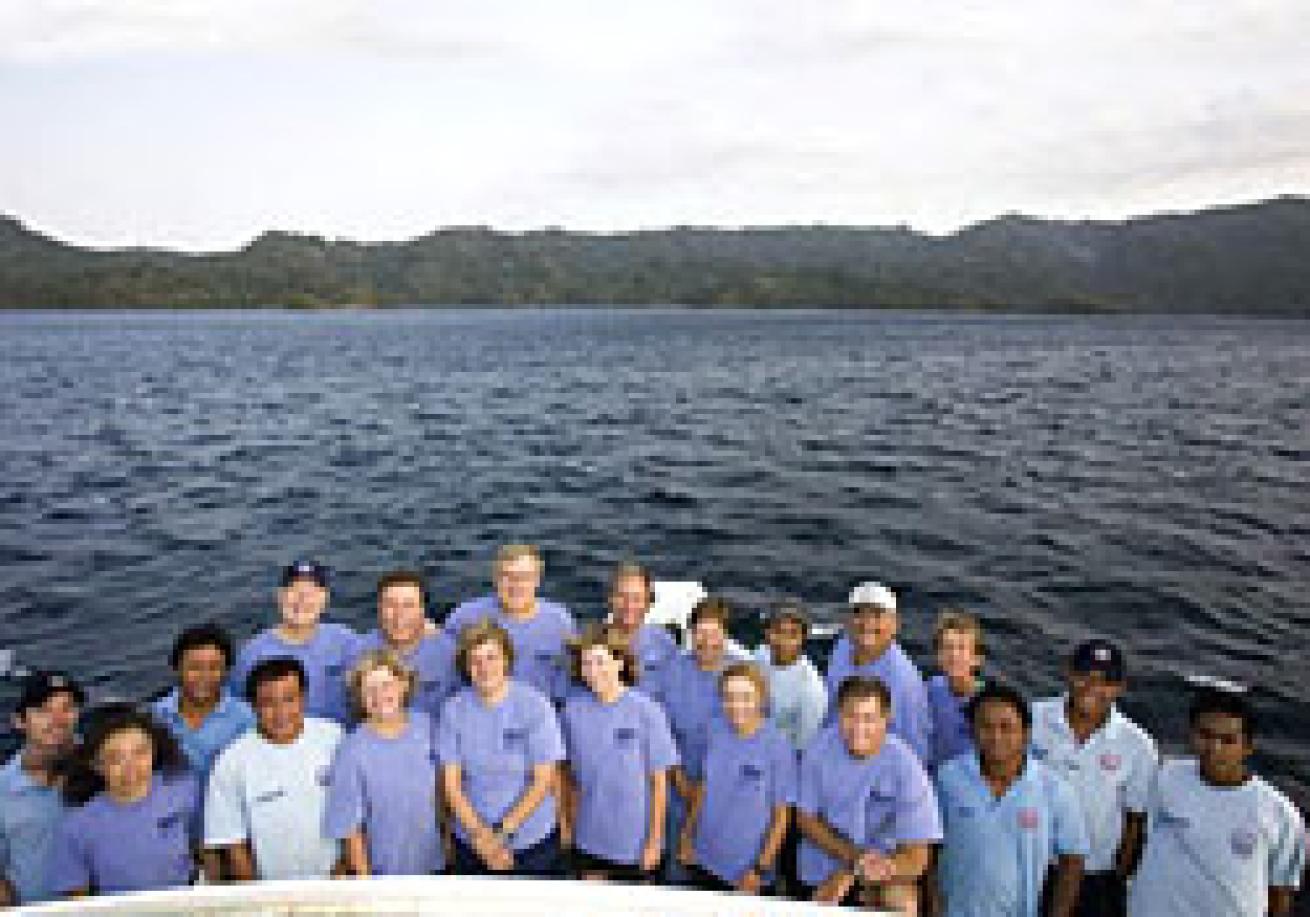
While the North Sulaweisi Aggressor is configured to accept 18 guests, this requires the use of one cabin as a quad. Recognizing that our guests prefer double occupancy cabins, and also because many of the cryptic creatures we'll be stalking are more accessible to smaller groups of UW photo enthusiasts, ours was a Limited Participation Tour for just 16 guests.
The information below is available at www.aggressor.com:
North Sulawesi Aggressor - Know Before You Go
**Contact Information
Office Hours:**
Mon-Wed, Fri: 8-7 CST
Thurs: 9-7
Sat: 9-1
Sun: closed
Office (USA):
+1-985-385-2628
[email protected]
www.aggressor.com
Cell Phone:
After Hours +1-985-714-1300
(emergency or delay in travel only)
North Sulawesi Aggressor Office (Hawaii)
Phone: 1-800-344-5662 or 1-808-329-8182
E-mail: [email protected]
Fax: 1-808-329-2628
M/V North Sulawesi Aggressor:
Boat E-mail: [email protected] or [email protected]
Boat Cell: 011-628-135-6022362 or 011-680-488-1755/2009
Sat Phone: 011-881-621-443-437
Fax: 011-680-488-5245
KBR Resort: 011- 62-431-823-444
Communications In North Sulawesi
The Aggressor Fleet Limited office and the North Sulawesi Aggressor is in constant communication. In the event of an emergency, family and friends may contact you at the above numbers. If you need to reach the vessel, please call or e-mail the boat. There is an onboard satellite phone for incoming and outgoing satellite phone calls and e-mail. There is a charge for this service. Prepaid e-mail cards are available for purchase onboard.
To ensure the timely arrival of your luggage into North Sulawesi, we recommend re-checking it at the ticket counter before your international departure to North Sulawesi. Don't forget to use your Aggressor luggage tags. They will help the crew identify your luggage.
Passports & Documentation
Visitors must have a current passport valid for at least six months prior to departure date, adequate funds to support themselves and a return airline ticket. Visitors must also have a blank page for the Indonesian visa to be stamped upon arrival. It is the travelers' responsibility to ensure that you have the proper documentation to travel to the destination and return to their country. Please check with the appropriate consulate to ensure you have the proper documentation. Always check your passport and visa requirements. Please note: Any stay longer than 30 days; regardless of country of origin must apply for a permit from their local Indonesian consulate. Aggressor Fleet Ltd. cannot assume responsibility for passengers not having correct documentation.
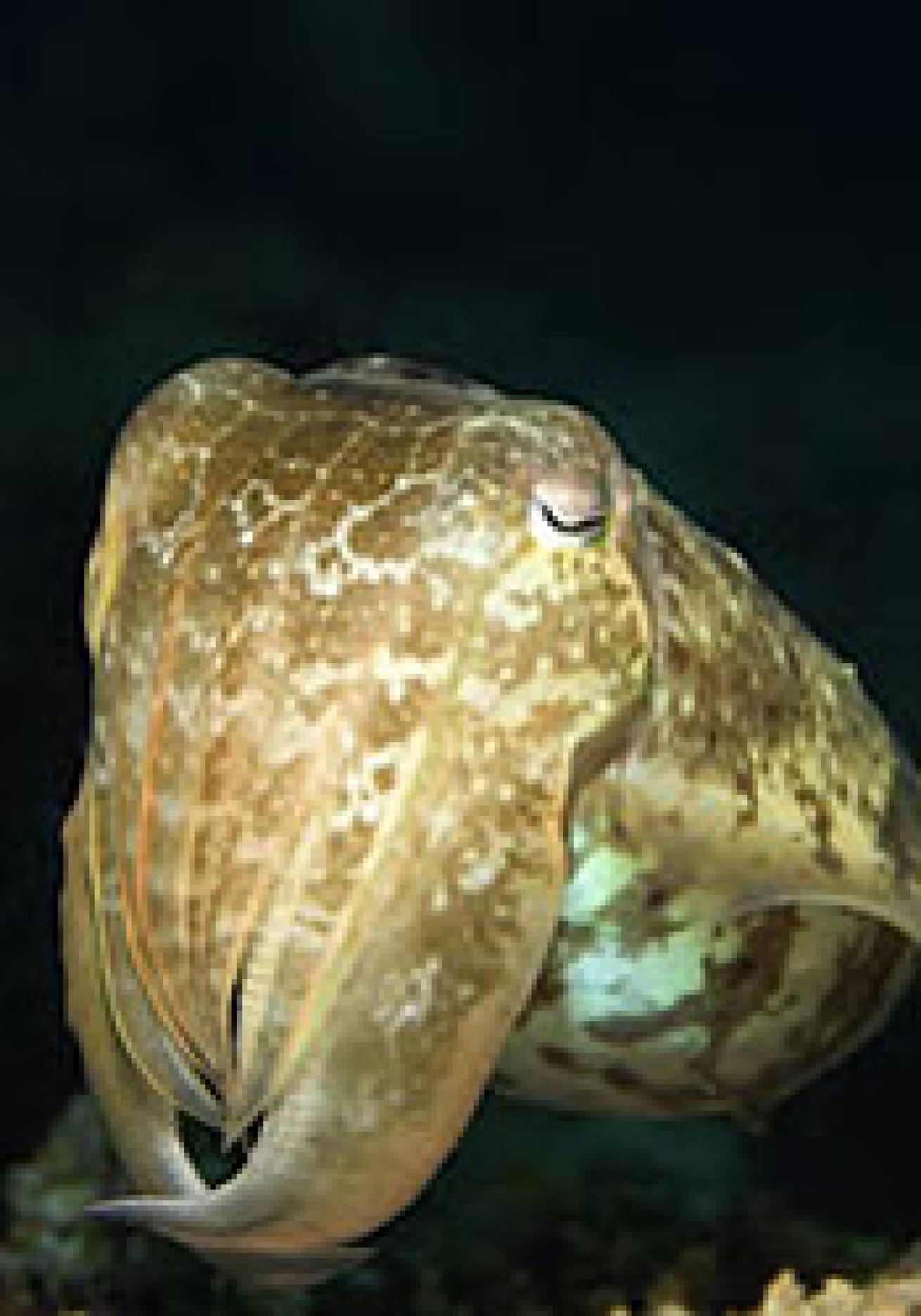
Taxes And Fees
U.S. Citizens are required to obtain an entry Visa upon arrival at a cost of $25.00 USD and $10.00 USD upon departure. A $100.00 per person fuel surcharge will be collected on board at the end of the charter. This fee may be charged to your credit card. The airport departure tax is $20 upon departure.
C-Cards & Dive The World Club
Please bring your c-card or proof of certification. The divemaster requires proof of certification before the first dive.
If you are a member of Aggressor Fleet's Dive the World Club, you will receive on board discounts. Your membership is indicated on the Captain's rooming list.
Waiver & Application
Aggressor Fleet, Ltd. and the North Sulawesi Aggressor require each guest to complete and sign an application and waiver form prior to departure and diving. The completed and signed Application/Liability Waiver must be received by the Aggressor Fleet, Limited at least 60 days prior to departure. Passengers who fail to fax or mail it will be denied boarding Due to Indonesian law, the North Sulawesi Aggressor has to obtain a clearance to cruise Indonesian waters prior to your arrival. If they don't receive your passport information on the Aggressor Application/Liability Waiver 30 days prior to the departure date, you could be denied boarding upon arrival to the boat. If you did not receive a waiver from your agent, please download one from www.aggressor.com, and fax it to 985-384- 0817.
Insurance
Every effort is made to ensure you have a safe trip However, unforeseen circumstances can and do happen. We strongly recommend the purchase of trip cancellation insurance as well as accidental, medical, and baggage insurance. We recommend Divers Alert Network (DAN) Insurance or an equivalent insurance.
Health
We have a complete first aid kit on board, including oxygen. You may want to bring motion sickness medicine, if you feel you'll need it. Please inform the dive guide(s) if you are taking any medication or suffer from allergies. We recommend a complete physical before your trip.
There is no smoking allowed inside the vessel or on the dive deck. Smoking is only permitted on the sun deck. The nearest recompression chamber is in Manado. This facility is fully operational.
Packing
When packing, please limit the weight and size of your bags. For international travel, you are usually allowed 2 bags. Please check with your domestic and international carrier for baggage allowance.
If possible, we recommend you pack a regulator, mask, fins, swimsuit, change of clothes, medication and toiletries in your carry-on bag. Having these few items with you can make an unexpected luggage delay more bearable. Also, if you are taking camera equipment, we suggest you hand carry it on to the plane.
Arrival
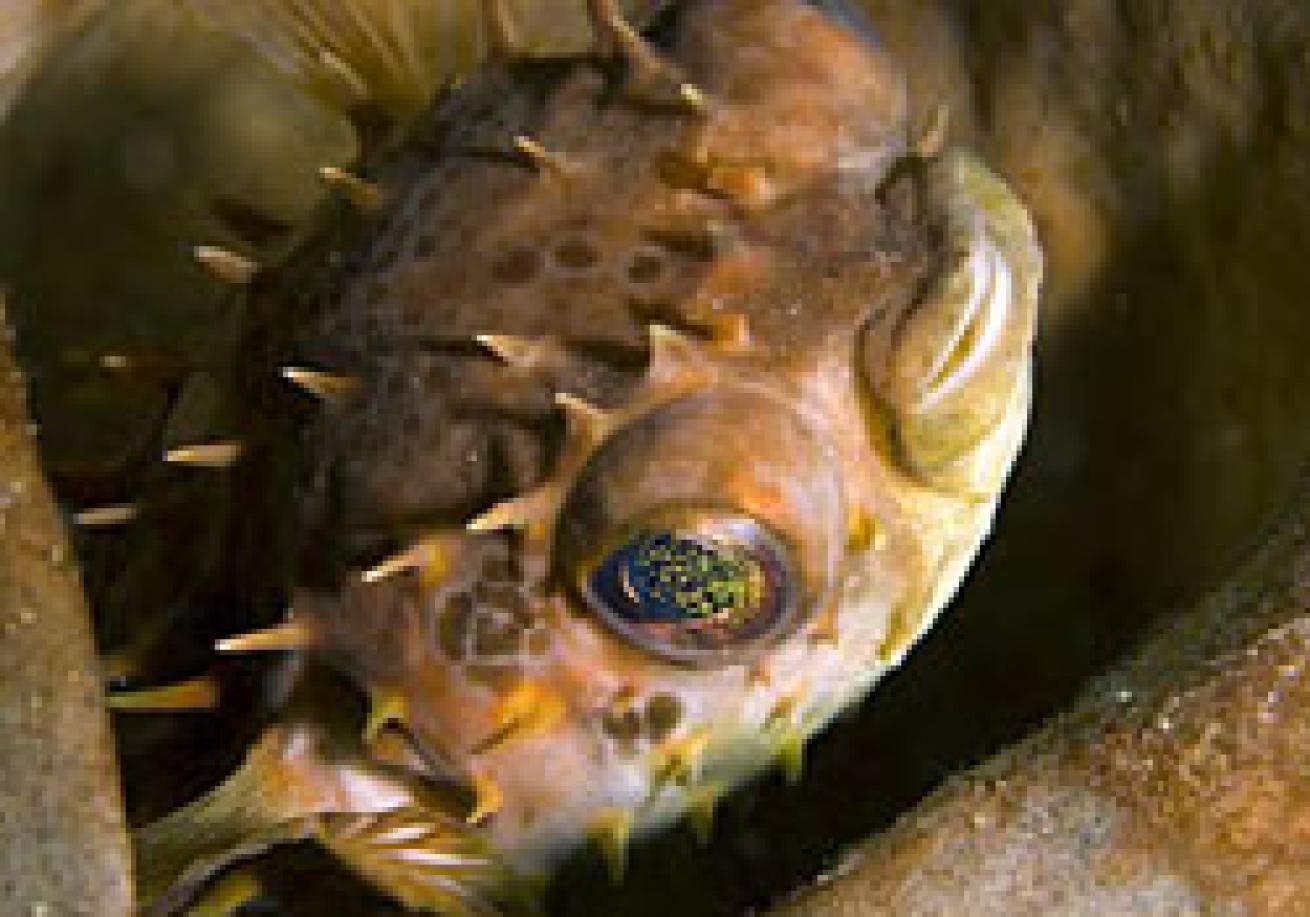
The North Sulawesi Aggressor offers charters departing from the Kungkungan Bay Resort in the city of Bitung, Indonesia. You are encouraged to arrive Saturday afternoon into Manado on Silk Air that arrives into Manado at approximately 12:55pm. Upon arrival, a staff member from the Kungkungan Bay Resort holding a sign with the Aggressor Fleet logo will greet you. You will be transferred to the KBR in an air- conditioned bus. The bus ride takes approximately 45- 60 minutes.
If you arrive earlier in the week and are staying at a hotel in Manado, you will need to make your way to the Manado Airport. Transfers from the Manado Airport will leave on Saturday at approximately 1:30 pm after the guests traveling on Silk Air arrive. We will need to know one week before your charter date if you will be meeting the group at the airport in Manado. This will be the only transfer provided for the upcoming charter week on the North Sulawesi Aggressor.
If you are staying in Bitung at the Kungkungan Bay Resort, you will require no transfer as the North Sulawesi Aggressor docks right off of KBR. Boarding time for everyone is 3:00 pm on Saturday.
The Vessel
The North Sulawesi Aggressor is a 110-foot yacht, built and powered for comfort, safety and stability and built to U.S. Coast Guard certification standards. She is diesel-powered, cruises at 10 knots and has 110-volt power on board. The North Sulawesi Aggressor has a beautiful spacious salon, 50 feet of sun deck with shading, chaise lounges, hot tub, deck chairs, bar, grill, and a complete digital photo/video center.
Accommodations include eight private, air-conditioned cabins. There are seven double cabins and one "quad" cabin for four guests. Each stateroom has extra storage and individual climate controls. The North Sulawesi Aggressor sleeps 18 guests and six crew, in privacy and comfort. Diving amenities include Nitrox and a large dive deck complete with individual dive lockers and freshwater showers.
Meals
The menu on board is varied and plentiful, with a variety of American feasts, barbecues and local cuisine. Wake up to fresh fruits, hot entrees, cereals and juices. Lunches are buffet-style, featuring hot soups, homemade breads, salads and sandwiches and/or entrees. Dinners are diverse, including seafood, beef or chicken. Each evening, enjoy fresh homemade desserts. Please notify our office of special dietary requests. Feel free to bring your favorite candy or snack.
FAQs:
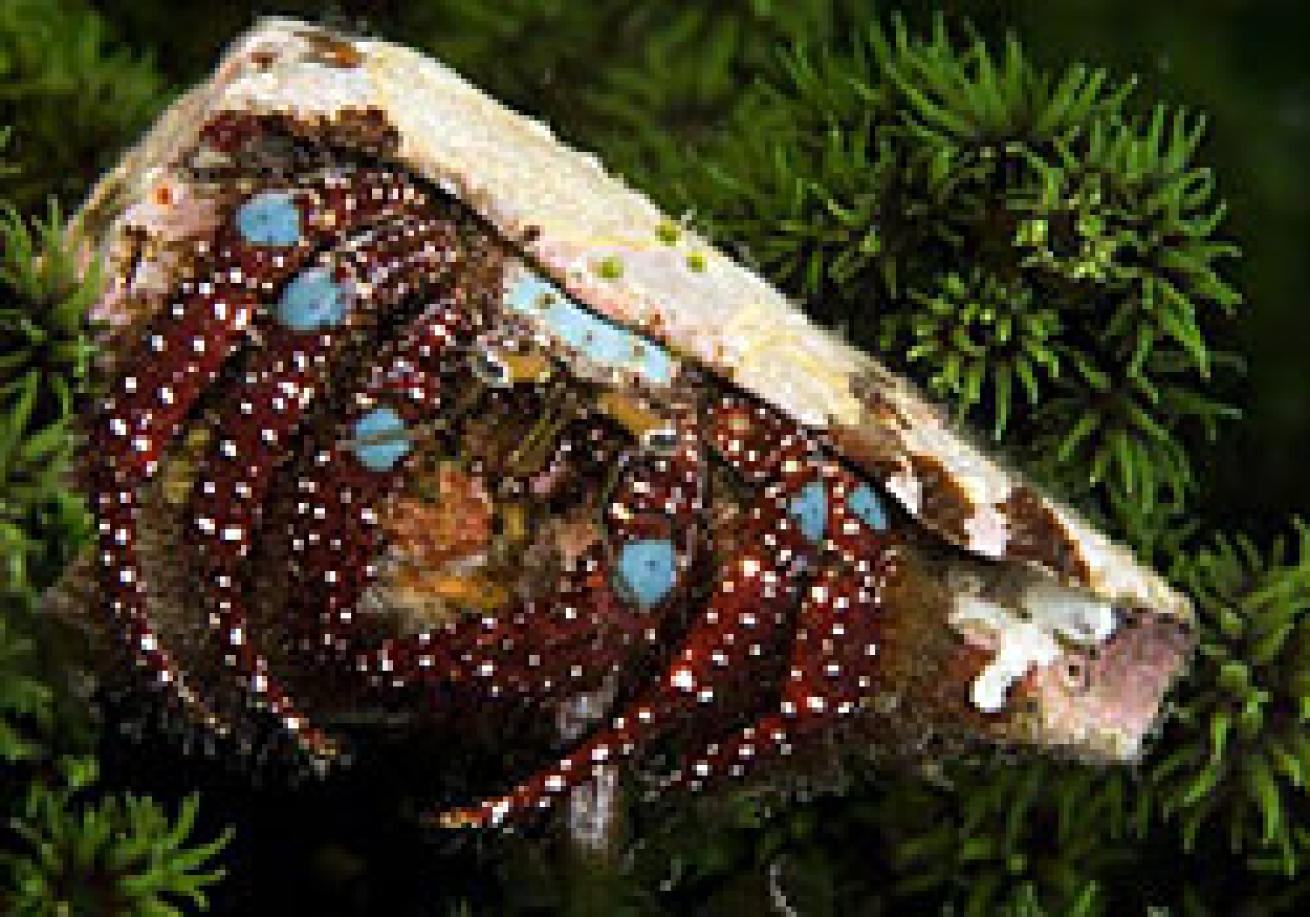
1. Where is North Sulawesi? North Sulawesi is in the northern most part of central Indonesia. It is just south of the Philippines in the North Pacific Ocean.
2. What is included in the charter? Accommodations aboard the vessel, diving, compressed air tanks, weights and weight belts, airport transfers from the Manado Airport on day of arrival and departure, meals and snacks, soft beverages, local beer and wine are include in the charter rate.
3. How many days is the charter and how many dives can I make? The North Sulaweisi Aggressor charter is seven days, Saturday afternoon to Saturday morning with five and one-half days of diving. Most guests make up to 5 dives a day. Diving begins on Sunday morning and finishes midday on Friday when the Aggressor return to the dock.
4. When should I arrive in North Sulawesi? You should plan to arrive in Manado on the day of your charter, Saturday.
5. Do I need a passport? Guests are encouraged to arrive Saturday afternoon into Manado on the Silk Air flight that arrives into Manado at 12:55pm. Upon arrival, a staff member from the Kungkungan Bay Resort holding a sign with the Aggressor Fleet logo will greet you. You will be transferred to the KBR in an air-conditioned bus. The bus ride takes approximately 45-60 minutes.
6. How do I meet the North Sulawesi Aggressor on the day of departure? Guests are encouraged to arrive Saturday afternoon into Manado on the Silk Air flight that arrives into Manado at 12:55pm. Upon arrival, a staff member from the Kungkungan Bay Resort holding a sign with the Aggressor Fleet logo will greet you. You will be transferred to the KBR in an air-conditioned bus. The bus ride takes approximately 45-60 minutes.
7. Where does the North Sulawesi Aggressor dock? The North Sulawesi Aggressor offers charters departing from the Kungkungan Bay Resort in the city of Bitung, Indonesia.
8. What is special about the diving in the North Sulawesi? The Lembeh Strait and surrounding areas are believed to offer the world's most divers marine biodiversity. The outer reefs are adorned with colorful soft corals and anthias. North Sulawesi is world-famous for its "muck" dives, or critter dives, where small, colorful creatures dwell on sandy bottoms. Despite the term "muck diving," visibility is very good.
9. What is the water temperature? Will I need a wet suit? You'll be diving in warm water that averages 78 - 82F degrees. Most divers are comfortable in a 3mm suit.
10. What is the best time of year for diving? The diving is very good year round. Wet Season in Indonesia is from November through February however; it is less changeable in Lembeh Strait due to the mountainous terrain surrounding the area.
11. What type of topography can I expect to see in North Sulawesi? The topography ranges from volcanic mountains to coconut plantains to rice paddies. The islands also have numerous scenic waterfalls and lush rain forests.
12. Is there dinghy diving? Most of the dives are made from two large skiffs. Some diving is done from the back deck of the Aggressor.
13. Is there night diving? Yes. The night diving is terrific.
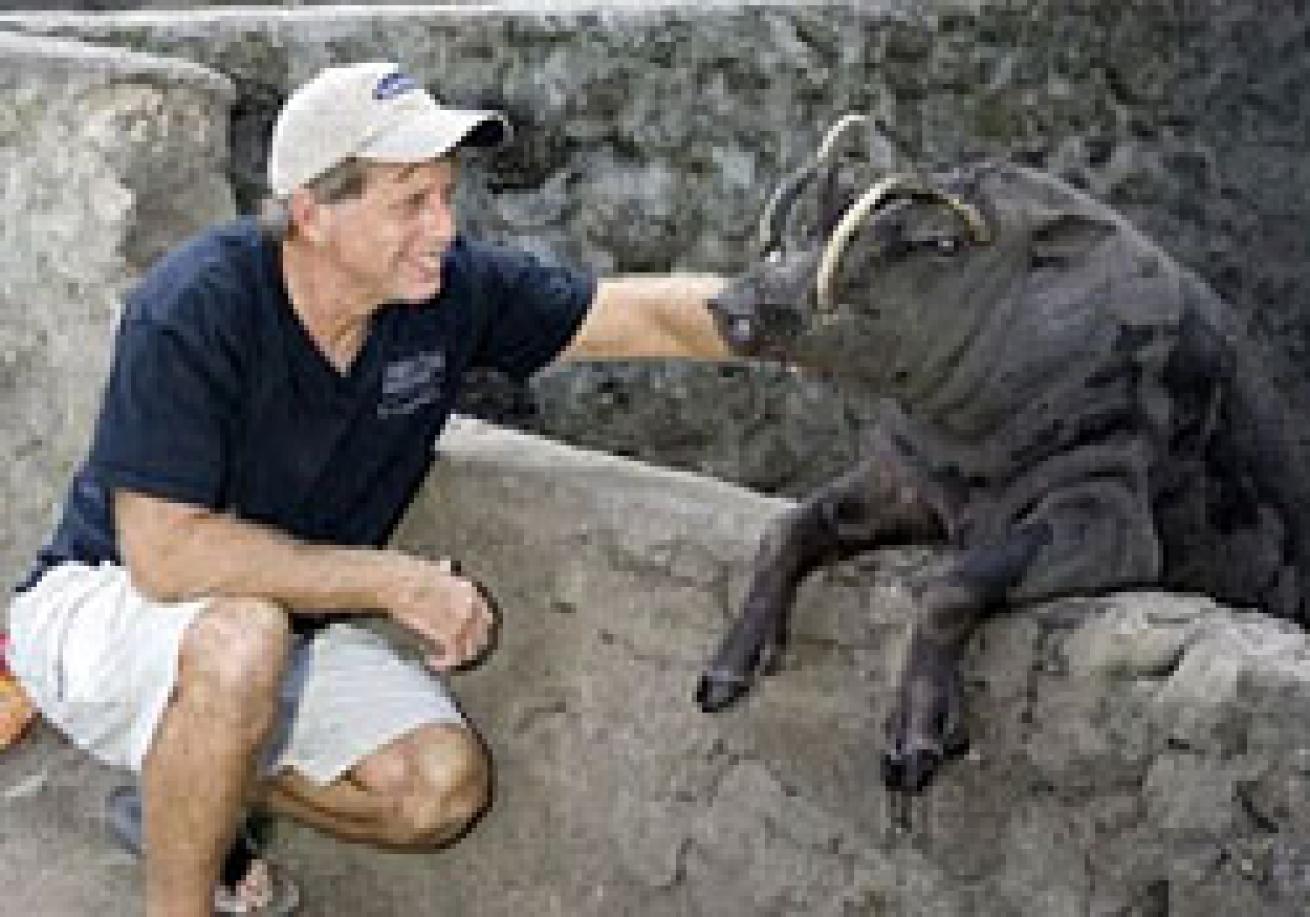
14. Are extended tours offered in Bitung? Special tours include a full day trip to Tangkoko Batuangus Nature Reserve and are home to the Taursius Monkey, the world's smallest primate, the black tailless monkies, Maleo birds, wild pigs, the Bear Cascus (Marsupial family), the Sulawesi Rousette and the Dog Faced bats and a multitude of parrots. These are trips into nature and the past not to be missed. There is also white water rafting trips for those with an adventurous soul that can't get enough of the water. Of course, there are numerous fantastic shore dives from the KBR right outside your bungalow. Also available is the tour of Bitung City and the open market. This trip will give you a real taste of Indonesian culture and close encounter with the friendly citizens. The open-air market presents a great chance for unique photo opportunities.
15. Clothing on board - Bathing suits & t-shirts are the order of the day. Dress is normally informal in Indonesia due to the warm, humid climate & clothing of light fabrics are recommended. Traveling in highland areas is noticably cooler so we recommend a lightweight jacket. Accepted attire for men is a shirt & long pants. For ladies, dresses, blouses, & long pants are appropriate. Shorts, halters or tank tops should only be worn on the beach. The temperature averages in the mid 80's during the day & mid 70's at night. For easy luggage storage you should pack in a soft duffel bag.
16. INDONESIA DIVING PROCEDURES (for KBR and North Sulawesi Aggressor) - The crew of the North Sulawesi Aggressor, with their unique combination of talents, offers the ultimate in service. While on board, you may pick a buddy of your choice or dive with one of our crewmembers. There is ample storage space for your diving equipment in your personal locker. The North Sulawesi Aggressor provides 80 or 63 cubic ft. tanks, weight belts & weights. The maximum recreational depth is 110 feet. Diving is done from two comfortable custom-made high-speed skiffs.
17. ELECTRICITY LIVEABOARD - Power supply is usually 220 volt/50 cycles in large cities, but 110 volts is still used in some areas including on board the North Sulawesi Aggressor. Normal outlets are plugs with two rounded pins. It is advisable to check electrical devices before using to ensure that they can accept the power supply prior to using to avoid damage to your equipment.
Photography
From time-to-time I will have written articles that are highly relevant to the destination we are going to be photographing. In this case, with the small creatures of North Sulawesi, you might find the following of interest:
Capturing the Cryptic
Revealing the Hidden Beauty of the Coral Reef
Text and Photography by Stephen Frink
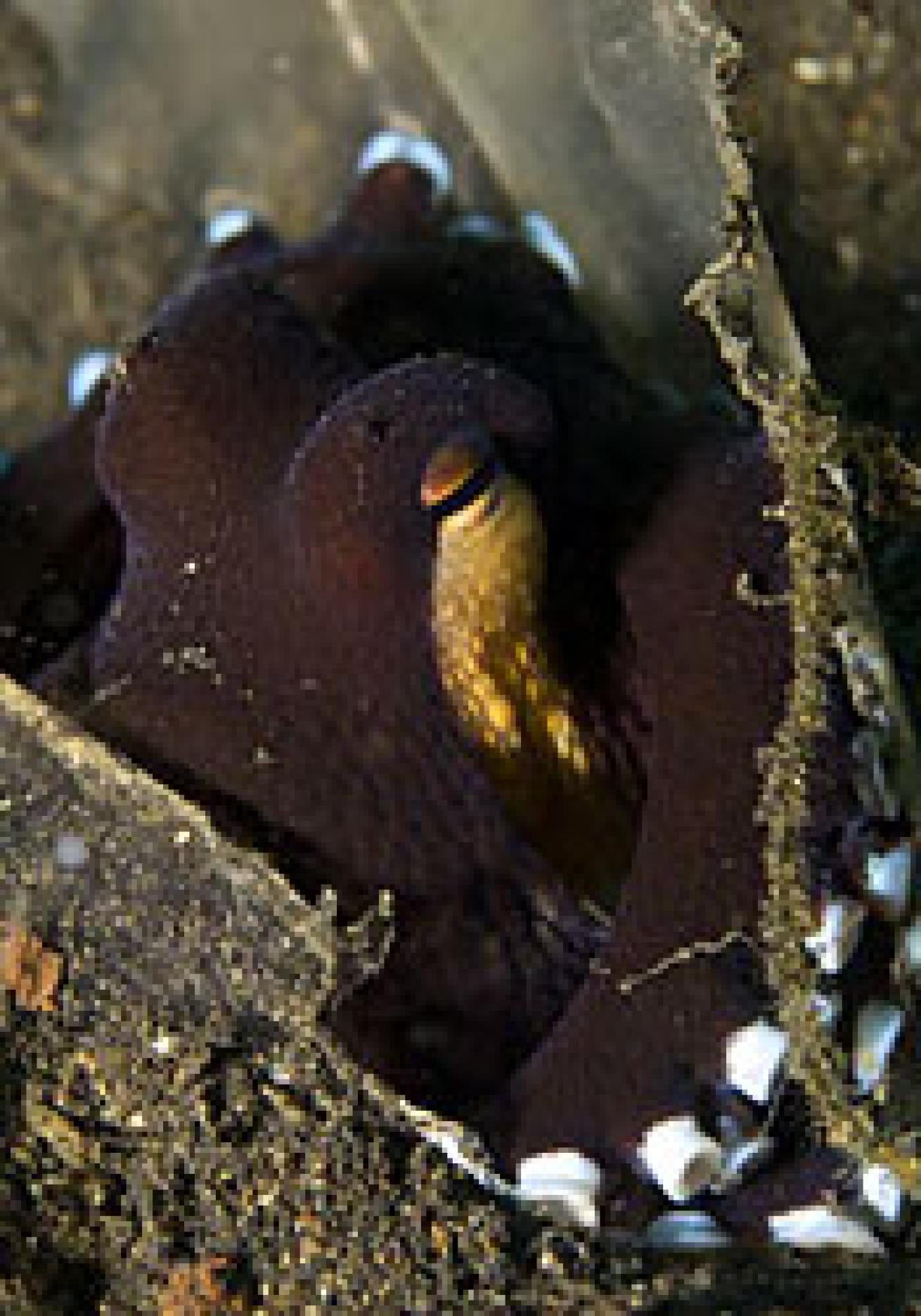
Many of the residents of underwater world are highly camouflaged. Obviously, their ability to blend into their surroundings protects them from predators, and facilitates their own efficiency as ambush predators. Some of these creatures are very small, and therefore difficult to discern, but some are just darn good at mimicking their backgrounds. Here are some tips about finding these creatures, and effectively capturing them on media once revealed.
- Listen to the Dive Briefing - I don't mean listen to them about which way the current is running, or whether you should keep the wall on your right or left. Those are stellar concepts to heed should you want to get safely back to the boat. But in terms of a photographic quest, the dive briefing will also probably communicate what creatures are likely to be found where. The local dive staff is an incredible resource when deciding what to shoot, and therefore gearing up photographically for the dive, and actually finding the subject once underwater. They dive these reefs every day, and they have been reinforced in either an altruistic or financial way for pointing out the best photo-ops on the reef.
Pay attention to where they say things might be, or better yet, dive with them and let them show you. I'm not sure I'd have a frogfish photo yet, without some divemaster somewhere showing me where they live. Once they point them out, I always think "Duh ... I could have found that", although the reality is I would have probably swum right by chasing something bigger. Then there are the pygmy seahorses, that are so small that even when they are pointed out I have to squint and think to myself "How the heck did anyone ever find these things even exist to begin with!?" Amid the color and distraction of the tropical coral reef, the small and fascinating things are often overlooked, and we should be tremendously appreciative of those with local knowledge who are willing to share.
|| |---|
| |
* Understand the Habitat - More often you have to "saddle your own broncs", my Louis L'Amour colloquialism for taking responsibility and finding your own subjects to shoot. To do so requires some knowledge of marine life behavior and where things live. Photographers like Roger Steene and Paul Humann have encyclopedic knowledge the specific environments that might host specific critters. They will look in the sand for flame dartfish or shrimp/goby combos. They'll look in the anus of a sea cucumber for a particular fish that might live there. They'll know where the cleaning stations are and realize they can capture behaviors there that might be significant on film. They'll see a tiny tunnel in the sand bottom and realize if they wait long enough a yellowhead jawfish will likely emerge. Their education and long experience in marine life biology gives them a huge advantage in knowing where to locate things to photograph, and their photographic skill will bring these compositions to life. Their portfolios of the bizarre and unusual creatures of the coral reef are quite inspirational; particularly when you consider the massive time commitment, the sheer hours underwater that are necessary to accumulate such an archive.
|
* Understand the Habitat - More often you have to "saddle your own broncs", my Louis L'Amour colloquialism for taking responsibility and finding your own subjects to shoot. To do so requires some knowledge of marine life behavior and where things live. Photographers like Roger Steene and Paul Humann have encyclopedic knowledge the specific environments that might host specific critters. They will look in the sand for flame dartfish or shrimp/goby combos. They'll look in the anus of a sea cucumber for a particular fish that might live there. They'll know where the cleaning stations are and realize they can capture behaviors there that might be significant on film. They'll see a tiny tunnel in the sand bottom and realize if they wait long enough a yellowhead jawfish will likely emerge. Their education and long experience in marine life biology gives them a huge advantage in knowing where to locate things to photograph, and their photographic skill will bring these compositions to life. Their portfolios of the bizarre and unusual creatures of the coral reef are quite inspirational; particularly when you consider the massive time commitment, the sheer hours underwater that are necessary to accumulate such an archive.
The cryptic creatures require an even more intimate understanding of their habits and environment, because they are not obvious at a glance. A branch of soft coral may host a coral crab, but it so closely mimics the sclerites embedded in the tissue mass, until one actually moves they are virtually invisible. With understanding of the habitat and the creatures that live there comes the discipline to wait and watch, knowing something unusual may just be revealed. Or not.
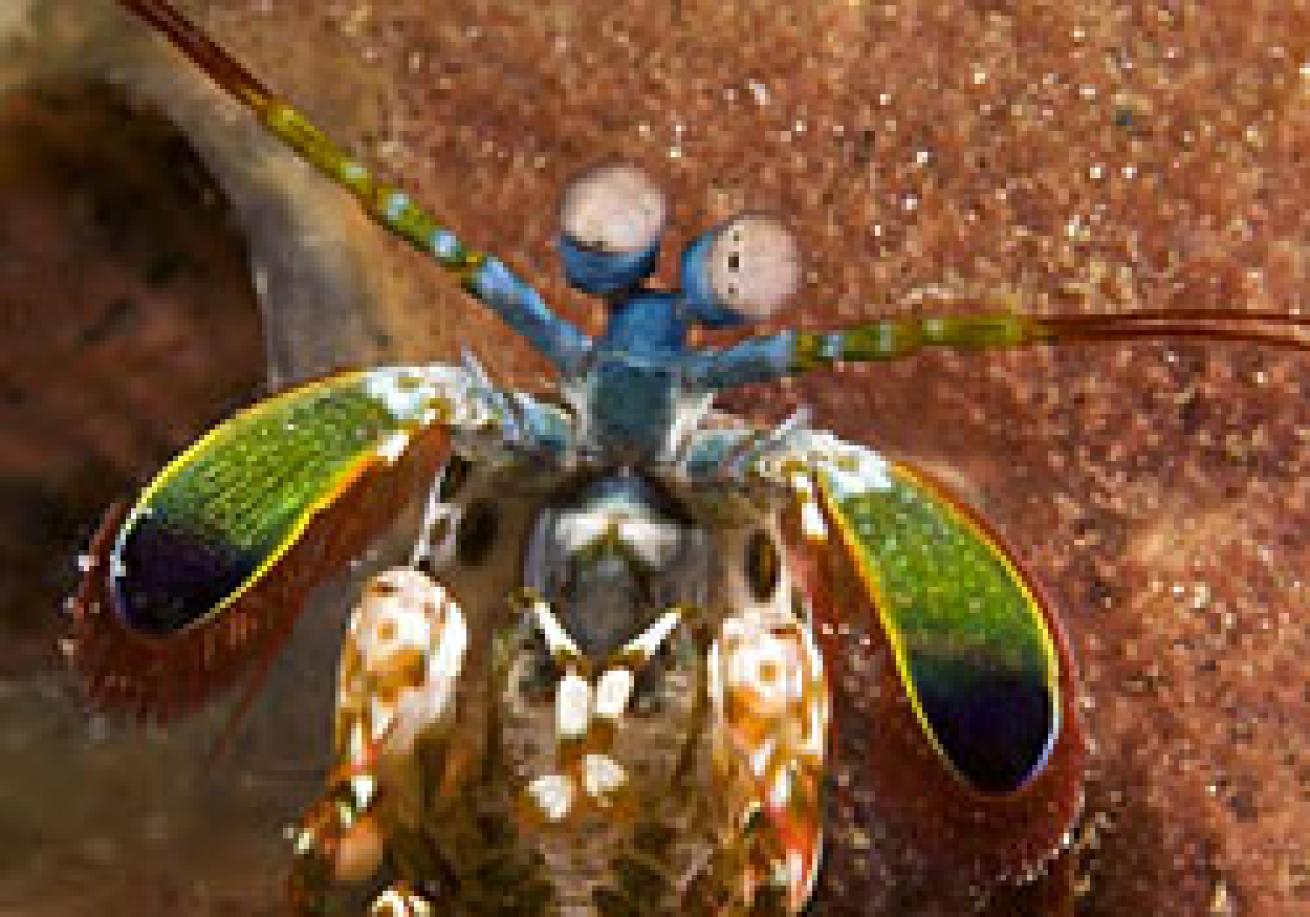
Enhance Your Vision - It probably goes without saying, but unless you can see well underwater, the small and visually confusing creatures of the reef will remain hidden. For young 20/20 eyes, maybe no enhancement is necessary, but for the rest of us a prescription facemask, or at least a set of adhesive close-up diopters in the corner of the mask will help. For me, I can see well in the distance, but wear reading glasses topside. That same optical correction, or greater, is useful when I am scouring that soft coral branch to find the camouflaged subjects. It is also very useful when reading the small type on the menu of my digital SLR! Note also that adding some light to the subject (either by means of a built-in model light like on the Ikelite DS125 strobe, or an external spotting light) can be an extremely useful visual aid.
- Choose the Right Optical Tool - The cryptic subject is often small, skittish, or both. To that end it helps to have a lens that will fill the frame with the subject from a distance, without intruding into the animal's "field of flight". In the old Nikonos days, not so long ago really, most of the cryptic macro subjects recorded were pretty inanimate. After all, it would take something devoid of mobility to allow it to be framed by the wands of a 1:1 extension tube. The 105mm Micro-Nikkor then emerged as the "go-to" lens for this task because it allowed full life-size (1:1) macro from 12.2 inches away. That meant you could get a tight headshot of a crocodilefish from 3 feet away, and then move in to a foot away and focus on just the eye. These continuously focusing macro telephotos are so very efficient that they are justification enough for using a housed single lens reflex camera, either film or digital, for underwater imaging.
To get even tighter requires the use of some supermacro tool like Seacam's new Wet Two external diopter, www.seacamusa.com, which has the advantage of being able to be added or removed from the port underwater. Alternatively, you could use a threaded diopter added directly to the lens inside the housing. Of course, with that solution you would be forced to shoot 1:1 or greater magnifications for the entire dive, but if the entire dive is going to be devoted to capturing an ultra-small critter like a pygmy seahorse, this is a fine solution.
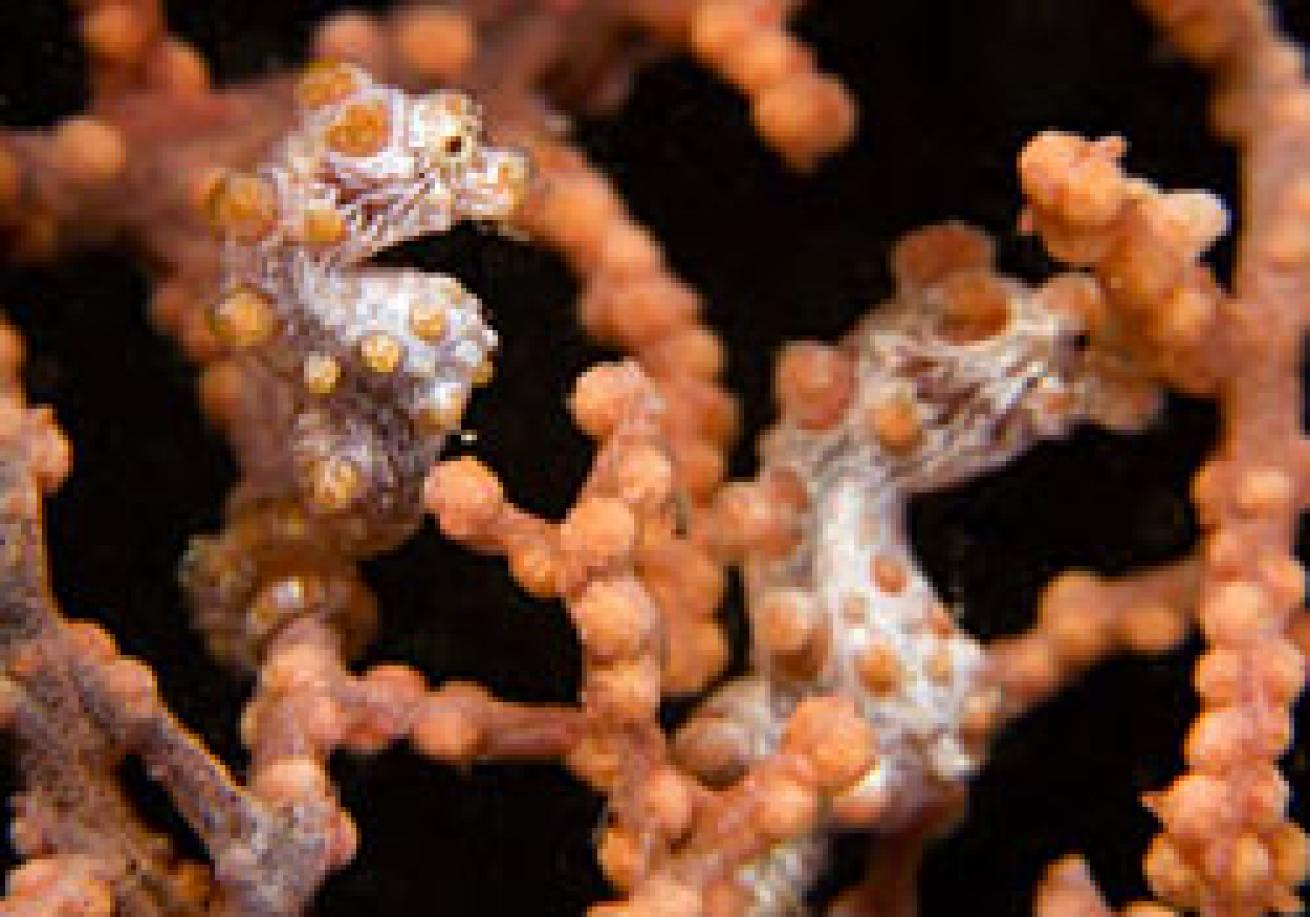
Use Negative Space to Enhance Composition - These cryptics are typically difficult to discern from their backgrounds, after all, that's what they do for a living. Arranging the composition so that the subject is in sharp focus and the background goes soft, or perhaps shooting at a hard upward angle to separate the subject from the background might be the viable solution to "show at a glance" the animal. Of course, maybe the point of the photo is to show the effective camouflage of the subject, in which case visual confusion works favorably. But, how many times can you really stop in the middle of a slide show and say "Here's a picture of a stonefish, you can't see it, but trust me that it's there and this is a really good picture of it!"
- Avoid the Photo Frenzy - While this may not directly related to "capturing the cryptic", it is inevitable that as you swim by a photographer photographing something indiscernible (but obviously interesting); there will be temptation to swim closer, look over their shoulder, belch a few bubbles, stir up a bit of sand, or worse yet, bump the photographer out of the way once you "discover" the fascinating little creature you just can't live without photographing. Don't. All of the above is very bad form, tacky and counterproductive.
The way I see it, the photographer owns the subject until willingly abdicated. Of course, the photographer should likewise have sensitivity about flashing the strobe too many times in a row if the creature seems sensitive to this intrusion. And the photographer should be aware of another shooter waiting patiently in the distance and may choose to invite that shooter to share the discovery. But, while the photographer is in the zone, concentrating on the composition or working the tiny depth of field that supermacro demands, any distraction is to be avoided. Unless there is a white shark ready to bite my butt, I don't want to have to take my eye from the viewfinder. Is that too much to ask?



